Session 2008/2009
Twelfth Report
PUBLIC ACCOUNTS COMMITTEE
Report on the Control of Bovine Tuberculosis in Northern Ireland
Together with the Minutes of Proceedings of the committee
relating to the report and the minutes of evidence
Ordered by the Public Accounts Committee to be printed 11 June 2009
Report: 40/08/09R (Public Accounts Committee)
This document is available in a range of alternative formats.
For more information please contact the
Northern Ireland Assembly, Printed Paper Office,
Parliament Buildings, Stormont, Belfast, BT4 3XX
Tel: 028 9052 1078
Membership and Powers
The Public Accounts Committee is a Standing Committee established in accordance with Standing Orders under Section 60(3) of the Northern Ireland Act 1998. It is the statutory function of the Public Accounts Committee to consider the accounts and reports of the Comptroller and Auditor General laid before the Assembly.
The Public Accounts Committee is appointed under Assembly Standing Order No. 51 of the Standing Orders for the Northern Ireland Assembly. It has the power to send for persons, papers and records and to report from time to time. Neither the Chairperson nor Deputy Chairperson of the Committee shall be a member of the same political party as the Minister of Finance and Personnel or of any junior minister appointed to the Department of Finance and Personnel.
The Committee has 11 members including a Chairperson and Deputy Chairperson and a quorum of 5.
The membership of the Committee since 9 May 2007 has been as follows:
Mr Paul Maskey*** (Chairperson)
Mr Roy Beggs (Deputy Chairperson)
Mr Thomas Burns** Ms Dawn Purvis
Mr Jonathan Craig Mr George Robinson****
Mr John Dallat Mr Jim Shannon*****
Mr Trevor Lunn Mr Jim Wells*
Mr Mitchel McLaughlin
* Mr Mickey Brady replaced Mr Willie Clarke on 1 October 2007
* Mr Ian McCrea replaced Mr Mickey Brady on 21 January 2008
* Mr Jim Wells replaced Mr Ian McCrea on 26 May 2008
** Mr Thomas Burns replaced Mr Patsy McGlone on 4 March 2008
***Mr Paul Maskey replaced Mr John O’Dowd on 20 May 2008
****Mr George Robinson replaced Mr Simon Hamilton on 15 September 2008
*****Mr Jim Shannon replaced Mr David Hilditch on 15 September 2008
Table of Contents
List of abbreviations used in the Report
Report
Executive Summary
Summary of Recommendations
Introduction
The Level and Cost of Tackling Bovine Tuberculosis
Testing for Bovine Tuberculosis
Preventing the Spread of Bovine Tuberculosis
EU Matters
Compensation, Enforcement and Tackling Fraud
Appendix 1:
Minutes of Proceedings
Appendix 2:
Minutes of Evidence
Appendix 3:
Chairperson’s letter of 31 March 2009, to Dr Malcolm McKibbin, Accounting Officer, Department of Agriculture and Rural Development
Correspondence of 16 April 2009 from Dr Malcolm McKibbin, Accounting Officer, Department of Agriculture and Rural Development
Chairperson’s letter of 27 March 2009 to Mr David Thomson, Treasury Officer of Accounts, Department of Finance and Personnel
Correspondence of 8 April 2009 from Mr David Thomson, Treasury Officer of Accounts, Department of Finance and Personnel
Chairperson’s letter of 6 April 2009 to Chief Executive, Ulster Farmers’ Union
Correspondence of 4 April 2009 from Mr Colin Smith, Policy Officer, Ulster Farmers’ Union
Correspondence of 10th April 2009 from Mr Michael Woodside, President, The Association of Veterinary Surgeons Practising in Northern Ireland and Mr David S Collins, President, North of Ireland Veterinary Association
Appendix 4:
List of Witnesses
List of Abbreviations
used in the Report
Bovine TB/bTB Bovine Tuberculosis
The Department/DARD Department of Agriculture and Rural Development
EU European Union
C&AG Comptroller and Auditor General
PVPs Private Veterinary Practices
DEFRA Department for Environment Food and Rural Affairs
DFP Department of Finance and Personnel
UFU Ulster Farmers Union
AVSPNI Association of Veterinary Surgeons Practising in Northern Ireland
NIVA North of Ireland Veterinary Association
BSE Bovine spongiform encephalopathy
PSA Public Service Agreement
UK United Kingdom
Executive Summary
Executive Summary
Introduction
1. Bovine Tuberculosis (bovine TB) is an infectious, bacterial disease which affects the health and welfare of cattle, lowers productivity and fertility and impacts on herd keepers’ profitability. Actions to combat the disease include:
- regular testing of herds for the presence of the disease;
- slaughter of animals positively reacting to the test; and
- movement restrictions on farms where the disease is present.
2. Bovine TB has been a long-standing major problem in Northern Ireland, with at least one quarter of the 25,000 herds of cattle here having had the disease. From 1997, there was a significant increase in cases of bovine TB, rising from just under 5 per cent of herds in 1997 to a peak of some 13 per cent in 2002, the highest bovine TB level in Europe. By 2007, herd prevalence had reduced to just below 7 per cent although, in 2008, there was a slight increase in incidence. Over the past 10 years, the Department has spent some £200 million on its bovine TB control programme. The cost in 2007-08 was over £21 million.
Overall Conclusions
3. The Committee’s overall conclusion is that the Department’s progress in tackling bovine TB has been much too slow and the resulting costs prohibitive. The disease has been a major problem in Northern Ireland for more than two decades – this is far too long. While progress has been made in reducing the incidence of bovine TB in recent years, the level remains significantly higher than in 1996 and many times greater than the 1986 level.
4. The Committee acknowledges that the eradication of bovine TB in Northern Ireland represents a major challenge. Unfortunately, the evidence shows that, in several key respects, the Department has failed to meet that challenge. If the Department is to make real progress, it must adopt a much more strategic approach, with a clear focus on eradication of the disease rather than mere containment. It will also have to work much more closely with both the cattle industry and private veterinary practitioners than it has done in the past.
The level and cost of bTB
5. From 1997, there was a significant rise in incidence of bovine TB. Peaking at some 13 per cent in 2002, this was the highest level in Europe. It appears to the Committee that, for several years, the Department lost a large measure of control over its bovine TB programme, leading to the substantially higher levels of the disease. While external factors played a part, the Department has conceded that it was also at fault.
6. In 2004, the Department’s failure to fully implement the control procedures on bovine TB was strongly criticised by the EU, who reported a lack of commitment. The Department conceded to the Committee that its programme will not lead to the eradication of bovine TB, but said that it is moving incrementally towards a position where it hoped to make greater inroads into eradication. This is a damning admission. Spending £200 million over a 10-year period, merely to contain a disease and with no end to the problem in sight, is poor value for taxpayers’ money.
7. The Department decided in April 1999 to carry out a formal review of its bovine TB eradication policy. However, the review was not completed until 2002 and, since then, progress has been slow, with a number of recommendations still not implemented. While the Department has said that some recommendations are dependent on legislative change which has been delayed with the return of devolution, the Committee cannot accept as reasonable that a policy review process, which began in 1999, is still incomplete some 10 years later.
Testing for Bovine TB
8. At various times between 2002 and 2006, the Department reported serious concerns about the quality of testing carried out by private vets. Indeed, the Department considered that its failure to make real progress in the eradication of the disease was due, at least in part, to poor testing by private vets. In the Committee’s view, this also points to a lack of supervision and control by the Department. It must ensure that, in future, its supervision of private vets is more effective than in the past and that lapses in standards are dealt with on a timely basis.
9. The Committee notes the veterinary associations’ views about damage to the integrity and reputation of the veterinary profession, through recent press coverage of the Department’s concerns about TB testing carried out by private vets. It is the considered view of the Committee that private vets have made an important and major contribution to the Department’s bovine TB programme and that, in most cases, they have diligently carried out their responsibilities. Nevertheless, the evidence does show that, on occasion, not all private vets have managed to meet the high standards required. The associations and their members, particularly practice principals, have a vital role to play in working with the Department to ensure that standards are maintained throughout the profession.
10. The Committee has major concerns about one particular case where a private vet falsely signed for tests performed by an unauthorised vet – a fraudulent act and a serious breach of contract. Yet the Department failed to terminate his contract and report him to his professional body. Moreover, it allowed him to resume working a year later. The Committee does not agree that this was a proportionately severe sanction and is dismayed that the Department should send the message that it is soft on improper behaviour.
11. The Department’s review of bovine TB testing arrangements has made slow progress. Although the review was recommended in 2002, it took until 2005 to engage consultants. The consultants reported in 2006, recommending a range of improvements to testing arrangements but, as yet, these have not been implemented. Given the importance of the review to the conduct of the bovine TB programme, this is indefensible. The Department must develop a much keener sense of purpose.
Preventing the Spread of Bovine TB
12. In 2002, the Department highlighted that inadequate boundary fencing was a major impediment to the successful control and eradication of bovine TB and noted that 79 per cent of fencing did not prevent nose-to-nose contact between herds. The Committee asked for an up-to-date figure but the Department could not provide one. Given that poor boundary fencing appears to have played a significant role in the spread of bovine TB, it is disappointing that the Department does not have a clear view of the extent of the problem. It needs to get a much tighter grip on this issue.
13. Departmental analyses indicated that almost one quarter of bovine TB breakdowns were caused by purchasing infected animals. The shortcomings of the skin test in detecting disease means that there is still a significant risk of purchasing infection, even from herds classified as ‘officially tuberculosis free’. Despite this, the Department has repeatedly decided against pre-movement testing, largely due to the costs involved. In the Committee’s view, the Department should not rule out some form of cost-sharing with the cattle industry as a future option. Hastening the eradication of bovine TB is very much in the industry’s interests also.
14. A reservoir of infection in wildlife, particularly badgers, has long been thought to be a factor in bovine TB transmission. However, to date, the Department has not actually intervened to tackle the wildlife issue. The Committee is concerned about the timescale for future progress and is not wholly confident that the Department is committed to moving this issue forward as quickly as it would like. The Committee recognises that this is an emotive issue which has not been objectively answered. When the badger prevalence survey is completed and the way forward determined, the Committee expects real progress to be made with a minimum of delay.
EU Matters
15. The Department told the Committee that the isolation of reactors is still a difficult problem in a number of herds, with farmers facing major logistical difficulties, particularly in dairy herds or where animals are in housing. The Committee finds this worrying. It is incumbent upon the industry to meet the requirements of the EU Directive and it is most unsatisfactory that there are farms not properly equipped to apply the standard control procedures.
16. The Department is still not complying with the EU Directive on inconclusive test results - it allows two re-tests rather than the one permitted by the EU. While the Department has explained that compliance would cost £1.1 million annually, this appears to the Committee to be a false economy. Through its non-compliance, the Department has cut itself off from additional funding made available by the EU to help eradicate disease – no funding was secured from the EU Veterinary Fund in five of the nine years from 2000 to 2008. The Committee recommends that the Department address its failure to secure what would have been millions of pounds worth of grants from the Fund.
Compensation, Enforcement and Tacking Fraud
17. There were a number of cases where multiple compensation claims had been paid to the same herd owners. The Committee recognises that it can be difficult to eradicate bovine TB from herds but is concerned whether a 100 per cent compensation rate provides sufficient incentive for herd owners to prevent infection. In the Committee’s view, the cost of repeated disease breakdowns rests almost entirely with the taxpayer, and this cannot be right. In such cases, a share of the cost should be borne by the industry.
18. Given the 100 per cent compensation rate, the inherent risk of fraud is high. Most commonly, this involves interference with the test site. Since 2001, 8 cases have been investigated, but only 2 of these were successfully prosecuted. Surprisingly, the two herd owners involved later received compensation for subsequent bovine TB outbreaks. The Committee considers that, as an added deterrent against fraud, the Department should seek to introduce a system of penalties against future compensation claims, where claimants have previously been found guilty of fraud.
Departmental agreement of NIAO Reports
19. The Committee attaches great importance to the C&AG’s reports being agreed by Departments and expects every reasonable effort to be made to do so. The Committee notes that in this case, however, there were some aspects of the C&AG’s report with which the Department said that it could not fully agree. This is the first occasion on which this issue has arisen. The Committee has looked closely at the matters concerned and is satisfied that the points raised by the Department are minor and have little or no bearing on the substantive issues. While the Committee recognises the need for a Department to have its views presented, its expectation is that situations like this will remain very much the exception. Accordingly, the Committee would ask the Department of Finance and Personnel to draw these comments to the attention of all Departments.
Summary of Recommendations
The Level and Cost of Tackling Bovine TB
Recommendation 1
1. Spending hundreds of millions of pounds on a programme that is not explicitly aimed at the eradication of bovine TB seems an extremely poor use of taxpayers’ money. In the Committee’s view, there needs to be a fundamental change in mindset within the Department, with a renewed focus on eradication, not merely containment. The Committee recommends that there must be a marked and sustained reduction in the prevalence of bovine TB and expects to see a much greater sense of urgency within the Department to achieve this (see paragraph 19).
Recommendation 2
2. The Committee recommends that the Department re-examines its bovine TB performance targets. While allowing for a possible increase in incidence in the short-term, targets should be much more challenging in the medium to longer-term than currently and must include a target date for eradication. The Committee accepts that this end date may require revision as the programme develops, but considers it vitally important that the Department has a clear sense of its ultimate objective (see paragraph 20).
Recommendation 3
3. The Committee cannot accept as reasonable that a policy review process that began in 1999 is still incomplete some 10 years later. The Committee recommends that the Department ensure that, in future, policy reviews are carried out at the appropriate time and that the recommendations arising from those reviews are considered and implemented on a timely basis (see paragraph 23).
Testing for Bovine TB
Recommendation 4
4. The Committee recommends that the Department ensures that its supervision of PVPs is more effective than it has been in the past and that lapses in standards are dealt with on a timely basis. In particular, it must ensure 100 per cent compliance with the requirement to report test results within one working day. The Committee recommends that the veterinary Associations and practice principals help bring this about, as a matter of urgency. The Department must also take steps to improve its partnership arrangements with private vets – for example, through more frequent and regular liaison meetings at a local level (see paragraph 30).
Recommendation 5
5. The Committee finds it worrying that significant differences in bovine TB detection rates, between DARD staff and PVPs, have existed over the past 20 years and yet the Department still cannot explain why. The Committee recommends that the issue be resolved and action taken to address the underlying problems as a matter of urgency. In future, test results should be monitored on an ongoing basis, with any anomalies quickly investigated and resolved (see paragraph 31).
Recommendation 6
6. While it is a matter for the Department’s Monitoring Panel to decide on the appropriate penalty, the Committee expects a firm line to be taken in all cases warranting suspension. It is important to make clear to the small number of vets whose performance falls below the acceptable level that the Department is serious about enforcement of standards. Penalties should include the withholding or recovery of fees, as appropriate. The Committee recommends that the Department consider introducing sanctions against veterinary practices, in addition to individual practitioners, for cases involving serious or repeated breaches of procedures (see paragraph 34).
Recommendation 7
7. The Committee has major concerns about one particular case outlined in the C&AG’s report, involving a private vet who falsely signed for tests performed by an unauthorised vet. Not only did the Department fail to terminate his contract and fail to report him to his professional body, but it allowed him to resume working for the Department a year later. The Committee was told that, in making this decision, the Department considered legal advice from the Royal College of Veterinary Surgeons and the finding of the Office of the Director of Public Prosecutions that there was insufficient evidence to prosecute. The Committee notes that this is not consistent with paragraph 2.27 of the C&AG’s agreed report. The Committee requires the Department to clarify which of these versions in respect of legal advice is correct (see paragraphs 35 and 36).
Recommendation 8
8. The Committee strongly recommends that any vet who is found guilty of fraudulent behaviour should have their contract terminated, be reported to their professional body and, where possible, be prosecuted. Moreover, any vet who has previously been found guilty of fraudulent behaviour should not subsequently be engaged by the Department (see paragraph 38).
Recommendation 9
9. Given the high level of testing in the bovine TB programme, even a relatively small difference in the unit cost of tests can have a significant impact on overall programme expenditure. The Committee recommends that the Department closely monitors the relative costs of in-house and PVP testing on an ongoing basis, to ensure that best value for taxpayers’ money is consistently achieved (see paragraph 43).
Recommendation 10
10. The use of lay testers has the potential to provide a useful new resource, while achieving substantial cost savings over current arrangements. The Committee recommends that the Department reviews the outcome of the DEFRA trial and its discussions with the European Commission. If DEFRA is successful in obtaining approval to lay testing, the Committee recommends that the Department gives full consideration to adopting a similar approach in Northern Ireland (see paragraph 45).
Recommendation 11
11. The Committee recommends that the Department reconsider the current allocation of testing between PVPs and in-house staff, with a view to increasing the proportion of routine tests conducted in-house. This would also provide a better benchmark for the quality review of PVP routine testing, about which the Department has previously expressed concerns (see paragraph 48).
Recommendation 12
12. The Committee recommends that, as a general principle, Departments should never delay taking action on what should be urgent issues, pending completion of an Audit Office report. In this particular case, the length of time the Department is taking to put the findings of its review of testing arrangements into practice is unacceptable. It must finalise its position on each of the issues involved and begin implementation as soon as possible (see paragraph 51).
Recommendation 13
13. It appears to the Committee that there is a strong case for introducing compulsory blood tests in problem and high risk herds. In view of the cost implications, the Committee recommends that the Department considers conducting a trial, in a high incidence area, as a basis for a cost-benefit assessment. Given the need for more research into the efficacy of the blood test, the Committee urges the Department to ensure that sufficient resources are applied to ensure that this work receives a high priority (see paragraph 58).
Preventing the Spread of Bovine TB
Recommendation 14
14. Given that poor boundary fencing appears to have played a significant role in the spread of bovine TB, the Committee is disappointed that the Department does not have a firm grip on this issue. In the Committee’s view, there is merit in obtaining a clear view of the real extent of the problem and the Department needs to consider how this can be tackled. As regards the enforcement of fencing requirements, the Committee recommends that the Department acts on its intention to link non-compliance with biosecurity codes to the level of compensation awarded and expects this to be taken forward as a priority issue (see paragraph 62).
Recommendation 15
15. The Committee considers that the Department should be much more proactive in encouraging farmers to attend training on early disease recognition and farm biosecurity planning and would like to see the number of participants substantially increased. The Committee recommends that the Department makes attendance compulsory for farmers whose herds have suffered repeated infection. Failure to attend should result in a reduction of compensation in future outbreaks (see paragraph 64).
Recommendation 16
16. The Committee recommends that the Department considers introducing pre-movement testing, for animals moving within Northern Ireland, perhaps on a trial basis within a high incidence area. As part of the Department’s consideration, an updated cost-benefit analysis should be prepared. This would also provide a useful basis for opening dialogue with farmers’ representatives on cost sharing (see paragraph 68).
Recommendation 17
17. It is important that the wildlife factor in the transmission of bovine TB is addressed. The Committee recognises that this is an emotive issue which has not been objectively. When the badger prevalence survey is completed and the way forward determined, the Committee expects real progress to be made with a minimum of delay (see paragraph 72).
Recommendation 18
18. The Committee recommends that the Department examines the potential for adopting a “test-bed" approach as a means of determining the most cost-efficient combination of measures to eradicate bovine TB (see paragraph 74).
EU Matters
Recommendation 19
19. It is important that the Department finalises its thinking on how best to address the conflict of interest inherent in PVPs carrying out testing in their clients’ herds. If the conflict cannot be eliminated, the Committee recommends that the Department ensures that the risks are properly managed and that adequate safeguards are put in place. This should include an effective system of monitoring the work of PVPs, supplemented by a programme of robust supervisory checks (see paragraph 80).
Recommendation 20
20. The Committee welcomes the reduction in numbers of overdue herd and individual animal tests in recent years. Nevertheless, there is still room for improvement and the Committee recommends that the Department aims to achieve much closer to 100 per cent compliance with the 12-month deadline, for all animals (see paragraph 84).
Recommendation 21
21. The Committee recommends that the Department works closely with the farmers’ representative bodies to see how the problems in isolating reactor animals can best be overcome. Given the problems with isolation, the Committee recommends further reductions in reactor removal time, as well as 100 per cent compliance with the EU 30-day target (see paragraph 88).
Recommendation 22
22. The Committee strongly recommends that the Department brings itself into line with the EU Directive, by allowing only one re-test of ‘inconclusive’ animals (see paragraph 91).
Recommendation 23
23. The Committee recommends that the Department address its failure to secure what would have been millions of pounds’ worth of grants from the EU Veterinary Fund. The Committee wants the Department to be in no doubt that it expects full advantage to be taken, in future, of the funding available from the EU (see paragraph 96).
Compensation, Enforcement and Tacking Fraud
Recommendation 24
24. The Committee recommends that, as an added incentive to prevent bovine TB breakdowns, the Department considers introducing a system whereby the rate of compensation would be progressively reduced in cases of multiple claims by the same herd keeper (see paragraph 101).
Recommendation 25
25. With bovine TB continuing to be a significant problem, it is essential to enforce, and be seen to enforce, compliance with the regulations on testing and movement restrictions. Given the limited success to date of enforcement activity against breaches of the regulations, the Committee recommends that the Department reviews its investigation methods, in order to improve its standard of evidence collection (see paragraph 104).
Recommendation 26
26. There is a disturbing gap between the Department’s rhetoric on zero tolerance to fraud and the effectiveness of its actions. The Committee recommends that, as an added deterrent against fraud, the Department should seek to introduce a system of penalties against future compensation claims, where claimants have previously been found guilty of fraud. The outcome of the Department’s consideration should be provided to the Committee (see paragraph 107).
Introduction
1. The Public Accounts Committee met on 26 March 2009 to consider the Comptroller and Auditor General’s report on ‘The Control of Bovine Tuberculosis in Northern Ireland’ (NIA 92/08-09). The witnesses were:
- Dr Malcolm McKibbin, Accounting Officer, Department of Agriculture and Rural Development (DARD);
- Mr Bert Houston, Chief Veterinary Officer, DARD;
- Mrs Colette McMaster, Director, Animal Health and Welfare Division, DARD;
- Mr John Dowdall, Comptroller and Auditor General; and
- Mr David Thomson, Treasury Officer of Accounts.
The Committee also took written evidence from DARD, the Department of Finance and Personnel (DFP), the Ulster Farmers’ Union (UFU), the Association of Veterinary Surgeons Practising in Northern Ireland (AVSPNI) and the North of Ireland Veterinary Association (NIVA).
2. Bovine Tuberculosis (bovine TB) is an infectious, bacterial disease which affects the health and welfare of cattle, lowers productivity and fertility, and impacts on herd keepers’ profitability. The disease has been a long-standing major problem in Northern Ireland, with at least one quarter of the 25,000 herds of cattle here having been infected. At December 2008, some 1,600 herds (just under 7 per cent of the total) were under disease restrictions. Actions to combat the disease include:
- regular testing of herds for the presence of the disease;
- slaughter of animals positively reacting to the test; and
- movement restrictions on farms where the disease is present.
3. The Department has recently announced that there is to be a new strategic approach to dealing with bovine TB in Northern Ireland. Accordingly, this is an opportune time for the Committee to consider how the Department can improve the measures taken to combat bovine TB. This is particularly important given the substantial level of public funds spent each year on trying to control a disease which, to date, shows no prospect of eradication.
4. In taking evidence, the Committee focused on five key areas. These were:
- the level and cost of tackling bovine TB;
- testing for bovine TB;
- preventing the spread of bovine TB;
- EU matters; and
- compensation, enforcement and tackling fraud.
The Level and Cost of
Tackling Bovine Tuberculosis
The level of bovine TB in Northern Ireland was the highest in Europe
5. Bovine TB has been a significant problem in Northern Ireland for decades. The PAC at Westminster examined and reported on bovine TB in 1993-94. At that stage, the Department was in the midst of a three-year “Enhanced bovine TB Eradication Programme" which aimed to reduce the disease to 1986 levels when, on average, only 0.06 per cent of animals tested were reactors. However, results were disappointing - at the close of the Programme in 1995, incidence levels had increased and were some four times higher than targeted. From 1997, there was a significant increase in cases of bovine TB, rising from just under 5 per cent of herds in 1997 to a peak of some 13 per cent in 2002. This was the highest level of bovine TB in Europe. By 2007, herd prevalence had reduced to just below 7 per cent although, in 2008, there was a slight increase in incidence.
6. Despite the general improvement since 2003, the Department accepted that bovine TB levels were still too high and that much more needed to be done. It highlighted several reasons why bovine TB levels in Northern Ireland are particularly high, including infection in the badger population; intensive farming with a high level of cattle-to-cattle contact; a production cycle that involves different producers at each stage, leading to substantial levels of cattle movement; and the extensive use of conacre, again involving the widespread movement of animals.
7. However, these factors have long been a feature of local farming and do not explain why bovine TB levels rose so sharply from 1997. The Accounting Officer said that, in the late 1990s, veterinary resources had been diverted to deal with other priority issues, including BSE and later, in 2001, Foot and Mouth disease. He also suggested that the increase in bovine TB compensation rates for farmers, from 75 per cent to 100 per cent may have played a part. He conceded, however, that both the Department and private veterinary practitioners had not been carrying out some of their administrative and testing duties in a timely enough manner or with the necessary administrative rigour.
8. It appears to the Committee that, for a number of years from the mid-1990s, the Department lost a large measure of control over its bovine TB programme, leading to substantially higher levels of the disease. While external factors played a part, it is clear that the Department was also at fault – its failure to manage the bovine TB programme with sufficient rigour is unacceptable and must not be repeated.
Bovine TB is a major drain on public funds
9. The significant increase in prevalence of bovine TB from 1997 has had a considerable impact on public expenditure. In the 10 years to March 2006, the Department spent a total of £199 million on the bovine TB control programme, including compensation of £86 million to farmers for the compulsory slaughter of animals, payments of £54 million to Private Veterinary Practices (PVPs) for herd testing and staff costs of £43 million. The cost in 2007-08 alone was over £21 million. Despite this huge spend, the Department seems no closer to eradicating the disease than it was 10 or even 20 years ago.
10. The Department argued that expenditure on controlling bovine TB is an ‘investment’, without which the local farming industry would potentially lose £844 million in trade each year. It sees this as a small price to pay. The Committee does not accept this argument. The proper way to protect the cattle industry here is to ensure that it is disease-free – not to spend millions of pounds each year simply to contain bovine TB at a level which remains among the highest in Europe.
11. The Department’s failure to eradicate bovine TB has led to a substantial and ongoing drain on public funds, particularly over the past 10 years. Huge sums are being applied to the programme that are badly needed elsewhere in the industry. This is unacceptable.
DARD’s approach has been to contain bovine TB rather than eradicate it
12. The Department’s policy, since 1964, has been to eradicate bovine TB from the Northern Ireland cattle population. However, in 1995, following the Enhanced Eradication Programme, it considered that eradication was unlikely to be a short-term reality. Eight years later there was little change when, in 2003, it acknowledged internally that in the “short term", its policy was to control bovine TB, within realistic economic constraints.
13. In 2004, the Department’s failure to fully implement EU control procedures on bovine TB was subject to strong criticism from the ‘EU Food and Veterinary Office’. It reported a lack of commitment and considered it highly questionable that the programme could lead to eradication of bovine TB. The Accounting Officer admitted to the Committee that the actions currently being taken by the Department will not lead to the eradication of bovine TB, but said that they are moving incrementally towards a position where they hoped to make greater inroads into eradication. This is a damning admission. It seems to the Committee that, five years after the EU report, the Department is still not firmly committed to the early eradication of bovine TB.
14. The Department also told the Committee that, in order to totally eradicate the disease, more severe restrictions would have to be implemented, but there was real concern about the detrimental effect this would have on the industry. In the Accounting Officer’s view, the Department had to take a pragmatic approach and listen to stakeholders about what is deliverable on the ground.
15. If, in practice, this “pragmatic approach" involves continuing indefinitely with the current high levels of public expenditure, without actually eliminating bovine TB, the Department must think again. There is nothing pragmatic about spending £200 million over a 10-year period, merely to contain a disease and with no end to the problem in sight. This is extremely poor value for taxpayers’ money. The Committee’s concerns were heightened by the Department’s explanation that, in Australia and Denmark, it took 28 and 24 years respectively, to eradicate bovine TB, even after elimination of the wildlife problem. The Department must bear in mind that its own eradication programme has already been in place for 45 years.
16. The Committee noted the Department’s announcement, in December 2008, of a new strategy to tackle bovine TB. The Accounting Officer said that this is being developed in three strands – real partnership between Government and the industry, controlling the spread of bovine TB between cattle and addressing the wildlife factor. While this is a welcome development, it does seem surprising that such basic elements were not put in place long before now.
DARD has concerns that it may not meet its 2011 ‘PSA’ target for reducing the incidence of bovine TB
17. The Department’s Public Service Agreement (PSA) target for bovine TB is to reduce the herd incidence of bovine TB by 27 per cent, by 2011 (to an overall level of 3.9 per cent). The Accounting Officer said that he had concerns over the achievement of this target, explaining that, if the Department were to bring in an enhanced testing programme and adopt a more proactive approach, it would expect disease levels to increase in the short-term.
18. In the Committee’s view, bringing in an enhanced programme and adopting a much more proactive approach should not be seen as optional – it is an absolute necessity. The Committee also questions whether the target of reducing bovine TB incidence by one quarter (27 per cent) over three years is sufficiently challenging for an enhanced eradication programme. The Department needs to take a much more strategic view of the problem and think in terms of eradication of the disease, within a definite timeframe.
Recommendation 1
19. Spending hundreds of millions of pounds on a programme that is not explicitly aimed at the eradication of bovine TB seems an extremely poor use of taxpayers’ money. In the Committee’s view, there needs to be a fundamental change in mindset within the Department, with a renewed focus on eradication, not merely containment. The Committee recommends that there must be a marked and sustained reduction in the prevalence of bovine TB and expects to see a much greater sense of urgency within the Department to achieve this.
Recommendation 2
20. The Committee recommends that the Department re-examines its bovine TB performance targets. While allowing for a possible increase in incidence in the short-term, targets should be much more challenging in the medium to longer-term than currently and must include a target date for eradication. The Committee accepts that this end date may require revision as the programme develops, but considers it vitally important that the Department has a clear sense of its ultimate objective.
The Department’s review of bovine TB policy has been slow
21. The Department decided in April 1999 to carry out a formal review of its bovine TB eradication policy. However, the review was not completed until 2002. The Department said that progress had been delayed due to the Foot and Mouth outbreak in 2001. It seems to the Committee that the review could and should have been completed before Foot and Mouth arose. Given that, in 1999, the incidence of bovine TB was at its highest for well over a decade, the Committee would have expected the Department to have given much greater urgency to carrying out the review, following its decision to re-examine the policy.
22. The C&AG’s report noted that progress in carrying forward many of the Policy Review’s recommendations had been slow, with a number still not implemented some five years later. The Department said that a number of the recommendations were dependant on legislative change but that this process, originally scheduled for 2006-07, has been delayed with the return of devolution.
Recommendation 3
23. The Committee cannot accept as reasonable that a policy review process that began in 1999 is still incomplete some 10 years later. The Committee recommends that the Department must ensure that, in future, policy reviews are carried out at the appropriate time and that the recommendations arising from those reviews are considered and implemented on a timely basis.
Testing for Bovine Tuberculosis
24. Under EU rules, all cattle herds in Northern Ireland (comprising 1.7 million animals) are required to undergo a “routine annual herd test" for bovine TB. The Skin Test is the EU-recognised standard for identifying the presence of bovine TB in cattle. It produces three types of result – negative, positive (where the animal tested is classified as a reactor), or inconclusive. However, the skin test is not always accurate and fails to detect up to 1-in-4 infected animals. As a result, a reservoir of infected animals can remain within a herd. In addition to routine testing, “restricted herd tests" and “at risk" herd tests are also carried out, where infection is confirmed or suspected. All tests must be undertaken by qualified veterinarians, either by DARD in-house staff or contracted to Private Veterinary Practices (PVPs).
The Department has expressed serious concerns about the quality of testing by PVPs
25. At various times between 2002 and 2006, the Department has reported serious concerns about the quality of testing carried out by PVPs. Concerns were also reported by EU inspectors. In 2003, when bovine TB was at its height, the Department’s Veterinary Service commented that the failure to make real progress in the eradication of TB was due, at least in part, to poor testing by PVPs. This was strong criticism.
26. Specific issues identified by the Department included the late reporting of test results, the testing of exempt animals, failure to check dates of birth, failure to comply with health and safety requirements and the use of out-of-date tuberculin. In the Committee’s view, this also pointed to a lack of supervision and control. The Department said that the position had improved – test results were now being reported on average within 1.7 days, compared with the contract period of one day, and the procedures for exempt animals and checking of dates of birth were now fully compliant with EU rules. The Committee does not accept the Department’s view that the shortcomings noted above only amounted to poor compliance with PVP contracts, but did not affect its bovine TB surveillance programme. Late notification of test results, use of out-of-date tuberculin and wasting time and money on testing exempt animals are bound to impact on the effectiveness of the programme.
27. Another area of concern noted by the Department was that detection rates differ considerably between PVPs and in-house staff. Based on data collected in two comparison exercises over a 10-year period from 1988, it found that, when compared on a like-for-like basis, in-house staff were between 1.5 and 1.8 times more likely to identify bovine TB than private vets. The Department said that more recent analysis had found a similar pattern, although it had not yet established whether the results were representative of the PVP population as a whole or of a smaller sub-grouping. The Department added that differences in detection rates, between groups of in-house staff, have also been found.
28. In terms of improving bovine TB testing, the Committee considers that a number of the points included in the submission from the AVSPNI and NIVA merit consideration by the Department. These include whether the absence of a supervision process for the Department’s staff, similar to that for PVPs, undermines the use of their testing results as a benchmark for PVPs; the instigation of regular meetings between Divisional Veterinary Offices and local practices; and test result statistics of individual vets testing within a practice being made available to practice principals on a regular basis, to facilitate internal quality review. As regards this last point, the Committee finds it astonishing that this is not already a standard procedure, given the long-standing concerns about detection rates.
29. The Committee also notes the veterinary associations’ comments about damage to the integrity and reputation of the veterinary profession, through the recent press coverage of the Department’s concerns about testing carried out by PVPs. It is the considered view of the Committee that PVPs have made an important and major contribution to the Department’s bovine TB programme and that, in the majority of cases, private vets have diligently carried out their responsibilities. Nevertheless, the evidence does show that, on occasion, not all private vets have managed to meet the high standards required. The associations and their members, particularly practice principals, have a vital role to play in working with the Department to ensure that standards are maintained throughout the profession.
Recommendation 4
30. The Committee recommends that the Department ensures that its supervision of PVPs is more effective than it has been in the past and that lapses in standards are dealt with on a timely basis. In particular, it must ensure 100 per cent compliance with the requirement to report test results within one working day. The Committee recommends that the veterinary associations and practice principals help bring this about, as a matter of urgency. The Department must also take steps to improve its partnership arrangements with private vets – for example, through more frequent and regular liaison meetings at a local level.
Recommendation 5
31. The Committee finds it worrying that significant differences in bovine TB detection rates between DARD staff and PVPs have existed over the past 20 years, and that the Department still cannot explain why. The Committee recommends that the issue be resolved and action taken to address the underlying problems as a matter of urgency. In future, test results should be monitored on an ongoing basis, with any anomalies quickly investigated and resolved.
There is scope to strengthen sanctions against poorly performing PVPs
32. The Committee was surprised to learn that no fees had been recovered by the Department in those cases where private practitioners had failed to comply with the terms of their contract or whose work was sub-standard. This is poor practice. Public funds should not be paid where the agreed terms are not met or the work carried out is not satisfactory.
33. In 2005, the Department issued a protocol for the supervision of PVPs carrying out TB testing for DARD. The protocol indicates that, where suspension is appropriate, the period of suspension will normally be between 3 and 12 months. The Committee noted, however, that in practice, a number of suspensions were for two months or less. The Department suggested that these suspension periods may not include the lapse of time between the test date (from which point the vet may effectively be suspended) and the date of the Monitoring Panel meeting which considers the case and determines the penalty. In the Committee’s view, this seems an odd way to record suspension periods. The period of suspension noted in the records should always equate to the total time over which the vet has been suspended, not just the period following the Monitoring Panel meeting.
Recommendation 6
34. While it is a matter for the Department’s Monitoring Panel to decide on the appropriate penalty, the Committee expects a firm line to be taken in all cases warranting suspension. It is important to make clear to the small number of vets whose performance falls below the acceptable level that the Department is serious about enforcement of standards. Penalties should include the withholding or recovery of fees, as appropriate. The Committee recommends that the Department should also consider introducing sanctions against veterinary practices, in addition to individual practitioners, for cases involving serious or repeated breaches of procedures.
35. The Committee has major concerns about one particular case outlined in the C&AG’s report. A private vet falsely signed for tests performed by an unauthorised vet – this was a fraudulent act and a serious breach of contract. Yet, not only did the Department fail to terminate his contract and fail to report him to his professional body, but it allowed him to resume working for the Department a year later. The Committee was told that, in making this decision, the Department considered legal advice from the Royal College of Veterinary Surgeons and the finding of the Office of the Director of Public Prosecutions that there was insufficient evidence to prosecute. The Committee notes that this is not consistent with paragraph 2.27 of the C&AG’s agreed report. Nevertheless, the Committee does not agree that this was a proportionately severe sanction and is dismayed that the Department should send the message that it is soft on improper behaviour.
Recommendation 7
36. The Committee requires the Department to clarify which of these versions in respect of legal advice is correct.
37. The Committee recognises that such cases will be highly exceptional. Nevertheless, there are important issues at stake. Accordingly, the Committee sought a categorical assurance from the Department that, in future, it will not engage any vet who has previously been found guilty of fraudulent behaviour. Surprisingly, however, the Department commented that it was not prepared to give this assurance and that it would not remove someone’s livelihood for life. The Committee was shocked and takes issue with this statement. In any other area of public life, someone involved in defrauding the public purse would have their employment terminated. In the Committee’s view, the Department’s reasoning on this issue is seriously flawed and at odds with its policy of ‘zero tolerance’ to fraud. Vets are in the forefront of the fight against bovine TB and, as such, their professional integrity must be beyond reproach.
Recommendation 8
38. The Committee recommends very strongly that any vet who is found guilty of fraudulent behaviour should have their contract terminated, be reported to their professional body and, where possible, be prosecuted. Moreover, any vet who has previously been found guilty of fraudulent behaviour should not subsequently be engaged by the Department.
The Department did not implement PAC’s recommendation to increase in-house staff levels
39. In 1994, the Westminster PAC recommended that the Department increase the number of its in-house ‘temporary veterinary officers’, because they were less costly than PVPs. Despite this, in-house veterinary staff numbers actually fell, from 32 in 1996 to 12 in 2003, with the result that an even greater level of bovine TB testing was transferred to PVPs. Using the Department’s own costings, the Audit Office calculated that, over the 10-year period to March 2006, the transfer of in-house testing to PVPs cost the Department an additional £2.7 million. The Department commented that the fall in staff numbers was not so much a conscious reduction in the bovine TB programme as a need to divert resources to combat BSE and Brucellosis, which were also rising in the mid-to-late 1990s.
40. This explanation is far from convincing. In the Committee’s opinion, allowing the numbers of in-house TB testing staff to drop so dramatically was ill-considered. As well as the additional cost involved, the reduction in staff numbers coincided with the period during which bovine TB levels increased to the highest in Europe. Bearing in mind also, the Department’s concerns at that time about the quality of some PVP testing, the Committee must conclude that the Department’s actions were ill-considered.
41. The Department pointed out that the number of in-house veterinary staff increased between 2004 and 2006 and that, at present, there are 27 vets in post on the bovine TB programme. While this is a considerable improvement on the 2003 position, the Committee notes that this is still below the 1996 level of 32 and also the complement of 30 recommended in the Department’s 2002 Policy Review.
42. The Department also said that it has looked again at comparative costs and believes that the difference is now much reduced - £3.53 for a PVP test, compared with £3.20 in-house. This is a marked change from the 2003 position, when it calculated costs of £3.26 for PVPs and £1.99 in-house. It is not clear to the Committee whether this indicates that the Department’s own costs have dramatically increased (while those of PVPs have risen only slightly), or its 2003 figures were erroneously stated. Either way, it is a matter of concern.
Recommendation 9
43. Given the high level of testing in the bovine TB programme, even a relatively small difference in the unit cost of tests can have a significant impact on overall programme expenditure. The Committee recommends that the Department closely monitors the relative costs of in-house and PVP testing on an ongoing basis, to ensure that best value for taxpayers’ money is consistently achieved.
The use of Lay Testers could provide an additional resource to combat bovine TB at less cost
44. In England, the Department of the Environment, Food and Rural Affairs (DEFRA) is looking at the scope for using lay testers to conduct bovine TB tests on non-export animals. It is currently in negotiations with the European Commission (who would have to approve the change) and is undertaking a trial to test the viability of the approach. The Committee notes the Department’s comments that the Royal College of Veterinary Surgeons is reluctant to agree an approach where its members would have to complete a test, the first part of which they had not carried out.
Recommendation 10
45. The use of lay testers has the potential to provide a useful new resource, while achieving substantial cost savings over current arrangements. The Committee recommends that the Department reviews the outcome of the DEFRA trial and its discussions with the European Commission. If DEFRA is successful in obtaining approval to lay testing, the Committee recommends that the Department gives full consideration to adopting a similar approach in Northern Ireland.
The Department should consider increasing the percentage of routine herd tests carried out in-house
46. Under its contract with PVPs, the Department can opt to undertake up to 10 per cent of routine bovine TB tests in-house. However, for many years, the actual level has been much lower than this. The Department said that the level of in-house routine testing has now risen, from 1 per cent in 2005 to 2.5 per cent in 2008. It also said that, overall, the Department currently undertakes about 22 per cent of all testing, most of which involves high risk testing (“at risk" and “restricted" tests).
47. The Committee asked whether, in view of the Department’s analysis that in-house staff are significantly more likely than PVPs to detect bovine TB, it would be better to redeploy some of the Department’s resources to undertake a greater level of routine tests. The Department responded that it is “traditional" for Departmental staff to perform the high risk testing, where infection is likely to be revealed. The Committee wonders, however, whether the consequent reduction in likelihood of disease being detected during routine testing might result in greater overall levels of infection - failure to detect disease at a routine test means that an infected animal has freedom to move, both within and beyond its existing herd, over the following 12 to 15 months.
Recommendation 11
48. The Committee recommends that the Department reconsider the current allocation of testing between PVPs and in-house staff, with a view to increasing the proportion of routine tests conducted in-house. This would also provide a better benchmark for the quality review of PVP routine testing, about which the Department has previously expressed concerns.
The Department was slow to progress its 2006 Review of bovine TB testing arrangements
49. The Department’s ‘Review of bovine TB testing arrangements’ has made slow progress. The review was recommended in 2002, yet it took until 2005 to engage consultants. The consultants reported in 2006, recommending a range of improvements to testing arrangements but, as yet, these have not been implemented. The Department explained that it met with the AVSPNI in 2007 to discuss the recommendations and had subsequently received detailed comments from that body. Matters had not progressed further because the Department had decided to wait for the Audit Office report and this Committee’s comments. Overall, however, it does not think that a great deal of time has been lost.
50. The Committee disagrees. Seven years have now elapsed since the Department’s Policy Review recommended a review of testing arrangements and two and a half years have passed since the Department’s consultants reported. Yet matters have still not been finalised. Given the importance of the review to the conduct of the bovine TB programme, this is indefensible. In the Committee’s opinion, the Department needs to demonstrate a stronger sense of purpose.
Recommendation 12
51. The Committee recommends that, as a general principle, Departments should never delay taking action on what should be urgent issues, pending completion of an Audit Office report. In this particular case, the length of time the Department is taking to put the findings of its review of testing arrangements into practice is unacceptable. It must finalise its position on each of the issues involved and begin implementation as soon as possible.
The Blood Test:
The Department was slow to introduce the “blood test" as an ancillary test
52. The gamma interferon blood test is an ancillary test that may be used to complement the skin test. The Department had been considering using the test in restricted herds since 1996. Following the 2002 Policy Review, it carried out a number of trials from 2004 to 2006. In June 2007, its use as a supplementary to the skin test, on a voluntary basis, was confirmed as part of the Department’s bovine TB control programme.
53. The Committee asked why the Department had taken so long to reach a decision on the test. The Accounting Officer said that there were two main reasons – first, it was not approved by the EU as a supplementary test until 2002 and, second, there were logistical problems in getting blood samples to the laboratory within one day of the sample being taken.
54. While the Committee welcomes the use of the blood test as a worthwhile addition to the eradication control programme, the evidence suggests that it could have been introduced earlier. In England and Wales, blood test trials began in 2002 and were fully rolled out in 2006, while in the Republic of Ireland blood tests were introduced in problem herds in 2005.
There is scope for more extensive use of the “blood test" in high risk herds
55. Because the blood test has a greater sensitivity than the skin test, it is particularly suitable for use in high risk herds. However, with use of the test being voluntary, not all farmers take up the offer. The Department said that uptake was some 80 per cent, but added that where the test produced positive results, only 70 per cent of farmers agreed to slaughter the animals. The likelihood, therefore, is that substantial numbers of infected animals are being retained within herds.
56. The Committee found this disturbing and suggested that a compulsory scheme may be warranted. The Department said that it is looking at this issue but explained that there are two factors to consider. The specificity of the blood test is not yet as good as the skin test and so it will also identify, as reactors, a number of animals that are not actually infected. Secondly, the blood test currently costs £20 compared with the skin test at £2.50.
57. The Committee notes the Department’s comments. Notwithstanding the lower specificity of the blood test, its greater sensitivity over the skin test does appear to offer a useful option in dealing with problem herds. And while the blood test is more expensive, it could prove to be a sound overall investment if disease levels were radically reduced.
Recommendation 13
58. It appears to the Committee that there is a strong case for introducing compulsory blood tests in problem and high risk herds. In view of the cost implications, the Committee recommends that the Department considers conducting a trial, in a high incidence area, as a basis for a cost-benefit assessment. Given the need for more research into the efficacy of the blood test, the Committee urges the Department to ensure that sufficient resources are applied to ensure that this work receives a high priority.
Preventing the Spread
of Bovine Tuberculosis
59. Sound biosecurity measures are essential to combat the spread of infection. The nature of farming in Northern Ireland, with small fragmented farms, strong dependence on rented pasture and a high level of movement between and within herds, facilitates the spread of bovine TB. Departmental analyses in 1996 and 2002 showed that the three main sources of bovine TB infection were from neighbouring herds (30 per cent), purchased cattle (23 per cent) and wildlife (rising from 9 to 16 per cent).
Most boundary fencing is inadequate
60. The Department’s 2002 Policy Review highlighted that inadequate boundary fencing (including stone walls and hedging) has been a major impediment to the successful control and eradication of bovine TB and noted that 79 per cent of fencing here did not prevent nose-to-nose contact between herds. The Committee asked for an up-to-date figure for the level of nose-proof fencing but was disappointed to learn that the Department did not know. The Accounting Officer said that, overall, there were 800,000 fields in Northern Ireland, with over 180 million metres of fences, hedgerows and stone walls, much of which form the external boundaries of farms. In view of the likely cost involved, he did not think a survey was worth carrying out. However, he did mention that under the Department’s countryside management schemes, grants are provided to improve some 600,000 metres of fencing each year. The Committee notes that this comprises only 0.3 per cent of the total annually.
61. Since 2004, herd keepers have been statutorily required to maintain fencing that prevents contact with adjoining herds. The Department’s 2004 ‘Biosecurity Code’ specifies double-fencing with at least a 3-metre gap. Given the generally poor overall standard of boundary fencing, the Committee was surprised to learn that there have not been any prosecutions by the Department specifically for non-compliance. The Department said that new legislation, due later this year, will contain new statutory biosecurity codes which, ultimately, it wants to link to compensation payments so that poor biosecurity will lead to a reduced level of compensation. It also said that it will be carrying out a study involving 350 farms in a high-incidence area of bovine TB in County Down. This will specifically focus on epidemiological and biosecurity factors and include an examination of the role that boundary fencing plays.
Recommendation 14
62. Given that poor boundary fencing appears to have played a significant role in the spread of bovine TB, the Committee is disappointed that the Department does not have a firm grip on this issue. In the Committee’s view, there is merit in obtaining a clear view of the real extent of the problem and the Department needs to consider how this can be tackled. As regards the enforcement of fencing requirements, the Committee recommends that the Department acts on its intention to link non-compliance with biosecurity codes to the level of compensation awarded and expects this to be taken forward as a priority issue.
Participation levels in the Life-long Learning Programme have been very low
63. The Department’s 2002 Policy Review recommended introducing a life-long learning programme for farmers, to include early disease recognition and development of farm biosecurity plans. By December 2008, only 1,134 herd keepers out of 25,000 had taken the course. The Department told the Committee that it never intended that all farmers would attend this training. Instead, the focus is on farmers who are developing their businesses – the target for next year is to involve a further 90 farmers. This appears to the Committee to be a disappointingly low figure. The Department also said that, although it had not formally evaluated the programme, feedback from participants was that the training was worthwhile and “eye opening".
Recommendation 15
64. The Committee considers that the Department should be much more proactive in encouraging farmers to attend training on early disease recognition and farm biosecurity planning and would like to see the number of participants substantially increased. The Committee recommends that the Department makes attendance compulsory for farmers whose herds have suffered repeated infection. Failure to attend should result in a reduction of compensation in future outbreaks.
The risk of purchased infection has not been fully addressed
65. Departmental analyses in 1996 and 2002 indicated that almost one quarter (23 per cent) of bovine TB breakdowns were caused by purchasing infected animals. In 1995, the Department considered introducing pre-movement testing for herds which had a recent bovine TB history but considered that the benefits did not justify the costs involved. In 2000, and again in 2004, the EU recommended compulsory pre-movement testing of cattle. The Department’s 2002 Policy Review also considered it “worth doing", estimating savings of £500,000 a year to the public purse.
66. The Committee asked why, against this background, the Department had repeatedly decided against pre-movement testing. The Department said that pre-movement testing was carried out on animals being exported to Great Britain and Europe but it had decided against pre-testing for movement within Northern Ireland for two main reasons. The £500,000 savings estimated by the 2002 Policy Review was based on farmers paying two-thirds of the cost of the test. Farmers representatives had objected vehemently and the Department thought, therefore, that delivery was probably impractical. Secondly, it considered that, as there is already an Annual Herd Test in Northern Ireland, further testing was not appropriate. The Department pointed out that, in more recent analyses, the level of purchased infection had dropped to 11 per cent. However, as the figure for “unknown" transmission routes has more than doubled, to 36 per cent, the Committee takes little comfort from this.
67. In the Committee’s view, there remains a strong case for pre-movement testing on a wider scale than at present. The shortcomings of the skin test in detecting disease means that there is still a significant risk of purchasing infection, even from herds classified as “officially tuberculosis free". The Committee also believes that the Department should not rule out some form of cost-sharing with the farming industry as a future option. Hastening the eradication of bovine TB is very much in the industry’s interests also.
Recommendation 16
68. The Committee recommends that the Department considers introducing pre-movement testing, for animals moving within Northern Ireland, perhaps on a trial basis within a high incidence area. As part of the Department’s consideration, an updated cost-benefit analysis should be prepared. This would also provide a useful basis for opening dialogue with farmers’ representatives on cost sharing.
The Department has been slow to respond to the wildlife factor
69. A reservoir of infection in wildlife, particularly badgers, has long been thought to be a factor in bovine TB transmission. The Department attributes around 16-17 per cent of outbreaks in recent years to wildlife. While the scientific evidence is complex and at times contradictory, long-term badger-culling trials in both Great Britain and the Republic of Ireland suggest that culling of badgers is not a cost-effective solution to the bovine TB problem and, in certain circumstances, may even increase the spread of the disease.
70. To date the Department has not actually intervened to tackle the wildlife factor in Northern Ireland, although it set up a Badger Stakeholder Group in 2004 and commissioned a badger population survey in 2008. The Department said that its next step is to carry out a badger prevalence survey. Based on a test of 1,000 badgers, it will analyse the correlation between the strain of bovine TB infection in the badger population and cattle infection. This will form the basis for deciding on whether, for example, a pilot cull would be justified. The Department also said that a widely held view on the best way forward is to develop a vaccine for badgers. DEFRA has recently announced a 5-year vaccine trial, beginning in 2010, with the aim of developing an oral vaccine by 2014. The Accounting Officer pointed out that, in Northern Ireland, a pilot cull would cost £1 million a year and a vaccine trial over £1 million each year.
71. It seems to the Committee that the Department has been extremely slow to take action on the wildlife issue, given the scale and longevity of the problem. Had the Department initiated the Northern Ireland badger population and prevalence surveys at an earlier stage, it would now have been in a position to take action. The Committee is also concerned about the timescale for future progress and is not wholly confident that the Department is committed to moving this issue forward as quickly as the Committee would like.
Recommendation 17
72. It is important that the wildlife factor in the transmission of bovine TB is addressed. The Committee recognises that this is an emotive issue which has not been objectively answered. When the badger prevalence survey is completed and the way forward determined, the Committee expects real progress to be made with a minimum of delay.
Use of a “test-bed" approach may help in tackling bovine TB
73. The impression gained by the Committee, both from the C&AG’s report and the Department’s evidence, is that there has often been a reluctance within the Department to take decisive action that would lead to the eradication of bovine TB, rather than merely containing the disease. It seems to the Committee that there is a need to develop a specific combination of measures that, used in concert, effectively eradicate the disease. Given the limit on the Department’s resources, this might best be developed and tested within a designated geographical area, where incidence of the disease is acute. In the Committee’s view, this type of “test-bed" approach could be used to build a comprehensive cost-benefit model of the most efficient eradication strategy, which could then be progressively rolled out to other districts.
Recommendation 18
74. The Committee recommends that the Department examines the potential for adopting a “test-bed" approach as a means of determining the most cost-efficient combination of measures to eradicate bovine TB.
A conflict of interest has been alleged in the Department’s letting of the badger survey contract
75. Serious concerns have been raised with the Department in relation to alleged conflicts of interest in the award of the contract to carry out the badger population survey. The Department has been carrying out an internal review of the case and has undertaken to pass a copy of the findings to the Committee when the review has been completed. The Committee notes that the Comptroller and Auditor General has been monitoring the case.
EU Matters
76. The EU Directive sets out bovine TB minimum control measures for each Member state. Compliance is required in order to avoid restrictions on trade and to qualify for additional funding to combat the disease. For many years, the Department was not compliant with the Directive on a range of matters. While the position has now improved, the Department is not yet fully compliant.
There is an inherent conflict of interest in PVPs testing their clients’ herds for bovine TB
77. The EU Directive requires that a private veterinary practitioner should not test a herd in which he or she has a financial interest. However, the practice in Northern Ireland is that PVPs often conduct bovine TB testing on their own clients’ cattle. The Department said that its legal advice is that private vets should not test the herd of a close family member. Therefore, it has not regarded the practice here as a conflict of interest. It also pointed out that, in the UK and the Republic of Ireland, the practice is the same.
78. The Department’s 2006 ‘Review of bovine TB testing arrangements’, recommended that PVPs should test herds other than their clients’ herds, in the same geographical area, on a rotational basis. The Committee notes the Department’s comments that the AVSPNI is opposed to this, on the basis that PVPs have a detailed knowledge of their own herds, which it sees as important for any subsequent epidemiological investigation. AVSPNI also believes that the change would be less efficient, more costly and lead to an increase in the backlog of tests. The Committee notes that the Department has not yet finalised its thinking on this matter.
79. In the Committee’s view, PVPs do have a financial interest in their clients’ herds – not necessarily as owners or close relatives but through their normal veterinary business relationship with clients. By also conducting bovine TB tests for the Department, on clients’ herds, an inherent conflict of interest exists. The Committee recognises, however, that this is a difficult issue and that changes to the current approach may create difficulties.
Recommendation 19
80. It is important that the Department finalises its thinking on how best to address the conflict of interest inherent in PVPs carrying out testing in their clients’ herds. If the conflict cannot be eliminated, the Committee recommends that the Department ensures that the risks are properly managed and that adequate safeguards are put in place. This should include an effective system of monitoring the work of PVPs, supplemented by a programme of robust supervisory checks.
Annual Herd Tests are not always carried out within the 12-month deadline
81. Under current control procedures, all cattle herds in Northern Ireland have to undergo an Annual Herd Test for bovine TB. However, the Department has not succeeded in ensuring that all herds meet the 12-month deadline. Compliance has improved considerably in recent years, moving from a position in 2001 when more than a quarter of all herds (over 6,000) missed the deadline, to a level of 95 per cent compliance in 2008 (when 1,250 herds were overdue). While this is a marked improvement, the fact remains that the annual herd test is the Department’s primary control measure and, as such, the Committee expects much closer to 100 per cent compliance.
82. There are also considerable numbers of individual animals that have missed their annual bovine TB test, by substantial periods of time. This can be due to, for example, animals moving between herds and missing the annual herd test in each. Again the position has improved in recent years, falling from 13,000 animals in 2005 to 6,000 in 2008. However, as with herd tests, there is more to be done. The Department pointed out that there is no specific reference to individual animal tests in the EU Directive, the inference being that failing to test individual animals within the 12-month deadline does not constitute non-compliance. In the Committee’s opinion, it would be absurd not to extend the annual testing requirement to include individual animals also.
83. The Department pointed out that it introduced a change in 2008 whereby any individual animal that has not been tested within the previous 15 months has its movement restricted until the test is carried out. Again, this is an improvement, but it still permits the movement of animals that are up to three months overdue their test. As such, it offers a lower level of control than the 12 months deadline laid down in the EU Directive. In the Committee’s opinion, movement of individual animals out of a herd should be restricted where they have not been tested within the previous 12 months.
Recommendation 20
84. The Committee welcomes the reduction in numbers of overdue herd and individual animal tests in recent years. Nevertheless, there is still room for improvement and the Committee recommends that the Department aims to achieve much closer to 100 per cent compliance with the 12-month deadline, for all animals.
The isolation of reactors and inconclusives remains a widespread problem
85. In 2004, EU inspectors found that there were problems on farms with the isolation of animals that were found to be “reactors" or “inconclusives", following TB testing. They also reported that the Department’s instructions on isolation were not clear. The Department told the Committee that this is still a difficult problem in a number of herds, with farmers facing major logistical difficulties in isolating animals, particularly in dairy herds or where animals are in housing.
86. The Department said that one approach to the problem has been to reduce the time taken between getting positive test results and removing animals from the farm. It explained that the EU target is 30 days, which it now achieves in 97 per cent of cases. In order to move reactors off farms more quickly, the Department itself imposed a 15-day removal target, which it is meeting in around 70-80 per cent of cases.
87. The Committee welcomes the improvements in reactor removal time achieved by the Department. However, it is worrying that the isolation of reactors and inconclusives on farms remains a substantial problem. It is incumbent upon the industry to meet the requirements of the EU Directive and the Committee finds it most unsatisfactory that there are farms not properly equipped to apply the standard control procedures.
Recommendation 21
88. The Committee recommends that the Department works closely with the farmers’ representative bodies to see how the problems in isolating reactor animals can best be overcome. Given the problems with isolation, the Committee recommends further reductions in reactor removal time, as well as 100 per cent compliance with the EU 30-day target.
The Department is still non-compliant with the EU rules on removing inconclusives
89. The Department is still not complying with the EU Directive on inconclusive test results - it allows two re-tests rather than the one permitted by the EU. The Department explained that its cost-benefit analysis had estimated a net cost of £1.1 million to implement the EU requirement and that compliance was therefore too costly.
90. In the Committee’s view, this sends a very poor signal to the Commission. It also appears to be a false economy - the Department’s priority must be to eradicate the disease, achievement of which will also bring a number of wider benefits. Moreover, through its non-compliance with the EU Directive, the Department has cut itself off from additional funding made available by the EU to help eradicate disease (see paragraph 93 below).
Recommendation 22
91. The Committee strongly recommends that the Department brings itself into line with the EU Directive, by allowing only one re-test of inconclusive animals.
Staffing issues in DARD’s Veterinary Service created problems in tackling bovine TB
92. An independent review of the Department’s Veterinary Service in 2002 reported that it was an underutilised asset, suffering from a lack of management focus and not achieving its full potential. Given that the incidence of bovine TB had been rising steadily for some six years and, by 2002, was at its height, this is inexcusable. As the Department’s front-line of defence in the fight against bovine TB, the Veterinary Service should have been properly managed. The Committee notes the Department’s assurance that, following the 2002 Review, the Veterinary Service underwent a major improvement programme.
93. The 2002 Policy Review recommended that a Human Resource Plan for the bovine TB programme be developed and implemented at the earliest possible time. However, a draft plan was not prepared until mid-2004. The Department said that it had not waited until 2004 to address the problem; it had begun to increase Veterinary Service staffing levels in 2003, before the plan was formalised. Nevertheless, staff shortages in the Veterinary Service had a major adverse effect, between 2002 and 2005, with the discontinuation of investigation visits and of physical inspections of cleansing and disinfection, following disease breakdowns. The Committee notes the Department’s comments that, currently, it physically inspects 98 per cent of breakdown farms to ensure that cleansing and disinfection procedures have been properly carried out. The Committee expects the Department to ensure that, in future, staffing levels are always commensurate with the demands of its disease control programmes.
The Department has failed to take advantage of substantial funding from the EU Veterinary Fund
94. The Department’s non-compliance with the EU Directive has had serious financial consequences for Northern Ireland. In response to the 1994 Westminster PAC Report, the Department began to seek financial assistance for its bovine TB testing programme from the EU Veterinary Fund. However, its success has been limited, with no funding secured in five of the nine years from 2000 to 2008. No funding was secured in 2003 due to late submission of the claim and the 2005 claim was rejected by the EU, largely due to non-compliance with the Directive. The C&AG estimated that the 2003 and 2005 claims would have amounted to £2.85 million. No claims were submitted in 2006, 2007 and 2008, resulting in further loss of monies.
95. The Department’s explanation was that receipts from the Fund go to the Exchequer and are of no direct benefit to the Department. The Committee finds this an astonishing statement. Accounting Officers have a responsibility to consider value for money for the public sector as a whole, not just for their own organisation. Moreover, the Committee has been informed by DFP that, with a change in budgeting rules some years ago, any such funding received from the Europe is brought directly into the Northern Ireland budget, although the allocation of such monies is a matter for the Executive. It is astonishing that the Department was unaware of this and it raises a concern about its level of competence in relation to public funds.
Recommendation 23
96. The Committee recommends that the Department addresses its failure to secure what would have been millions of pounds’ worth of grants from the EU Veterinary Fund. The Committee wants the Department to be in no doubt that it expects full advantage to be taken, in future, of the funding available from the EU.
Compensation, Enforcement
and Tackling Fraud
Following an increase in the rate of compensation from 75 to 100 per cent, the incidence of bovine TB increased substantially
97. In the 10 years to March 2006, £86 million in compensation was paid to herd owners for reactor cattle sent to slaughter. In 1998, the compensation rate was raised from 75 to 100 per cent of market value, despite concerns in the Department that this would increase the temptation to ‘invent’ or import reactors. The Department said that the increase in compensation rate was an acknowledgement from Government that it was doing very little to intervene in the reservoir of infection in badgers. As it was not legally possible for farmers to take measures against badgers, as a protected species, it was deemed reasonable that the public purse should meet the full cost of compensation. In the Committee’s view, this reasoning is questionable given that, at the time, the wildlife factor was considered by the Department to be responsible for only 9 per cent of cases of bovine TB infection in Northern Ireland.
98. Following the move to 100 per cent compensation, there was a substantial increase in the annual numbers of reactors. This added considerably to the Department’s costs – the Audit Office estimated an additional £19.6 million of compensation was incurred over the seven years to March 2006. The Department said that there were many factors which could potentially influence the level of bovine TB. In its view, the increase in compensation rate may or may not have been a contributing factor, but there was no evidence of a causal link. It also said that the incidence of bovine TB had already begun to rise, prior to the increase in compensation rate.
99. Despite the Department’s comments on the absence of a causal link, the fact remains that there was a very substantial and sustained rise in disease incidence, following the increase in compensation rate to 100 per cent. The Committee’s concern is that payment of compensation at a rate of 100 per cent reduces the incentive for herd owners to actively seek to prevent bovine TB. Accordingly, the Committee must re-iterate its comments (paragraph 61 above), endorsing the Department’s intention to link non-compliance with biosecurity codes to the level of compensation awarded. The Committee also notes the Department’s comments that if, in future, it decides that a badger intervention strategy is justified in order to reduce levels of TB in cattle, it may reduce compensation levels on the basis that it was no longer reasonable to meet the full cost of compensation from public funds.
100. The Committee noted that there were a number of cases where multiple compensation claims had been submitted. For example, over the three years to 2004, some 256 herd keepers received compensation payments in each year. Six of these submitted 67 claims between them, each receiving over £200,000 compensation. The Committee recognises that it can be difficult to eradicate bovine TB from herds but wonders whether sufficient effort is always made by herd keepers to prevent infection. Moreover, in the Committee’s view, the balance of risk on bearing the cost of a bovine TB breakdown rests almost entirely with the taxpayer, and this cannot be right.
Recommendation 24
101. The Committee recommends that, as an added incentive to prevent bovine TB breakdowns, the Department considers introducing a system whereby the rate of compensation would be progressively reduced in cases of multiple claims by the same herd keeper.
There has been limited enforcement activity against herd owners for non-compliance with the regulations
102. Prior to 2003, there was little enforcement activity against farmers for breaches of the legislation on bovine TB testing and restriction notices. Over the following three years to 2006, a total of only 15 cases were successfully prosecuted. The Committee asked how many other cases had been investigated but not prosecuted. The Department said that, in 2007-08, 10 cases had been closed, one of which resulted in a conviction and one in a warning letter; in the remaining eight cases there had been insufficient evidence to proceed. Ten other cases remain outstanding. Overall, it appears that the Department’s success in enforcing the regulations has been limited.
103. While the Department has powers to withhold compensation following prosecution, there was limited evidence of this in practice, at the time of the Audit Office review, although a number of cases were still in the process of being reviewed. The Department explained that general guidance is available to review panels on the issues to be considered, but not on the level of compensation to be withheld. It said that reductions in compensation should be proportionate to the offence. The Committee endorses taking a fair approach, but expects that the impact of panel decisions will be to strongly encourage future compliance.
Recommendation 25
104. With bovine TB continuing to be a significant problem, it is essential to enforce, and be seen to enforce, compliance with the regulations on testing and movement restrictions. Given the limited success to date of enforcement activity against breaches of the regulations, the Committee recommends that the Department reviews its investigation methods, in order to improve its standard of evidence collection.
The risk of fraud is high but there have been few successful prosecutions
105. Given the 100 per cent compensation rate, the inherent risk of fraud is high. Most commonly, this involves interference with the test site. Since 2001, 8 cases have been investigated, of which 5 went to prosecution. However, only 2 of these were successful – in the other 3 cases, the evidence was found to be insufficient. The Committee was particularly disappointed to learn that one of the cases investigated was withdrawn due to time delays. This is not good enough. It is important that every opportunity to prosecute fraud is taken and the Committee expects the Department to ensure that no opportunity is missed through poor administration.
106. The Committee was surprised to learn that, in the two cases where the herd owners had been convicted for fraud, they later received compensation for subsequent bovine TB outbreaks. The Department said that its legal advice was that it is outside its powers to withhold compensation where there has been a past conviction. However, it undertook to seek further legal advice on whether it would be possible to introduce legislation to give it the power to introduce a system of penalties against future compensation claims, where fraud has previously been proven.
Recommendation 26
107. There is a disturbing gap between the Department’s rhetoric on zero tolerance to fraud and the effectiveness of its actions. The Committee recommends that, as an added deterrent against fraud, the Department should seek to introduce a system of penalties against future compensation claims, where claimants have previously been found guilty of fraud. The outcome of the Department’s consideration should be provided to the Committee.
Executive Summary
Summary of Recommendations
Summary of Recommendations
Summary of Recommendations
The Level and Cost of Tackling Bovine Tuberculosis
The Level and Cost of Tackling Bovine Tuberculosis
Testing for Bovine Tuberculosis
Testing for Bovine Tuberculosis
Testing for Bovine Tuberculosis
Preventing the Spread of Bovine Tuberculosis
Preventing the Spread of Bovine Tuberculosis
EU Matters
EU Matters
Compensation, Enforcement and Tackling Fraud
Minutes of Proceedings Relating to the Report
Thursday, 26 March 2009
Manor Suite, Greenmount Cafre
Present: Mr Paul Maskey (Chairperson)
Mr Roy Beggs (Deputy Chairperson)
Mr Thomas Burns
Mr Jonathan Craig
Mr John Dallat
Mr Trevor Lunn
Mr Mitchel McLaughlin
Ms Dawn Purvis
Mr George Robinson
Mr Jim Shannon
In Attendance: Ms Alison Ross (Assembly Clerk)
Ms Aoibhinn Treanor (Assembly Clerk)
Mrs Gillian Lewis (Assistant Assembly Clerk)
Mr John Lunny (Clerical Supervisor)
Mr Darren Weir (Clerical Officer)
Apologies: Mr Jim Wells
The meeting opened at 2.00pm in public session.
The Chairperson thanked Mr John Fay, Director, Greenmount CAFRE, for hosting the Committee’s meeting in the Manor Suite, and welcomed Mr John Dowdall CB, Comptroller and Auditor General, and Mr David Thomson, Treasury Officer of Accounts (TOA) to the meeting.
3. Evidence on the NIAO Report ‘Control of Bovine Tuberculosis in Northern Ireland’.
The Committee took oral evidence on the NIAO report ‘Control of Bovine Tuberculosis in Northern Ireland’ from Dr Malcolm McKibbin, Accounting Officer, Department of Agriculture and Rural Development (DARD), Mr Bert Houston, Chief Veterinary Officer, DARD, and Mrs Colette McMaster, Director of Animal Health and Welfare Division, DARD.
Mr Beggs declared an interest in that his father has a small farm on which he keeps cattle.
Mr Shannon declared an interest in that he is a member of the Ulster Farmers’ Union.
The witnesses answered a number of questions put by the Committee.
3.10pm Mr Burns joined the meeting.
3.58pm Mr Craig left the meeting.
Members requested that the witnesses should provide additional information to the Clerk on some issues raised as a result of the evidence session.
4.52pm The evidence session finished and the witnesses left the meeting.
EXTRACT
Thursday, 11 June 2009
Room 144, Parliament Buildings
Present: Mr Paul Maskey (Chairperson)
Mr Roy Beggs (Deputy Chairperson)
Mr Jonathan Craig
Mr John Dallat
Mr Mitchel McLaughlin
Ms Dawn Purvis
Mr George Robinson
Mr Jim Shannon
Mr Jim Wells
In Attendance: Ms Aoibhinn Treanor (Assembly Clerk)
Mrs Gillian Lewis (Assistant Assembly Clerk)
Miss Danielle Best (Clerical Supervisor)
Mr Darren Weir (Clerical Officer)
Apologies: Mr Thomas Burns
Mr Trevor Lunn
The meeting opened at 2.00pm in public session.
2.03pm Mr Beggs joined the meeting.
2.08pm The meeting went into closed session.
2.37pm Mr Shannon joined the meeting.
2.38pm Mr Wells joined the meeting.
2.45pm Mr Robinson left the meeting.
3.50pm Mr Craig left the meeting.
4.07pm Mr Beggs left the meeting.
7. Consideration of the draft Committee Report on Control of Bovine Tuberculosis in Northern Ireland.
Members considered the draft report paragraph by paragraph.
The Committee considered the main body of the report.
Paragraphs 1 – 5 read and agreed.
4.10pm Mr Beggs rejoined the meeting.
Mr Beggs declared an interest in that his father has a herd of cattle.
Paragraphs 6 – 9 read and agreed.
Paragraph 10 read, amended and agreed.
Paragraphs 11 and 12 read and agreed.
Paragraph 13 read, amended and agreed.
Paragraph 14 read and agreed.
Paragraph 15 read, amended and agreed.
Paragraphs 16 – 18 read and agreed.
Paragraph 19 read, amended and agreed.
Paragraphs 20 – 22 read and agreed.
4.13pm Ms Purvis left the meeting.
Paragraph 23 read, amended and agreed.
Paragraphs 24 and 25 read and agreed.
Paragraph 26 read, amended and agreed.
Paragraph 27 read and agreed.
Paragraph 28 read, amended and agreed.
Paragraph 29 read and agreed.
Paragraphs 30 and 31 read, amended and agreed.
Paragraphs 32 and 33 read and agreed.
Paragraph 34 read, amended and agreed.
4.23pm Mr Shannon left the meeting.
Paragraph 35 read, amended and agreed.
Members agreed to insert a further paragraph.
Paragraphs 36 and 37 read, amended and agreed.
Paragraphs 38 – 41 read and agreed.
Paragraph 42 read, amended and agreed.
Paragraph 43 read and agreed.
Paragraph 44 read, amended and agreed.
4.30pm Mr Shannon rejoined the meeting.
Paragraphs 45 and 46 read and agreed.
4.31pm Mr Dallat left the meeting.
Paragraph 47 read, amended and agreed.
Paragraphs 48 – 60 read and agreed.
Paragraph 61 read, amended and agreed.
Paragraph 62 read and agreed.
Paragraph 63 read, amended and agreed.
Paragraph 64 read and agreed.
4.37pm Mr Dallat rejoined the meeting.
Paragraphs 65 – 69 read and agreed.
4.40pm Mr Beggs left the meeting.
Paragraph 70 read, amended and agreed.
4.42pm Mr Beggs rejoined the meeting.
Paragraph 71 read, amended and agreed.
Paragraphs 72 – 78 read and agreed.
Paragraph 79 read, amended and agreed.
Paragraphs 80 – 86 read and agreed.
Paragraph 87 read, amended and agreed.
Paragraphs 88 – 93 read and agreed.
Paragraphs 94 and 95 read, amended and agreed.
Paragraphs 96 – 98 read and agreed.
Paragraph 99 read, amended and agreed.
Paragraphs 100 – 105 read and agreed.
Paragraph 106 read, amended and agreed.
The Committee considered the Executive Summary.
Paragraphs 1 – 5 read and agreed.
Paragraph 6 read, amended and agreed.
Paragraphs 7 – 13 read and agreed.
Paragraph 14 read, amended and agreed.
Paragraph 15 read and agreed.
Paragraphs 16 and 17 read, amended and agreed.
Paragraphs 18 and 19 read and agreed.
Agreed: Members ordered the report to be printed.
Agreed: Members agreed to include in the report the Chairperson’s letters to Dr Malcolm McKibbin, Accounting Officer of the Department of Agriculture and Rural Development, and the Chief Executive, Ulster Farmers Union, together with their responses, and the letter from The Association of Veterinary Surgeons Practising in Northern Ireland and North of Ireland Veterinary Association.
Agreed: Members agreed that the report would be embargoed until 00.01am on Monday, 29 June 2009.
Agreed: Members agreed that they would issue a press release to launch the report.
EXTRACT
Appendix 2
Minutes of Evidence
26 March 2009
Members present for all or part of the proceedings:
Mr Paul Maskey (Chairperson)
Mr Roy Beggs (Deputy Chairperson)
Mr Thomas Burns
Mr Jonathan Craig
Mr John Dallat
Mr Trevor Lunn
Mr Mitchel McLaughlin
Ms Dawn Purvis
Mr George Robinson
Mr Jim Shannon
Witnesses:
Mr Bert Houston |
Department of Agriculture and Rural Development |
Also in attendance
Mr John Dowdall CB |
Comptroller and Auditor General |
|
Mr David Thomson |
Treasury Officer of Accounts |
1. The Chairperson (Mr P Maskey): Welcome to today’s evidence session. I thank John Fay and his staff for the use of the facilities at Greenmount College of Agriculture, Food and Rural Enterprise; I also thank them for their hospitality and for the way in which we have been looked after.
2. We will now hear evidence on the Audit Office’s report on the control of bovine tuberculosis in NI, which was published last week. I welcome Dr Malcolm McKibbin, who is the accounting officer for the Department of Agriculture and Rural Development; Bert Houston, who is the Department’s Chief Veterinary Officer; and Mrs Colette McMaster, who is the director of the Department’s animal health and welfare division. Also in attendance are David Thompson, who is the Treasury officer of Accounts, and John Dowdall, who is the Comptroller and Auditor General. You are all very welcome.
3. I ask Dr McKibbin to begin with a brief outline of your colleagues’ responsibilities, and then we will have a question-and-answer session.
4. Dr Malcolm McKibbin (Department of Agriculture and Rural Development): I will make a brief introduction. Members will be aware that the report on the control of bovine TB in Northern Ireland goes back as far as 1993-94.
5. Over the past 15 years there have been considerable developments in the management and control of TB, a point that is acknowledged and recognised in the Audit Office’s report.
6. I am sure that this afternoon we will be considering concerns and criticisms from a prolonged period, but I urge the Committee to focus on recent and future developments rather than on the events of 15 years ago.
7. I will give the Committee an idea of the context. Bovine TB is a worldwide disease that has affected humans in the past and which is present in some wildlife populations. The incidence of TB in Northern Ireland, and indeed in the British Isles, is generally somewhat higher than in the rest of Europe, and it continues to be one of the most challenging and complex problems that the Administration and the Department face. The costs of managing and controlling it are considerable. The Department spent between £21 million and £22 million in last financial year — and that does not include the cost to the farming sector itself.
8. The report states that about 10 years ago there was a rising trend in the incidence of TB, but that since the end of the foot-and-mouth disease epidemic in 2001, from 2002-03 onwards, there has been a declining trend. The prevalence of TB in animals in Northern Ireland has dropped from about 13% to about 5·9% in December 2008. That is to be encouraged, but there is no doubt that much more needs to be done. The Department is looking at ways of improving our approach to dealing with TB.
9. Many factors affect TB — that is one of our biggest problems. Its contributory factors include farm-management practices, trading, or the presence of a wildlife reservoir of infection. We cannot deal with the disease by focusing on only one of those causes; we must address them all to bring about the improvements that I know we all wish to see.
10. Since last summer, the Department has been working with stakeholders to develop a more holistic strategy. I am pleased to say that, as a result of working with the industry and other stakeholders, the Minister was able to announce a more strategic approach than we have had heretofore. In effect, that strategy comprises three elements: first, we will work in a committed and long-term partnership with the industry; secondly, we will begin to address cattle-to-cattle transmission issues; and thirdly, we will have to address the wildlife reservoir.
11. The Department is committed to working towards that strategy, but it is also important that the Committee and others fully understand that action by the Department of Agriculture and Rural Development will not solve the problem. We will need to work with other stakeholders — farmers, their industry representatives, researchers, or veterinarians in the private sector. We will all have to work together. That is in no way shelving DARD’s responsibility; I am just saying that if we do not all work together, we will not solve the problem.
12. There is a strategy now in place, we have made progress in recent times, and are optimistic of making progress in the future, provided that we get the necessary resources to carry that out. The report is fairly technical; therefore I have some of my more knowledgeable colleagues beside me: Colette has knowledge of animal health and welfare; and the Chief Veterinary Officer has knowledge of some of the more technical aspects of the disease and the management of the profession.
13. Mr Beggs: I register an interest in that my parents have a small family farm on which there are cattle subject to testing.
14. The Chairperson: Thank you. There are many questions that will be posed to you today, so I would appreciate it if you could keep your answers succinct and to the point, although without omitting anything.
15. Bovine TB has been a very costly problem here for many decades: why is that?
16. Dr McKibbin: Historically, there has been a problem with TB in Northern Ireland. Before the war, 50,000 people a year contracted TB, and some 2,000 children died of it every year.
17. After the war we introduced a voluntary scheme, and in about 1959 a compulsory scheme was introduced. At that time, levels of TB were very high. I have brought a graph along to illustrate that: it had quite an impact on me when I first saw it. I would like to say that the figures shown are from 2000 and 2009, but they are not. They are from around 1960 — the figures on the graph start from 1954.
18. The level of TB in Northern Ireland just after the war was massive, and we have started with a much higher incidence of TB than other countries. That is one reason that we have to deal with it. Once TB has been reduced to a relatively low level, it is hard to get rid of it. It has bumbled along at rates that are still too high, but are much lower than they were just before the war. One of the reasons for the high levels of TB here is that we have had an historic problem.
19. Secondly, the source of infection in the badger population is an issue. No doubt we will return to that point later today, so I will not dwell on it. However, many other areas in Europe have badgers but do not have a TB problem caused by badgers as they do not carry the same source of infection. That includes Finland, Switzerland, the Czech Republic, Portugal, Belgium, France and Luxembourg, for instance. That is a significant difference.
20. There is a difference in the level of TB in Northern Ireland compared with the rest of Europe, and outside Spain and Italy — which tend to have higher levels than other European countries — most of the rest of Europe has very low levels or is considered virtually free of TB. Belgium, Sweden and Norway are considered TB-free.
21. Northern Ireland has a problem in that there is a great deal of cattle-to-cattle contact, and the farmers on the Committee will appreciate that. As was shown in the graphs in the earlier presentation, we have high-intensity cattle farming. Our cattle density is greater than in Scotland, Wales, and most of England. There are many small farms in Northern Ireland; indeed, they are getting smaller by the year as farmers pass away and the farm is divided among siblings, and that creates more movement between and within farms.
22. The production cycle in Northern Ireland, where different people may have been involved in the calving, fattening and finishing sectors, encourages cattle movement. Much of our land is under conacre arrangements, and that promotes the movement of animals; markets and winter housing also lead to cattle-to-cattle contact.
23. There will also be bio-security issues in keeping cattle and badgers apart and in protecting cattle from cattle. Northern Ireland’s farming practices and husbandry arrangements tend to result in a great deal of cattle-to-cattle contact, which is a potential source of disease.
24. The Chairperson: Thank you. Paragraph 1·1 states that up until 2007 the figures had started to fall. Have they continued to fall since then?
25. Dr McKibbin: Yes. The prevalence rates of TB went down to 6·86% in 2007, and in December 2008 they were 5·93%. There was an associated fall in compensation payments, which decreased from £16·2 million in 2002-03 to £8·5 million in 2007-08, so there was a 50% reduction in compensation over that period.
26. The Chairperson: Appendix 10 states that are some aspects that you could not fully agree. You will be aware that the Committee attaches great importance to reports being agreed; otherwise our work would be much more difficult. However, I want to make it clear that we recognise the need of the Department to have its views presented. Nevertheless, I ask that the Treasury Officer of Accounts take note that the Committee expects every effort to be made to agree reports with the Audit Office so that situations such as this remain exceptional. That is very important.
27. I am sure that members will want to probe some of the points that you registered at appendix 10.
28. Dr McKibbin: I agree that that is much more the exception than the rule. The report was over a prolonged period of 15 years, and it was difficult to achieve complete agreement about some things that occurred. I thank the Comptroller and Auditor General for the approach that was taken because, otherwise, we could have debated minor points instead of having the report before the Committee today. That would have been a mistake.
29. I expect that to be the exception rather than the rule, but I appreciate the response of the Audit Office.
30. The Chairperson: That is exceptional, so I ask the Comptroller and Auditor General whether he has any comment to make.
31. Mr John Dowdall CB (Comptroller and Auditor General): I agree with the accounting officer. I do not think that that will be necessary very often. Now that it has been done, I think that it is a useful way of bringing a report to a conclusion — provided, as in this case, the report is largely agreed and provided that the points are minor, as the accounting officer said. If that is the case, it allows us to include the report while still being fair to the Department by making sure that its views are fully represented. However, that will certainly not happen very often.
32. The Chairperson: Thank you. Paragraph 2.19 refers to a catalogue of poor-quality testing by private veterinary practitioners, including late notifications, the testing of exempt animals, the failure to check dates of birth and the use of out-of-date tuberculin. Why did your Department not exercise better supervision and control?
33. Mr Bert Houston (Department of Agriculture and Rural Development): I will pick up on that, Chairman. First, I will talk about the TB surveillance programme and the use of private veterinary practitioners. The model that we use for TB surveillance is used across Great Britain, the Republic of Ireland, Europe and the wider world. Local veterinary expertise is used to perform TB surveillance in what are generally lower-risk herds so that flexibility is provided to the competent authority, which allows it to focus on the higher-risk areas.
34. That is why we have an arrangement such as the TB surveillance model. Indeed, we have used our animal and public health information system (APHIS) computer database to monitor all aspects of that surveillance arrangement and the results that we receive from our TB surveillance. We analyse those results to help us to direct our efforts.
35. We monitored the issues that you mentioned. As the report indicates, the overall average submission time in 2005 was four days against the contract period of one day. The present figure is 1·7 days. We believe that the statistics that we receive involve calendar days as opposed to working days. In 2005, it might have been less than four days — it could have been closer to two days. At the moment, we largely have compliance with one working day.
36. We did that because we monitored that aspect and we modified our APHIS computer system. It now allows veterinary practitioners to receive their tests results in their practices. It also allows them to perform the tests and to enter the results into their computer in their practice, which makes it easy for them to notify us very quickly of the results. That has proven most successful.
37. As far as testing exempt animals is concerned, the EU directive changed in 1999, as the report indicates. Although the directive does not require animals that are less than six months of age not to be tested, it states that animals that are less than six months of age can be exempted if they were born in their natal herd. We continue to test animals that are less than six months of age in reactor herds because we think that those are a potential risk. We modified the APHIS computer again in 2004 so that the test sheets with which the practitioners are provided ensure that only eligible animals are presented on the test sheets for testing.
38. The Chairperson: Would you agree that there has been poor-quality testing by private veterinary practitioners?
39. Mr Houston: I would not agree that the standard of testing has been poor; that is a separate matter. This is about compliance with our contract rather than the quality of the bovine-TB surveillance testing. Although the late notification of a reactor lessens our response to controlling the disease, it does not affect our bovine-TB surveillance testing programme.
40. The Chairperson: Therefore there was no poor practice.
41. Mr Houston: I am saying that those are examples of poor compliance with our contract. However, those factors did not affect the ability of the bovine-TB surveillance test programme to detect infected animals.
42. The Chairperson: Several instances of poor compliance are outlined in paragraph 2.19. Did anybody — the Department, for example — catch on to any of those instances, and were any fees recovered from private veterinary practitioners as a consequence of their substandard work?
43. Mr Houston: No fees were recovered in such circumstances. In cases in which a TB-surveillance test was deemed to have been compromised by the actions of a PVP, payment for that test may have been refused.
44. Dr McKibbin: We appear to be getting mixed up about paragraph 2.19, which is primarily about compliance with the EU directive. I get the feeling that you are attempting to probe into the quality of the skin testing carried out by PVPs, particularly the disparities between their results and the Department’s results. Is that correct?
45. The Chairperson: Paragraph 2.19 refers to the standard of PVP testing, which is exactly what I was attempting to get at.
46. Dr McKibbin: With respect to the three points raised, the Chief Veterinary Officer said that PVPs used to take five days to forward reports; the response time is now 1·7 days, possibly less. With respect to the testing of exempt animals and the checking of dates of birth, both areas are now fully compliant with EU regulations.
47. The Chairperson: We may wish to return to that subject. The main point that I was attempting to make was that if there was poor practice, why were fees not recovered?
48. Dr McKibbin: As the afternoon wears on, no doubt we will touch on that matter. There were instances in which payments were not made for test results and in which compensation was withheld, and they will come out as we discuss the various services that are provided for us by the private sector and, indeed, as we discuss the actions of a small minority of farmers.
49. The Chairperson: I might wish to return to that subject later.
50. We are aware of concerns that have been expressed about alleged conflicts of interest in the awarding of the contract to carry out the badger population survey, which is referred to in paragraph 3.20, and I understand that the Department of Agriculture and Rural Development has been carrying out an internal review of that process. When was the review completed, and can you tell us about its findings?
51. Dr McKibbin: There are two sources for a conflict of interest; the first is in the Veterinary Service itself. Therefore, as a result of a previous PAC recommendation, veterinary officers must declare in advance any conflict of interest that they might have. If a veterinary officer has declared a conflict of interest, he or she is denied access to the computer database with respect to the people with whom he or she has declared that conflict of interest.
52. The second possible conflict of interest is with PVPs. Our legal advice is that a PVP should not test a herd in which he or she has a fiscal interest. We have interpreted that to mean that he or she should not test the herd of a close relative, whether that be a brother, sister, grandparent, aunt, uncle or even spouse.
53. For a long time, the practice in Northern Ireland has been, and remains, that PVPs test their clients’ herds; that has been the practice in Great Britain. It is also the practice in the Republic of Ireland, where, indeed, clients pay the PVP directly. To date, we have not regarded that as a conflict of interest.
54. We asked Deloitte to look at testing practices and the potential for conflict of interest. It made recommendations that should be considered, such as whether PVPs should not test only their own clients’ herds but test other herds on rotation in their geographical area, for example. The Association of Veterinary Surgeons Practicing in Northern Ireland (AVSPNI) thought that that would be a retrograde step because PVPs would no longer have knowledge of the herds that they test, which it believes is especially important for any subsequent epidemiological investigation. It believes that that would be less efficient; would increase costs; and would increase the backlog of tests, which would, in effect, be a disease problem in its own right.
55. We continue to consider that issue; indeed, it was discussed when the Chief Veterinary Officer met AVSPNI yesterday. The Department will meet the association again in 10 days’ time in order to have further conversations on the issue. We believe that we have identified the conflict of interest that came up in previous PAC reports, including the sheep annual premium scheme.
56. Mr Houston: A conflict of interest is included in the directive about conflicts of interest. However, the Food and Veterinary Office (FVO), which has examined our testing programme several times, has never commented that that is the way that we should carry out TB testing or that our view of potential conflict of interest — and it is a potential conflict of interest — was not, in any way, non-compliant with the directive.
57. The Chairperson: At the start of the meeting, the Deputy Chairperson said that he had a conflict of interest because his family has a farm. When is a conflict of interest not a conflict of interest? Is it a conflict of interest or not?
58. Dr McKibbin: Do you mean when a PVP tests a client’s herd? We do not consider that to be a conflict of interest at the moment.
59. The Chairperson: At the moment?
60. Dr McKibbin: No. Our legal opinion is that we are interpreting conflict of interest appropriately and consistently with the rest of the United Kingdom and the Republic of Ireland. The practice has been ongoing for many years.
61. The Chairperson: Just because it has been ongoing for many years and happens elsewhere does not mean that it is right. You say that you do not believe that there is a conflict of interest. I would need to consider the matter further, because I am not convinced that there is absolutely no conflict of interest. The Deputy Chairperson said that because there is a farm in his family, he has a conflict of interest in coming to the meeting to discuss TB.
62. Mr Beggs: Chairman, just for the record, I declared that I have an interest.
63. Mr Shannon: No monetary interest.
64. The Chairperson: An interest? Well, there you go. At least that has been pointed out. Can a monetary interest be agreed upon with regard to testing?
65. Dr McKibbin: We have spoken to the AVSPNI, which does not consider there to be a conflict of interest either.
66. One matter that we are looking at is the difference in detection results of TB incidents by PVPs and DARD veterinary officers; it is not simply a matter of comparing their test results with those of DARD. One issue that we will follow up as a result of information that we have obtained from a recent analysis of PVP detection rates, which came to light only earlier in the week, is that we will discuss the reasons behind that with the AVSPNI. We will do our own statistical analysis using our own statisticians’ branch.
67. It is a question of whether results are being distorted by a small number of PVPs who are less prone to detect TB and whether that issue changes through time — and our analysis shows that it does — and whether there is a difference between the analysis of the DARD veterinary officer and that of VOT, and there is.
68. One cannot jump to the conclusion that there is a conflict of interest, and, as I said, we do not consider there to be one. However, I also said that we will continue to review that. That review will be informed by the Committee’s findings and, indeed, by those of the report.
69. The Chairperson: OK. I would like to take matters a step further and ask the Comptroller and Auditor General to comment on conflicts of interest. He can do that, obviously, because he works for the Audit Office.
70. Mr Dowdall CB: I have a couple of points to make. The issue of conflicts of interest surfaces in a number of points in the report, and I agree that this is not a legal matter. It is really a question of whether a relationship exists that might distort behaviour, and I think that that is a matter that should be kept under review. We do not take a firm judgement on the issue, but we flagged it up because we think that the Committee will want to use its experience of dealing with such matters to look at this one carefully and decide whether it wants to give any guidance to the Department on it. Therefore, as the accounting officer said, the Department, quite rightly, will want to look at the matter in the light of the report.
71. Furthermore, in your opening question, you focused on paragraph 3.20 of the report, which relates to a different issue of conflict of interest — that is, complaints that the Department received about its badger population survey.
72. Dr McKibbin: We carried out a badger population survey, and that required an award of a contract. We used a set of procurement directives to assist us in the consideration of the contract and in the tender assessment and award. One party complained that there was a potential conflict of interest with parties that were associated with the contract. Along with the Department of the Environment, the Department of Finance and Personnel and our own contract people, we are investigating that matter. We expect to hear the outcome of that investigation — which I will not prejudge — within the next couple of weeks. As the Comptroller and Auditor General said, we take the issue seriously.
73. The Chairperson: Will you provide the Committee with a copy of the findings of that investigation?
74. Dr McKibbin: Yes; I see no difficulty in doing that. We will also notify the complainants of our findings.
75. The Chairperson: Will you also provide the Committee with a copy of the findings of the review?
76. Dr McKibbin: The issue of conflict of interest will be part of a much wider review that we will carry out, and that will be connected to the Committee’s work.
77. To be honest, we have found the independent analysis of the management control mechanisms that are associated with bovine TB to be very useful; our talking to third parties who are involved with the management control of the programme means that it carries more weight. For example, other people are highlighting issues that we have noticed previously, and the Committee has highlighted issues that we did not spot. Therefore, it has been useful in that regard.
78. The Chairperson: We will move on to members’ questions, so I ask the witnesses to please try to keep their answers succinct.
79. Mr Dallat: As an old codger in the Committee, I have been here before. Although I am not a farmer, I am from a rural area, and I understand much of what you have said. We must be mindful of the fact that private veterinary practitioners feel a great deal of hurt, as it has been implied that some may have been going easier on those farmers who are their customers. I do not for a moment believe that any vet worth his salt would ever be guilty of doing that, and I know of no farmer who would want reactors to remain in his herd — it simply does not make any sense.
80. However, let us focus on the Department. From 1996 to 2003, there was a sharp increase in bovine TB. How did your Department lose control of the situation?
81. Dr McKibbin: I take that it that that question is asking about the reason that we think that bovine TB increased throughout the 1990s.
82. Mr Dallat: Well, OK. That sounds better.
83. Dr McKibbin: Thank you.
84. In the late 1990s, other priority issues diverted veterinary resources. From 1996 onwards, we had to deal with the consequences of BSE. In 1997, we had Newcastle disease and avian disease, and members will be aware of the outbreak of foot-and-mouth disease in 2001. Those outbreaks diverted some of our resources to those high-profile diseases, which required an immediate response.
85. Mr Dallat: Does that mean that there was a lack of resources?
86. Dr McKibbin: That is one element. It is clear that if fewer resources are allocated to the resolution of the problem in question, there is likely to be a consequence. However, during part of that period and prior to the reduction in resources, we increased radically the amount of testing that we carried out. As part of our enhanced programme, we increased the harshness of the interpretation of the test. Such a measure will, in itself, bring about an increase in disease.
87. In 1999, TB compensation rates increased from 75% to 100%. I do not know what effect that had, but it was certainly a relevant factor during that time. Subsequent policy reviews said that we — and the private practitioners — were not carrying out some of our administrative and testing duties in a timely enough manner or with the necessary administrative rigour. That was a problem in the late 1990s that did not help the situation. However, it has since been rectified.
88. That is a scattering of reasons to explain the increase in bovine TB. However, I keep returning to the point that it is a multifactorial disease and that no one is sure how single elements contribute to disease levels.
89. Mr Dallat: The ordinary taxpayer is fed up with paying millions of pounds each year to eradicate the disease. It is not being eradicated, but you then tell us that your resources were diverted to other areas. That explanation does not wash. For example, paragraph 1.13 of the report notes a three-year delay in the Department’s reviewing its bovine TB policy. Is that not inexcusable?
90. Dr McKibbin: I will take two points out of that. First, you asked whether the Department is happy with the amount of money that it spends on TB. A lot of money is involved, and there is a huge opportunity cost, whether that is for either the Department or the Northern Ireland block. We would be unable to trade without that investment. If we were not investing that amount of money to try to at least control the disease to some degree, we would potentially lose £844 million of trade a year. If Great Britain were excluded from the trading argument, that figure would be about £311 million a year. Therefore, there is return for the investment, albeit that we would prefer that investment to be much lower and that we had free trade in any event.
91. Mr Dallat: That does not strike me as being a great investment.
92. Dr McKibbin: I am saying that that £844 million industry would be unable to function properly if we did not control TB — we would be unable to trade with other member states.
93. Mr Dallat: Do you agree with the Committee’s view that the three-year delay in reviewing bovine TB was a costly mistake?
94. Dr McKibbin: It is not quite true to say that there was three-year review. In 1990, a decision was made to carry out the policy review —
95. Mr Dallat: I am sorry; I know that we have not agreed the report totally, and personally, I find that disappointing. However, it now seems that we may disagree on what has been agreed.
96. Dr McKibbin: In November 1999, a decision was made to carry out a policy review that was to be completed in March 2001. However, in 2001, we had the outbreak of foot-and-mouth disease. At that time, the Department was conducting a double policy review of brucellosis and tuberculosis. That consumed more resources, because we discovered that the issues were more complex than we had thought originally. At the time, nobody had anticipated foot-and-mouth disease. That is one reason for the delay.
97. Mr Dallat: Appendix 3 of the report shows the progress that the Department has made in addressing the recommendations of its 2002 policy report. Why has it taken so long to progress a significant number of those recommendations?
98. Dr McKibbin: Legislative change was necessary if some of those recommendations were to be implemented. When the policy review concluded in 2002, the resulting report recommended that a number of measures would have to be implemented. Those were to be phased in; they would not all happen on day one. In total, 16 different projects were identified following the policy review, and a specific Government structure was set up to deal with them. The implementation of the first phase of measures was achieved in autumn 2004. As we will no doubt discuss later, the first of those significant measures had a huge impact on improving the testing programme and the valuation procedures. Therefore, all those were worked in.
99. One of the disappointing, but understandable, delays was with the Diseases of Animals (Northern Ireland) Order, which was originally timetabled for introduction in 2006-07. Under direct rule, we prepared that as an Order in Council. As it happened, devolution came back, and we had to change the route and put the draft Order through the Assembly as a Bill. We are very optimistic that the Disease of Animals Bill will go through the Assembly in the spring of this year.
100. That was the reason for the delay. Just because there was a delay, that does not mean that it was the Department’s fault. Undoubtedly, the Department has responsibilities and, on occasion, has contributed to delays. However, sometimes, issues exist that are outwith its control.
101. Mr Dallat: That worries me. If you are not in control, who is going to solve the problem?
102. Dr McKibbin: I highlighted the issue of there being differences in that the legislation had to be changed from being an Order in Council under direct rule to being an Assembly Bill under devolution. I assure you that we had no influence over that.
103. Mr Dallat: Therefore, we have been given devolution and foot-and-mouth as reasons, as well as a whole lot of others.
104. I am conscious of time, but I came from Dublin to be here, so I want to ask one final question. Paragraph 1.15 of the report states that there is a public service agreement target to reduce the level of bovine TB reactors. Did you meet the March 2008 target?
105. Dr McKibbin: I beg your pardon; could you repeat the question?
106. Mr Dallat: Paragraph 1.15 states that there is a public service agreement target to reduce the level of bovine TB reactors. Did you meet the March 2008 target?
107. Dr McKibbin: The main target is under the public service agreement target, which requires us to reduce the incidences of TB by 27%. That requires us to reduce the herd incidence level from around 5·35% to 3·9% by 2011 from the 2008 base level. We have obviously not achieved that yet, as it is not due to be in place until 2011. I will be absolutely candid: if we were to bring in an enhanced testing programme; if we continue to target at-risk herds; and if we adopt a more proactive approach and a harsher interpretation of tests, we can expect the disease levels to increase in the short term. No matter what country in the world you go to, you will find that that happens. When an enhanced programme is brought in to increase and accelerate efforts in wiping out the disease, very often, there is a short-term increase in the incidence of the disease, given that it is detected more. If you are asking whether I have concerns over the achievement of that target, I can say that I do.
108. Mr Dallat: Do you agree with the Audit Office’s suggestion that it would be useful to have an additional departmental target to reduce disease incidence as a percentage of herds?
109. Mr Houston: Yes, and we have that target, which is the public service agreement target that has now been introduced. It is based on the annual herd incidence, which is a recognised measurement of animal disease — especially TB — in Northern Ireland. Our target is to reduce that by 27% by 2011.
110. Mr Craig: Dr McKibbin, I refer you to paragraph 1.17 of the report. The Chief Veterinary Officer mentioned the Department’s European-wide practices. Paragraph 1.17 includes a fascinating comment from the EU Food and Veterinary Office’s report. It reported in 2004 that, following an inspection in November 2003:
“at all levels, no high level of commitment to disease eradication was seen…it is highly questionable that the eradication programme in place could lead to the eradication of bTB".
111. Given that by that stage, levels of bovine tuberculosis had been increasing greatly for seven years, can you explain such a lack of commitment from the Department?
112. Dr McKibbin: I will break that quotation into two parts. The EU Food and Veterinary Office found that there was:
“no high level of commitment to disease eradication".
113. We felt that we had refuted that comment. We believe that that office did not understand fully the work that was being carried out. Interestingly, in the 2004 report, the EU Food and Veterinary Office said that it was satisfied that the Department of Agriculture and Rural Development had implemented all the recommendations, with the exception of one. The only outstanding commitment related to the treatment of milk for TB, which the Food Standards Agency (FSA) had to carry out and which it subsequently did.
114. In the report, the EU Food and Veterinary Office went on to say that:
“it is highly questionable that the eradication programme in place could lead to the eradication of bTB".
115. That is probably a fair comment, given what the Minister said in her statement to the House on 9 December 2008 about the fact that we are required to deal with three issues. First, we need a long-lasting, determined commitment from and partnership with the industry, and we are getting that in place better now than previously. Secondly, we need to address the cattle issues. We are trying to do that through the introduction of biosecurity statutory codes, which may be linked to a reduction in compensation if people do not adhere to them. Thirdly, the Department must work out how best to address the wildlife reservoir. Until now, we have being doing that only through a biosecurity-type approach, although there have been calls for a much more interventionist strategy to be taken on the badger population.
116. Until we get all three strands in place, we cannot eradicate TB. For example, in Australia — and I use this example only because it was brought to my attention recently — there was a wildlife problem with feral buffalo, which were effectively exterminated. Even after the extermination of that wildlife reservoir, it took 28 years to get rid of TB. In Denmark, an eradication programme was started in the late 1930s, and it took 24 years to eradicate TB.
117. In each place, radical farming practices were also introduced. Restriction periods for herds with TB were much longer in Australia — two years or more. We tend to just have a 60-day restriction period, because anything greater would have an impact on trade and marketing. As I said earlier, a combined approach from all parts of the industry is required. If you were to ask me whether all those strands are in place, I would say that they are not. Therefore, if you are asking whether it is fair to say that the actions that we are currently taking will not lead to an eradication of TB now, the answer is that that is correct. However, we are moving incrementally towards a position whereby we hope to make greater inroads into the eradication of the disease.
118. Mr Craig: Are you saying that in order to totally eradicate the disease, more severe restrictions will have to be implemented and that other countries have already done that?
119. Dr McKibbin: That is correct, but the trading patterns and geography of other countries can be different. We have had discussions with the Ulster Farmers’ Union and other industry representatives, and we have talked about some of the radical practices that might have to be — or could be — introduced. There is real concern that if we tried to go that far, we, and not TB, would destroy the farming industry in Northern Ireland. We have to take a pragmatic approach and listen to the stakeholders about what is deliverable on the ground.
120. Mr Craig: The Chairperson mentioned already the fact that some aspects of this report have not been agreed fully. For example, the use of the blood test in Northern Ireland is one of those areas. Your reservations on that issue are described on page 107 of the report. You say that:
“The report does not adequately represent the extensive use of the blood test in Northern Ireland since July 2004."
121. Which of the details that are described in paragraphs 2.9 to 2.11 of the report do not represent that use adequately?
122. Dr McKibbin: Our main concerns were over the timing of the introduction of the gamma interferon blood test. We introduced that test to increase the sensitivity that is associated with the skin tests, and we used it on a supplementary basis. We introduced it in 2004, which was two years after the European Commission approved it as a supplementary test, rather than as a primary routine.
123. We felt that the Audit Office underestimated our extensive use of the test; we rolled it out across Northern Ireland in 2006, but since 2004, we have carried out over 60,000 tests. Comparing extensive use of the test, Northern Ireland had 0·87 tests for each animal in the cattle population, whereas the Republic of Ireland and Great Britain each had 0·3 tests. Therefore, we used the test more than other countries, albeit under voluntary, rather than compulsory, arrangements.
124. Mr Craig: Was that voluntary blood test introduced here in 2007, after its introduction in GB and the Republic of Ireland?
125. Dr McKibbin: The introduction of the blood test here was broadly in parallel with its introduction in Great Britain and the Republic of Ireland, but that depends on how you define the term “introduction". We introduced the blood test in 2004 as a pilot in certain areas before it was rolled out across Northern Ireland. That means that the report did not represent properly the proactivity that the Department demonstrated in introducing the test. Therefore, the best interpretation would be to say that the introduction of the blood test in Northern Ireland was broadly in parallel with its introduction in Great Britain and the Republic of Ireland.
126. The report inferred that the Department was on the back foot with the gamma interferon blood test, but I would say that it was more on the front foot. We have been using the Agri-Food and Biosciences Institute (AFBI) to carry out additional research on improving the test and its use as a supplementary test in Northern Ireland.
127. Mr Houston: DEFRA, which is looking into the scientific knowledge on the test, has come to Northern Ireland and specifically requested data from us, because we have the some of the largest pieces of data that they can use in their meta-analysis when they are looking at the use of gamma interferon and how it might be applied in a bovine TB surveillance programme.
128. Mr Craig: I note that paragraph 2.9 of the report states that the Department concluded in 1996 that the blood test:
“may have a role as a supplementary test in problem herds."
129. However, it was only in 2004, which was eight years later, that a blood test trial began, and it was a further three years before the approach was confirmed as part of the bovine TB control programme in June 2007. Why did it take so long to reach a decision?
130. Dr McKibbin: The EC approved the blood test as a supplementary test only in 2002, and during that time, refinement of the blood test was ongoing. One of the difficulties with the blood test is that you are dealing with blood, instead of a skin measurement on an animal through the skin test. Blood will degrade. One problem is that we should be testing a blood sample within one day of its being taken, but we have to get it from where it was taken to the labs to be tested on a daily basis. Therefore, the logistics that are involved are a bit more complex. AFBI is trying to improve the resilience of the test and the sample for the future use of the test. The main reason for the delay between 1996 and 2004 was the continued development of the test and the fact that the EC did not approve it until 2002.
131. Mr Craig: Has the lack of a quick introduction, which was caused by the EU — if we are going to blame the EU, good enough — delayed reducing bovine TB cases in Northern Ireland?
132. Dr McKibbin: I would not blame the EU, because we rely on it for a lot of grants. At the time, the EU made the judgement that the tests had a sufficient reproducibility in order that its users and the farming community could have confidence in it. I do not see that as a reason for blame. If you are asking whether I believe that that has had an effect on disease levels, I would say that we are still selective about where we use the blood test — we use it only on high-risk herds. We use it mainly because the skin test will leave behind false negatives — that is, results that are positive but have not been picked up. The increased specificity of the blood test will help us to pick those up.
133. Mr Craig: You are making a very good argument for that test to be compulsory, rather than voluntary, in those problematic herds. Do you agree with that?
134. Dr McKibbin: We are looking at that. Whenever the test is offered to farmers, we find that 80% will take it up. Of those farmers who take up the test and find that there is a problem with the animal, 70% are presenting the animal for slaughter, which leaves a residual number of animals that are left on farms or that have not been tested.
135. We can trace those animals from a research perspective and get additional information on the accuracy of the blood tests and whether the tests picked up the infected animals correctly. That is not the reason that we do it, but it happens to be a useful research by-product of adopting such an approach. However, we are keeping that scenario under review, and, ultimately, we may make it compulsory.
136. Mr Houston: The gamma interferon test is still in its infancy, and research is ongoing to address some of the issues. For instance, in Northern Ireland, its specificity is not as good as that of the GB test. Therefore, in an area where 95% of our herds will test negative, it is important to be able to identify that any positive animals that you identify are actually positive and that you are not identifying negative animals as positive. The gamma interferon test is not as good as the skin test in that area. As the permanent secretary said, it is more sensitive and it can get more reactors out of a population of reactors. Therefore, it is useful in that sense, but it is an ongoing and developing test.
137. Mr Craig: Do you agree that a combination of the two tests gives a better indication of incidences of disease?
138. Mr Houston: In certain circumstances it does, and we have carried out the scientific analysis to try to use that in the most appropriate way for Northern Ireland, which is the reason that we do it in herds that are either chronically infected or that have a large number of positive animals revealed at a test.
139. Dr McKibbin: It is important to realise that if the gamma interferon test is used as a routine test, it costs about £20, but the skin test costs about £2.50. The Department for Environment, Food and Rural Affairs advised the Environment, Food and Rural Affairs Committee, which is the Westminster equivalent of the Assembly Committee, that using the gamma interferon test as a routine test would have a cost-to-benefit ratio over 20 years of about 10:1. Therefore, there is 10 times as much cost to one benefit. That is the reason that we use it selectively. Therefore, there are occasions when it is good to use it, but it is not a blunderbuss approach.
140. Mr Craig: I agree with that. Paragraphs 2.13 to 2.16 state that in 1994, the Westminster PAC recommended increasing the number of in-house veterinary staff who are engaged in TB testing. One would have thought that after the publication of that report, there would have been such an increase, but it looks as though the exact opposite happened. Indeed, paragraph 2.13 states that the number of veterinary staff fell from 32 in 1996 to just 12 in 2003. A lot of that work has been transferred to private practices, costing the taxpayer an additional £2·7 million. Do you think that that is defendable, or should we have kept the veterinary services more in-house?
141. Dr McKibbin: You are right in saying that in 1996 there were 32 in-house veterinary staff and that in 2003 there were only 12. However, in 2006, the figure rose to 29, and we talked earlier about how resources could be diverted because of other epizootic diseases.
142. We looked again at the cost of DARD veterinary office’s test provision against that of the private sector, and we believe that the difference is around 33p — not £1·27, as the report states — which would mean that the additional cost, as you describe it, is down to about £700,000.
143. The rates that we pay to private-sector practitioners are agreed national rates that are paid throughout the United Kingdom, and although there is a cost to that, there is also a benefit. If a testing regime were not in place, it would affect the value of trade in the industry, which we believe was worth £844 million in 2006. It is a small price to pay. It would be better if TB were down to such a low level that we did not have to carry out testing so frequently, but we are where we are.
144. Mr Craig: I am not arguing for one second with the logic behind that, as it is to save the industry. That leads me to ask whether it was a good idea to reduce the numbers, because you put much more pressure on the few vets that were left in the service. As you said, the quality of testing is vital. In hindsight, did you take the wrong decision?
145. Mr Houston: The period that we are discussing is the mid to late 1990s. At that time, the Veterinary Service faced the BSE crisis, and there was not so much of a conscious reduction in the TB programme as a need to divert resources to BSE, which was an important zoonotic disease.
146. Brucellosis was on the rise at the same time, and it was invaluable to have a TB surveillance programme that included the use of local veterinary practitioners, who could provide us with the flexibility to allow us to continue to operate a TB eradication programme while addressing two or three new ongoing diseases. Although epizootic diseases generally come and go over a period of six months, diseases such as brucellosis and BSE were extended diseases that took years, and we are still fighting brucellosis. Having the veterinary practitioners available to carry on the TB testing was an excellent use of that resource, and they performed very well.
147. Ms Purvis: Thank you for your presentation. I welcome your comments that you have a strategy in place for TB. If you were to forward the strategy to the Committee, I would welcome the opportunity to look at it.
148. Dr McKibbin, in your opening comments you said that you were working with other stakeholders to resolve the problem. Paragraphs 2.31 and 2.32 examine the slow progress of the review and the fact that it took so long. Other members touched on that earlier. The review was recommended in 2002, yet it took until 2005 to engage consultants. The consultants reported in 2006, but matters were still not resolved. Why was there such a lack of urgency?
149. Dr McKibbin: You are right that we received the Deloitte report in December 2006. It contained some significant conclusions, and, having gone through it in the early part of 2007, we met the AVSPNI in May. In September 2007, we received very detailed comments from the AVSPNI, and it was envisaged that we would follow that through with the AVSPNI in 2008. We expected the Audit Office to conclude its report in the spring of 2008. As it happened, that took longer because of some of the issues to which we referred earlier.
150. We advised stakeholders that we would wait until we got the Deloitte report, the NIAO report and the PAC’s comments. We said that we would put all the information together and decide what we would do with the review of the testing arrangements. However, that would be the formal conclusion to our work.
151. We have been working up concepts and proposals since we received early versions of the NIAO report and the Deloitte report, and we will put them to the AVSPNI and other stakeholders. It is not the case that nothing has happened; we felt that there was a logical point at which to bring all the information together when the Committee’s inquiry was over, but things have dragged on for slightly longer than we had anticipated. I do not think that a great deal of time has been lost; it would have taken until now to bring that information to the table.
152. Ms Purvis: You had a copy of the draft Audit Office report in 2006. Some of the material in this report dates from the Westminster PAC in 1994, yet it looks as if you have waited for the consultants’ report and the publication of the Audit Office report before coming up with a strategy for bovine tuberculosis. Surely you can understand the criticism. People will ask where the policy is to tackle the disease and what is being done about it.
153. Dr McKibbin: I can understand how, looking in from the outside, one could come to that conclusion. At the same time, we talked about the multi-factorial issues associated with the disease. Hugely important findings about wildlife came out of the randomised badger-culling trials in Great Britain, the four-areas trial in the South of Ireland, the work of the Independent Scientific Group, Sir David King’s report on bovine tuberculosis in cattle in Great Britain and Darrel Abernathy’s conclusions about scientific information on wildlife. All that information fed into a composite strategy that we are adopting. It would be wrong to say that nothing was being done; it is just that there was a great deal of information to process. Many millions of pounds have been spent on research, and it would have been irresponsible of us not to take that on board before coming up with a formal strategy, which we did in December 2008.
154. Ms Purvis: Why were your consultations with the AVSPNI classed as informal? Why were they not put on a more formal footing?
155. Mr Houston: As the permanent secretary said, the AVSPNI had provided detailed comments on the report. We had been working with the AVSPNI to address some of the issues that were highlighted in the Deloitte report of November 2006, the ‘Review of Bovine Tuberculosis Testing Arrangements’, which examined the differences between the various groups that test in the TB-surveillance programme. We have been working with the PVPs for quite some time — certainly since 2004.
156. Ms Purvis: Does that not warrant a more formal approach? Those people are working on diseases in animals and they have ideas about how to eradicate them. Why were the discussions with that organisation not put on a more formal footing?
157. Mr Houston: I described them as informal because I had meetings with the AVSPNI, as did the policy branch; I hesitate to call them formal meetings.
158. Dr McKibbin: There are, however, formal stakeholder arrangements. Perhaps Colette can give you some assurance that they are engaged in a formal way rather than in informal discussions on a draft report.
159. Mrs Colette McMaster (Department of Agriculture and Rural Development): We reviewed our stakeholder arrangements in June 2008. We have had an animal welfare stakeholder forum for some years, of which the AVSPNI has been a part. Last June, we reviewed our TB stakeholder arrangements and developed new ones; we wanted to take stakeholder input through to the development of our new strategy. As part of those new arrangements, we have a core stakeholder working group, which includes representatives of the key interests who would be most affected by TB policy: the AVSPNI, the Ulster Farmers’ Union, the Northern Ireland Agricultural Producers Association (NIAPA) and the National Beef Association in Northern Ireland. We have had frequent meetings with that group since last June and it has been actively working with us to develop the new TB strategy. I assure you that formal arrangements are in place.
160. Ms Purvis: I appreciate that; thank you. The NIAO report says that the contracts with PVPs allow the Department to undertake up to 10% of routine tests in-house but that in practice only 1% are conducted by your staff.
161. Given that in-house testing is cheaper and appears to be of a higher quality, why has the Department not taken up that 10% of testing?
162. Dr McKibbin: Last year, DARD carried out 22% of all tests. You are referring specifically to routine tests. The normal circumstances in which state veterinary practices get involved in TB testing are in cases of high risk; that is the normal practice in Great Britain and the Republic of Ireland. Last year, DARD carried out 2·5% of routine tests — not 1%; I think that you may have been referring to the figure in the report that referred to an earlier year.
163. In the South of Ireland and Great Britain, the state veterinary service carries out about 5% of all testing; DARD carries out about 22%, which is substantially more. We do not have unlimited numbers of vets, nor unlimited staff-salary and administrative budgets. We have to choose to what extent we wish to use an in-house resource, given that there is a private-sector resource available, which helps to increase the Department’s flexibility and allows it to increase or reduce its capacity to test without increasing or reducing its own staffing levels.
164. Ms Purvis: Page 27 shows that in 1999 more than 20% of testing was carried out in-house; that figure has reduced over the years. Given that in-house testing is cheaper and appears to be of a higher quality, would there not be better and earlier detection in routine herds if the in-house testing were used rather than PVPs? You said that in-house testing is used for at-risk herds, but given the better quality and detection rates of in-house testing, would it not be better to increase the level of in-house testing carried out on routine herds?
165. Dr McKibbin: I will pass the question of professional competence over to the Chief Veterinary Officer, who is much better placed to handle that than I am. It is traditional for the Department to carry out high-risk testing; that is common practice in several European countries and throughout the British Isles. Perhaps my colleague will deal with the higher detection rate of DARD vets compared with PVPs, as indicated by the latest evidence.
166. Mr Houston: We gather data from all the testing carried out in Northern Ireland and compare the groups; private veterinary practitioners versus the Department’s veterinary officers versus the testing veterinary officers — veterinary officers who are employed by the Department but who do nothing other than TB testing. As the permanent secretary said, the Department’s vets by and large carry out the high-risk tests, where infection is likely to be revealed. As he said, that is a very common way of approaching TB surveillance.
167. In 1999 — although I would have to check the figures — the number of tests carried out was considerably less than the current number; that has a bearing on the resources available for testing. In 1999, if I recall correctly, there were 32 TVOs available for that work in the veterinary service. I am unsure of the figures, but we are back up to that level.
168. However, the Department, by and large, cannot use those vets for routine testing because there is such a high level of at-risk testing to be carried out. I must declare an interest as a vet. I have had meetings with the AVSPNI — professionals with professional ethics who care about the eradication of the disease and the TB testing programme of which they are part.
They, too, have expressed concern about the data, and we will study the data to understand them. The data differentiate between the three groups: there is a difference between my veterinary officers testing and my VOTs, for instance; although one might ask why, since they are all departmental vets. We need further information about the factors that are trading that data or that output.
169. We will also look at the NIAO report and the Deolitte report to see what more we can do to ensure that the TB-surveillance programme is as good — and that the testing from all groups is as good — and as comparable as possible. The report has recommended it and the permanent secretary has referred to it. In our scientific analysis we have tried to take account of the confounding factors where the groups test different groups of animals; in other words, the private veterinary practitioners will test largely routine herds where they might expect to find very few reactors, and our staff will test much higher at-risk herds, where there may be an expectation of finding reactors. I do not know what those confounding factors will be, but we will have a look at them.
170. The permanent secretary has found the figures for me. In 1996, 32 veterinary officers were testing, so in 1999 there might have been fewer. In 2003, there were 12, and in 2006 there were 29. At present, 27 veterinary officers are testing, so there is an issue with the number of VOTs and the number of tests that we have to carry out.
171. Ms Purvis: Paragraph 3.6 looks at one issue of biosecurity — boundary fencing. It states that in 2002:
“79% of fences in Northern Ireland did not prevent nose-to-nose contact between herds".
172. Pie charts on page 41 show that between 1996 and 2002, 30% of the incidence rate was due to local spread. What is the current level of nose-proof fencing to prevent local spread?
173. Dr McKibbin: We do not know the answer to that question, and I doubt whether it would be worth carrying out a survey to determine that at this stage. I will give you an idea of the scale of the issue. There are 800,000 fields in Northern Ireland; there are 55 million metres of fencing; there are 120 million metres of hedgerow; and there are 8 million metres of stone walls. Much of that is made up of external boundary fields because of the small fields that we have in Northern Ireland; on average about one-hectare.
174. We try to impress on the farmer the importance of ensuring that his boundaries — particularly his external boundaries — are biosecure; however, there are problems with hedges. Since about 39% of hedges are incomplete and another significant percentage has gaps, they are not biosecure. That concerns us. We are trying to determine how that lack of biosecurity contributes to disease. We will be carrying out a study in County Down to look at some 350 farms in the high-incidence level area of TB — some farms will have high-incidence levels and some will have none — to determine the factors, specifically focusing on the epidemiological and biosecurity factors that might contribute to the disease to see what role fencing plays and under what circumstances it becomes an issue.
175. Given the figures that I have just cited, one can easily imagine the cost of going out and looking at boundaries.
176. Furthermore, under our agri-environment and countryside management schemes, the Department provides grants to help farmers to improve their boundary fences and hedgerows. It is improving about 600,000 metres of fencing a year through the countryside management scheme. The Department is aware of the issue, and you are right to highlight it. However, we must be practical about how to resolve it.
177. Ms Purvis: New controls were introduced in May 2004 when the Department launched a biosecurity code. Furthermore, since October 2004 there has been a statutory requirement for herd keepers to introduce biosecurity measures on their farms. How many farmers have been prosecuted for failing to maintain adequate fencing since those new controls were introduced?
178. Dr McKibbin: I am aware of only one prosecution where boundary fencing was one factor among various biosecurity issues; I believe that the production compensation in that case was about £5,500.
179. I refer to the Diseases of Animals Bill that the Department hopes will be passed this spring. The Bill will contain statutory biosecurity codes and, ultimately, the Department wants to relate that to the compensation paid. In other words, if someone does not have proper biosecurity in place, their compensation will be reduced. The Committee for Agriculture and Rural Development has asked us not to link the two until the biosecurity codes have been developed. That will allow the Committee to make an assessment on whether they judge those codes to be reasonable and fair and whether farmers have a reasonable chance of adhering to them.
180. The Department has reserved the right to revisit that area and its linkage to compensation when the Diseases of Animals Bill has passed and the biosecurity codes have been developed.
181. Ms Purvis: Given the incidence of local spread as a cause of the disease, one would think that biosecurity would be paramount.
182. Mr Houston: We also need to be cautious about the figures. Local spread is a field assessment made by a vet examining the actual breakdown; it is not a strong epidemiological investigation of each breakdown, as that would require more epidemiology resources than would be possible to provide. Therefore the investigative reports filled in by field VOs in confirmed breakdown herds contribute to those figures.
183. Ms Purvis: In 1995, the Department initiated an enhanced eradication programme. However, from the comments I have heard today, it seems that the Department now has a policy of managing and controlling the disease rather than of eradicating it. Does the Department have a policy of control and containment or does it have a policy of eradication?
184. Dr McKibbin: The ultimate aim is eradication. However, the Committee heard me quote figures from Denmark and Australia earlier, where it took between 20 and 30 years to eradicate bovine TB. Therefore, although the Department has a long-term aim of eradication, it is trying to reduce the levels of the disease.
185. We are examining a phased approach with our partners, with which the vast majority of them agree. Some of those stakeholders would like to see us move certain elements more quickly, but, ultimately, that will depend on business cases, economic appraisals and the availability of resources. However, the ultimate aim remains eradication.
186. Ms Purvis: Chairperson, I have some more questions. May I return to them at the end of today’s meeting?
187. The Chairperson: Of course.
188. Mr Lunn: How valuable does the Department think the life-long learning programme referred to in paragraph 3.9 to be?
189. Dr McKibbin: It is one of several programmes associated with our animal health challenge programme. The life-long learning programme has involved only 1,134 farmers to the end of last year; however, it does not focus on farmers per se but on those farmers who are developing their businesses. It is not an aspiration or a target of the Department to have, say, 25,000 farmers involved in that programme.
190. A certain commitment is required from the farmer because he would have to give up six nights to go through the programme. Farmers who have been made more acutely aware of, for example, biosecurity will speak to their neighbours, and therefore there will be some fallout. That is only one element in our armoury of options to improve awareness and to educate farmers about actions that they can take to mitigate the risk.
191. Mr Lunn: How valuable is the programme?
192. Dr McKibbin: We have not yet carried out an evaluation.
193. Mr Lunn: It costs more than £1 million; is that worthwhile?
194. Dr McKibbin: Yes. To date, farmers who have been on the programme have said that it was worthwhile and that it opened their eyes to what they can do to prevent their herds from becoming reactor herds.
195. Mr Lunn: Who pays for the programme?
196. Dr McKibbin: The Department.
197. Mr Lunn: You said that you would like to get round all 25,000 farmers, which is fair enough. However, is the figure of just over 1,000 since March 2004 not slightly disappointing in that context?
198. Dr McKibbin: The target is not to reach all 25,000 farmers; the focus is on development.
199. Mr Lunn: I was about to ask about the target.
200. Dr McKibbin: The target for next year is to involve a further 40 dairy farmers and possibly 90 farmers in total; it is an incremental approach to involving more and more people. There may be more cost-effective ways of communicating our ideas to farmers, but those who get involved have a specific interest. They are, therefore, likely to become champions in their own right by spreading the good word on the benefits of enhanced biosecurity.
201. Mr Lunn: You mentioned other diseases that you have to fight, such as BSE, foot-and-mouth disease, Newcastle disease, and brucellosis; I am not entirely au fait with them, and I do not understand how they are spread. However, is there anything in the lifelong learning programme that might affect the campaign to eradicate those diseases too?
202. Mr Houston: The animal health challenge is precisely that: a programme designed to teach farmers how to improve the health of their animals. It is a worthwhile programme that is delivered by practising vets in conjunction with others. Today’s meeting is being held in an agricultural college, and I am certain that animal health is on the curriculum here for young farmers. The Department makes a considerable effort to educate farmers about animal health in the wider sense. Good biosecurity will help to fight many of the diseases that we discussed, such as brucellosis and TB, as well as a raft of other production diseases, and will thereby improve a farm’s profitability.
203. Mr Lunn: You said that the programme is valuable. The Ulster Farmers’ Union’s presentation is included in an appendix to the report, but it does not even mention the initiative. Perhaps that indicates what they think of the programme. Presumably the farmers who are taken away from their farms for six nights lose money. I do not want farmers to be forced to go on the programme, but there must be some merit in insisting that those whose farms have been repeatedly infected do so.
204. Dr McKibbin: I must be careful because the chairperson of the Ulster Farmers’ Union is sitting behind me. If a farmer were forced to take the animal health challenge course, the implication would be that a lack of biosecurity awareness was the source of the disease, but that is not necessarily the case. We have identified a reasonable way of making progress, and I am optimistic about it. We said that we would move to implementing statutory biosecurity codes. That will motivate farmers to do all that they reasonably can to ensure the health of their animals and mitigate the risk from known sources of infection, particularly if those codes are ultimately linked to compensation.
205. I think that implementing those codes is a reasonable way to motivate a farmer to behave responsibly. The majority of farmers are exceptionally responsible, because they do not want TB to get into their herd. The farmer’s mind will be focused on the cost that he will bear, never mind the cost to the Department, and hardly any circumstances merit that not being the case.
206. Mrs McMaster: The active involvement of stakeholders is one of the key strands of the new TB strategy. As part of that strategy, we will work with stakeholders to develop a new approach to involving local farmers, raising their awareness of disease and helping to combat disease.
207. Mr Lunn: Do you think that sufficient resources are being allocated to the life-long learning programme?
208. Dr McKibbin: The allocation of resources is a matter of priorities and choices. Bearing in mind the total resources that are available, we believe that we have the appropriate level of resources. There is not huge demand for the programmes; no one is beating our door down in order to get on to them. There is a steady trickle of people who want to become involved, and we are responding to that demand. I believe that the allocation of resources is reasonable, but if someone gave me a lot more resources, I would quite possibly be interested in putting some of them into the programme.
209. Mr Lunn: I do not think that you responded specifically to my suggestion that farmers who have had repeated infections in their herd should be coerced into doing the course.
210. Dr McKibbin: I commented that the source of the repeat infection may not be relevant to the animal-challenge programme. I am not sure how you could force farmers to attend a course or ensure that they apply the information that they learned — or otherwise — on it. We have got to think of a better way of motivating farmers.
211. Mr Lunn: The incentive for farmers to go on the course would be the knowledge that they will not receive compensation the next time that their herd becomes infected.
212. Dr McKibbin: I understand your point. However, ultimately, we may be able to deal with that through statutory means; that approach would have more weight.
213. Mr Lunn: Paragraph 3.12 of the report indicates that almost a quarter of the breakdowns in the period under discussion were caused by the purchase of stock that turned out to be infected. Why did the Department allow widespread movement into herds during a period of rising disease incidence? You may not want to survey the history of the subject, but it is still relevant.
214. Dr McKibbin: There are two points to be made on that. The first is that recently, we have not been dealing with rises in incidences of the disease; we have been dealing with decreasing incidences. However, setting that point aside for the moment, the level that the disease has reached is a concern, so I accept your point.
215. Secondly, the main point to remember is that if a farmer’s herd is not officially TB free (OTF), he cannot move his animals out. That should ensure that OTF herds are the only source from which people can buy animals. There are two reasons that explain how someone can end up buying a diseased animal from an OTF herd. First, the animal may have become diseased since its previous annual herd test; and secondly, the disease may have been undetected, which relates to the sensitivity and specificity of the skin test that we discussed earlier.
216. You have looked at the 2006 figures, but the latest figures are more encouraging in respect of the initiative. Only 11% of purchased stock now contributes to the disease. That figure used to be 23%, and, obviously, we welcome that move in the right direction.
217. Mr Lunn: What figure has increased to compensate for that reduction?
218. Dr McKibbin: The figure for the unknown category has increased.
219. Mr Lunn: I thought that you were going to say that.
220. Dr McKibbin: You were right. [Laughter.]
221. Mr Lunn: That is not really where I am heading with my questions. However, I note that the figure for unknown transmission routes was 32% in 1996 and 17% in 2002 and that that figure has increased now. The poor old wildlife seems to be getting the blame for spreading the disease. How do you know when wildlife is responsible?
222. Mr Houston: We try to eliminate all other causes. We ascertain whether the infection has been purchased and that the farm has had no local contact with other infected herds. We can determine causes more definitively if there is evidence, such as a dead badger lying in a field or something of that nature. That is certainly a case where we can say for definite that wildlife is responsible. The reports that are done are investigative, rather than epidemiological, so they depend very much on the opinion of the investigating vet. This is not a scientific process.
223. Dr McKibbin: I have found my note on the other area in which there was a reduction. That is local spread, and the figure reduced by about by 5%.
224. Mr Lunn: In paragraphs 3.13 and 3.14 of the report it is stated that the Department recommended the introduction of compulsory pre-movement testing in 1995 and 2002, as did the EU task force in 2000 and 2004. However, the Department decided not to introduce it. Why was that?
225. Dr McKibbin: We comply with EU legislation in that we carry out pre-movement testing between Northern Ireland and other member states. Although we are not required to, we also carry out pre-movement testing between Northern Ireland and Great Britain, because trade with Great Britain is so significant.
226. We might consider introducing pre-movement testing if we were not carrying out that much testing. However, because Northern Ireland — unlike most other European countries — carries out annual herd testing, we did not believe that the cost-benefit analysis would justify carrying out additional pre-movement testing.
227. You may have intended to mention the point that the report refers to the fact that we could potentially save £500,000.
228. Mr Lunn: Yes, I was going to mention that. You are very good at this.
229. Dr McKibbin: However, the assumption was made that the farmer would pay for two thirds of that test, which was something that farmers and their representatives vehemently objected to and said that they would not do. Although as a theoretical calculation that was correct, the delivery was probably impractical. Furthermore, because of annual herd testing, we did not believe it to be appropriate.
230. We identified a gap in herd testing on single animals, and we introduced restrictions on the movement of single animals that had not been tested for less than 15 months. That picked up the single animal point. However, we are in full compliance with EU regulations, and we are trying to adopt a cost-benefit analysis or economic-appraisal type approach to justify our business decisions, which I hope is line with the PAC’s raison d’être.
231. Mr Lunn: Finally, an EU task force recommended compulsory pre-movement testing, and at the start of your presentation, you listed a lot of other countries in the EU who are more successful at this than we are. What do they do? Do they have compulsory pre-movement testing, for example?
232. Dr McKibbin: Not many of them have pre-movement testing, but they have a much lower annual rate of testing.
233. Mr Houston: Those countries have a much lower incidence of TB, and therefore, they are not required to carry out pre-movement testing.
234. Mr Shannon: By this stage of the afternoon, witnesses must be asking themselves how much longer we have to go. Rest assured that I do not doubt your experience.
235. I declare an interest as a farmer and a member of the Ulster Farmers’ Union, although I have no cattle on the farm. By the way, the UFU’s insurance rates are very keen, for those who are interested. [Laughter].
236. My first question relates to pre-movement tests. I refer you to paragraph 3.15 of the report, which states that the Department decided to restrict animals that had not been tested for 15 months. That is some three months overdue. Is it not inevitable that that lesser level of control will be less effective in preventing the spread of TB?
237. Mr Houston: The introduction of that measure goes beyond the EU requirement, which is for an annual herd test to be carried out. We identified that an animal could move to another herd before the annual herd test was carried out. That animal may very well have moved among a number of herds and could always have missed the TB tests. That is the reason that we introduced this test, which catches the animals that could have moved through the system. Potentially, they could have moved among reactors, but we have not yet performed enough testing to establish the levels of reactors in those animals.
238. Mr Shannon: How long will it be before you perform those tests and will be able to judge whether the measures that you introduced are effective?
239. Mr Houston: I do not have any timescale for that; it very much depends on how many of those animals are in the system. I will have to make an extraction from the system to see how many animals currently exist under restriction for that purpose. An animal that has not undergone a test within the previous 15 months is restricted to its current herd. The restriction will be removed if the farmer decides that he wants his practitioner to perform a private test. The animal can also be moved directly to slaughter, because it will undergo a post-mortem examination after slaughter. In addition, it can remain in place until the next annual herd test occurs. The animal is not allowed to move on until it undergoes a test.
240. Mr Shannon: Are you satisfied that those strict controls will be adequate?
241. Mr Houston: Yes.
242. Mr Shannon: My second question concerns a point that Dr McKibbin made at the beginning of the meeting. You said that the steps that are currently being taken will not eradicate TB. Are the measures that are in place not sufficient to move the situation forward? My question is about a thorny issue that you mentioned a number of times, and I will bring it back into the pot — the control of badgers.
243. It seems that one problem is the fact that badgers carry TB. We were given a presentation before the meeting started in which we were told that badgers receive a great deal of attention in the British Isles and that there are infected badgers here. Experimentally, badgers can infect cattle, and there is an association between badger disease and cattle disease. Quite clearly, a pattern is developing. We were told that the extent of that association is unclear. I think that that is quite clear — it is anything but unclear. The fact is that badgers carry the disease.
244. I realise your predicament. I am not being political, so nobody should take offence, but the Department has an opinion, the Ulster Farmers’ Union and NIAPA have an opinion, and the Minister, perhaps, has a different opinion about the eradication of badgers. From the facts that we have before us and from the information that we received before we came into this room, it is quite clear that badgers are carriers of TB. Given that fact, in my opinion, they must be eradicated.
245. Dr McKibbin, you gave the example of the feral buffalo in Australia. You said that that animal was eradicated, but it still took 24 years to eradicate TB. If the feral buffalo had not been eradicated, how long would it have taken to eradicate TB? The facts indicate very clearly that badgers are carriers of TB. Should that not be one of the Department’s priorities?
246. Dr McKibbin: I said that the current TB policies will not result in eradication. However, to clarify, I did not say that the current policies would not move the situation forward. I also said that it took 28 years to eradicate TB in Australia, not 24 years.
247. Wildlife is probably the most emotive issue to come up when we deal with the industry. I accept what you are saying. Following a scientific review in 1997, Professor Krebs said there was virtually incontrovertible evidence that there was a link between badger infection and cattle infection. Following that review, Great Britain carried out a randomised badger-culling trial over the course of about 10 years, between 1998 and 2008, and at around the turn of the century, the Four Areas trial was carried out in the Republic of Ireland.
248. The evidence that came out of those trials was then considered, because Government is meant to be conducting evidence-based policy making. We tried to look at the evidence of how to deal with this source of infection, as I agree we must.
249. The independent scientific group (ISG) followed the randomised badger-culling trial, and it said that when badgers were culled in 10 areas of 100 sq m, 116 breakdowns were saved. The group also said that due to perturbation — that is, because of the cull, the badgers move out of the area in question — on the peripheral areas, there was an increase of 102 in herd breakdowns.
250. It was concluded that the cost-benefit ratio of intervening through a proactive cull was 4:1 in the cull area. The cost-benefit ratio on the peripheries of the cull area was 40:1. Therefore, the group concluded that it was not economically sensible to intervene in the badger population through culling.
251. When a reactive cull trial was carried out, the instances of bovine TB increased by 20%. Therefore, there were costs with no benefits, and that cull was stopped. There was real concern about that, and the ISG concluded that intervention was not economical.
252. Sir David King, who at that time was the Chief Scientific Officer for Great Britain, reviewed the evidence and concluded that there could be merit in intervening in the badger population. However, he ignored the economics of the situation and the practicality of intervention.
253. In his paper on badger culling, D A Abernethy concluded that science has not served us well here in informing evidence-based policy making, because the evidence is both conflicting and complex. The Secretary of State decided not to intervene in the badger population and that a vaccination policy would be pursued.
254. Through the Four Areas trial down South, it was decided that there was merit in intervening by having a proactive cull of badgers, although generally that is now done on a reactive basis — that is, in reactive areas. However, that survey was criticised for not looking at the effects of perturbation scientifically enough and because some of the baseline and control areas were suspect.
255. Therefore, the evidence coming through to Northern Ireland about whether to intervene by culling badgers has not created a good evidence base. It is difficult to come to a conclusion. This PAC is hardly going to tell me that I should be culling badgers if I believe the ISG test results that showed a cost benefit of 40:1 against it. That makes such a recommendation unlikely. However, as I say, the evidence is complex and conflicting.
256. If I could speak about what the Department decided to do, a badger population survey showed that we have roughly the same number of badgers — about 33,500 — that we had 10 to 15 years ago. We also decided that a prevalence survey must be conducted in order to identify the strains of badgers. Information on TB infection in badgers is picked up through road-traffic accidents — the infection level is sitting at about 17% from a survey of about 600 badgers over the past five or six years.
257. The Department will analyse that information to establish whether it suggests that there is a close enough correlation between badger population, badger strain and cattle-infection rates to justify a pilot cull, for instance. A body of independent experts will assist the Department in reaching its decision. I believe that that is a sensible way forward, but the issue is how quickly we can do it.
258. The Department has had representations from many farmers and from the UFU urging us to get on with a badger cull. However, that must be done in a measured way. We most also remember that the badger here — unlike the feral buffalo or the possum — is a protected species, and DOE permissions are required to intervene. The Department has permissions to intervene in 1,000 badgers as part of ongoing research work.
259. I am sorry for going on for so long, but it is important for people to realise that it is not just a question of killing the badger and that that would bring about the eradication of bovine TB. That is certainly a factor, but it is not the answer.
260. Most people agree that the best way ahead is to develop a vaccine for badgers. On Tuesday, DEFRA announced that it will commence a trial in 2010 — at a cost of approximately £20 million — to vaccinate badgers in six areas of 100 sq km. The trial will last for about five years. By 2014, DEFRA hopes to have developed an oral vaccination, which is more sensible than an injection. However, we do not want to wait another six years. The Department is treating the matter seriously. I apologise for my long answer.
261. Mr Shannon: I appreciate your detailed and applicable answer. We do not want to wait five years — which will become seven — for the vaccine. As you said, one contributor to the spread of TB will be able to continue to breed, procreate and spread the disease. I am concerned about that. Although you have given us an idea of timings, you have been unable to outline a timescale for the pilot cull. I am concerned about the multiple reports that are being produced. We seem to have had report after report on the matter, and the paperwork is building up, yet the incidences of TB are also building up.
262. I represent Strangford, and people would be disappointed if I did not mention it. I will mention it, however, because the Department’s statistics show that one area that I represent has the highest incidence of bovine TB. As an elected representative, I must reflect that point to you on behalf of the people in the area in which I live. The Newtownards area has double the level of incidences than Larne, which has the lowest incidence of bovine TB. Furthermore, Enniskillen and Newry are far behind us in second place. When I look at those figures, I ask myself whether action, not more paperwork, is required.
263. I am sorry; I am being respectful to you with my comments — it is not my forte to be nasty. We must act today rather than discuss proposals for 2010, 2012 or 2015. However, while we discuss the problem, my constituents continue to experience recurring incidents of TB in their cattle, with the result that their stock is affected. That is not acceptable, and I want to make that point clearly.
264. Dr McKibbin: You are being much more polite than many people who raise that issue with me. [Laughter.] Mr Dallat referred to the fact that we spent £22 million in 2008. There is a huge opportunity cost to that. I want to assure members that we are as motivated as anybody in trying to reduce the amount of money that we spend on the disease, particularly for the benefit of DARD and for the wider benefit of the Northern Ireland block.
265. I mentioned the prevalence survey, which will be the first time that we have culled in Northern Ireland. We will catch the badgers, test them, and then kill them. We will take blood samples when they are alive. However, we expect to cull up to 1000 badgers, and money permitting, we hope to start that in the middle of 2009. It is a very high priority in the Department.
266. Mr Shannon: Removing 600 badgers in the Newtownards area will go some way to addressing concerns there.
267. Dr McKibbin: You say that half in fun and half in earnest.
268. Mr Shannon: I am being very earnest; I am not being one bit funny.
269. Dr McKibbin: I will treat it as an earnest question. We cannot go into specific areas that we know have high incidences of TB, because the point of the survey is to get a prevalence picture across Northern Ireland and to tie that in with the various strains across Northern Ireland. You are right; if we decide to intervene in a greater way in the future and we receive the associated permission and resources to do so, we would go to the areas of high incidence.
270. Mrs McMaster: The information from the prevalence study will give us an idea of the prevalence and distribution of TB in badgers in Northern Ireland. It will help us to understand where to target our intervention.
271. Mr Shannon: From my comments and those of other members, you should understand that we want the issue to be addressed urgently, not, with respect, in a few years. I do not want to see paperwork. In a year’s time, I do not want the Committee to have to come back to see where matters stand. The Committee will mark progress on what has happened— that is its format. If, in a year’s time, we find that the report has not been finished — and for goodness sake I hope that we do not find that — that will not be good enough. We want it done. I hope that you can accept the Committee’s earnestness in trying to get the matter sorted.
272. Dr McKibbin: I hope that you accept my earnestness about what I said earlier that not just one element of wildlife is in question. There must be a partnership with the industry, and what the farmer does is also crucial.
273. Mr Shannon: The farmers want you to do something, so that is a start.
274. I apologise that my next question, which concerns private veterinary practitioners, is quite wordy. Before I ask it, I want to make it quite clear — and Bert made this point already — that private veterinary practitioners make up a professional body that is very good at and is very interested in its work and that people respect them. I make those points because that is how I feel, and I know that a great many people feel the same. I believe that PVPs care for their customers’ cattle. With that in mind, I will ask my question — it is probably an easier question to answer than to ask; however, it has to be asked as part of the Committee’s inquiry. Since November 2006, you have been considering introducing a select list of PVPs to test non-client farms. Can you tell the Committee why there has been a delay in addressing that issue?
275. Mr Houston: Having a select list is one of the recommendations in the Deloitte report. As we said, we wanted to take the opportunity to build in the NIAO’s recommendations and the Committee’s comments before heading into the final straight of the new arrangements for TB surveillance work. That is the reason that we have not pursued that particular element at this minute in time.
276. In the intervening period, we have been trying to work with our current contract to improve our management, to improve the desired outcomes from veterinary practitioners and from DARD, and to make sure that the TB testing arrangements are as effective as possible.
277. Mr McLaughlin: Paragraph 4.5 of the report states that in 2001, over one quarter of herds did not receive their annual herd test within the 12-month target date. Given that that was your main control measure, how could that have happened?
278. Dr McKibbin: The worst performance of the overdue herd tests was in 2001, when, I think, the figure was 73%. Since then, we have improved considerably: 95% of our herd tests now take place on time. The figure for DEFRA is around 92%, and for the Republic of Ireland it is approximately 98·2%.
279. Mr McLaughlin: How could that have happened?
280. Dr McKibbin: As I said, around the time that the worst stats were produced, we had the outbreak of foot-and-mouth disease. Resources were moved elsewhere. However, I admit that one of the things that the 2002 policy review showed was that not enough testing was done on time. Clearly, action was taken following that review. We increased our veterinary resource to provide veterinary officers to specifically test. The policy review highlighted that particular issue, and it has now largely been rectified. We have now reached a 95% testing rate.
281. Mr Houston: Perhaps I could add to that point. In 2001, the outbreak of foot-and-mouth disease meant that for a considerable period of time, we did not do any TB testing because there was a close down on farms. Therefore, that period of time was added on. As the permanent secretary said, the actions that have been taken since the 2002 review was carried out have had a dramatic effect.
282. Dr McKibbin: To quantify that somewhat, there was a backlog of around 460,000 tests, and that had a roll-on effect after 2001.
283. Mr McLaughlin: You gave us the statistics and percentages. To save me doing the maths and to perhaps get a more contemporary picture of the situation, how many herds in total missed the 12-month target date during 2007-08?
284. Dr McKibbin: If 95% were done on time and 5% were not, that is 1,250.
285. Mr McLaughlin: Very good.
286. Dr McKibbin: No one has challenged it yet, so that is OK. [Laughter.]
287. Mr McLaughlin: I may come back to you in half an hour. Paragraph 4.8 states that, in September 2005, some 13,000 animals had not been tested within the previous 15 months and had missed the due date by three months. In April 2008 that figure was 9,500. I want to see whether we can demonstrate that the targets are being achieved incrementally. Over the past year, how many animals in total missed the 12-month target rate for testing, and how many of those have exceeded 15 months?
288. Dr McKibbin: The EU directive lays down rules regarding testing, and the obligation applies to all animals in holding; there is no specific reference to individual animal tests. That said, the figure has reduced from the original 13,000 that you mentioned to 6,000.
289. Mr McLaughlin: You said earlier that an untested animal could move from herd to herd and remain undetected throughout its life. Is that still possible?
290. Mr Houston: No; that is no longer possible.
291. Mr McLaughlin: Thank you. Paragraph 4.9 states that EU inspectors found problems with the isolation of reactors and inconclusives. What checks does the Department carry out on isolation arrangements, and have those problems been sorted out?
292. Dr McKibbin: It is still a difficult problem. I recently held discussions with the Ulster Farmers’ Union about the practicality of isolation, and it highlighted major logistical difficulties with the way in which farmers can isolate animals, whether in a dairy herd or in housing, particularly if the number is large.
293. PVPs are contracted on conclusion of their testing. If they find a reactor or inconclusive animal, they liaise with the farmer to advise them of the need to isolate immediately and to discuss with them how that might best be done. Nevertheless, on some farms there are difficulties with isolation. We have tried to speed up the time that elapses between getting positive results from a test and getting an animal off the farm; that should be done as quickly as possible. Even if there are isolation difficulties, we want to get the animal off the farm as quickly as possible, and we have carried out actions to help us to do that. Isolation is still a problem in some farms, and, to be honest, I am not sure how to resolve it.
294. Mr McLaughlin: The EU inspectors concluded that the Department’s instructions on isolation were not clear. Are they any clearer now?
295. Dr McKibbin: The instructions are clear. The PVPs, who do the routine testing that finds the first reactor or inconclusive, are obliged to discuss that in detail with the herd owner.
296. Mr McLaughlin: Presumably the guidelines are reviewed periodically. When were they last reviewed and amended? Are you satisfied that you can address the inspectors’ concerns?
297. Mr Houston: The guidelines would have been reviewed after that inspection.
298. Mr McLaughlin: Are you satisfied that the inspectors are satisfied?
299. Mr Houston: I am satisfied that we have improved the guidelines, although I am not sure whether one could ever satisfy the field veterinary officers.
300. Mr McLaughlin: That is another question.
301. Mr G Robinson: Paragraphs 4.10 and 4.13 state that the Department is still not complying with the EU directive on inconclusive test results — you allow two re-tests rather than the one permitted by the EU. Why has the Department chosen to ignore the directive? That is a very pertinent question.
302. Dr McKibbin: When we studied it from a cost-benefit perspective, the initial costs associated with slaughtering and removing the animals, paying compensation, and so forth were approximately £3·6 million. The anticipated benefits of removal were £2·5 million. The net disbenefit of £1·1 million was the primary reason for not pursuing that option.
303. Mr G Robinson: Surely that is a false economy, because the priority should be to eradicate the disease, irrespective of the cost. That, in turn, would create substantial savings.
304. Dr McKibbin: I cannot agree that it should be “irrespective of the cost". Our approach is to consider costs, and the message from our analysis was that there would be a net loss of £1·1 million. Do not forget that we can still remove an animal if a third test is inconclusive between 42 and 60 days later. We did not consider that it was worth removing the animals.
305. If we were to receive eradication plan co-funding from the European Union to bridge that gap of £1·1 million, the economic situation would be different. We try to work out how to get the best return from our investment, and the removal of animals did not offer that.
306. Mr G Robinson: We should do everything in our power to eradicate the disease, irrespective of the cost.
307. Dr McKibbin: I am keen to eradicate the disease, but I am not convinced that it must be done “irrespective of the cost".
308. Mr G Robinson: Paragraph 4.14 states that the Department has successfully reduced the time taken to remove the reactors for slaughter and has set a more challenging target of 15 days, but that is not always met. What difficulties are involved in meeting the target of 15 days or less?
309. Dr McKibbin: Do not forget that the European target is 30 days, not 15. We imposed a target of 15 days on ourselves because we want to remove the animals more quickly. There are three distinct phases to the process of removal. First, there is the time between the test and notifying DARD, which we have reduced from 5 days to 1·7 days or less. Secondly, it takes time to value the animals and take them to slaughter, and we have accelerated that process significantly by introducing valuation panels and appointing a senior livestock valuation officer to the Department. Finally, the hauliers must transport the animals from the farm to the slaughterhouse, and we introduced an e-haulier system to speed up that process by using electronic, rather than written or phone, communication.
310. Those three initiatives have enabled us to move from the EU target of 30 days to setting an internal target of 15 days. We remove between 70% and 80% of animals within the 15-day target and 97% of animals within the 30-day target. That is better than the performance in Great Britain and the Republic of Ireland.
311. Mr G Robinson: Have you ever missed the European target of 30 days?
312. Dr McKibbin: That has not happened recently. We are 97% compliant with the European target, which means that we miss the target in 3% of cases. However, that can be for a variety of reasons.
313. Mr G Robinson: I note from paragraphs 4.17 and 4.23 that between 2002 and 2005 staff shortages in the Veterinary Service had a major adverse effect on investigation visits to farms and the inspection of cleansing and disinfection. Surely that shortage undermined important elements of your control programme. Why did you allow that to happen?
314. Mr Houston: There is no EU requirement to carry out investigation visits except when there are confirmed cases, which is what we do. In the year after the outbreak of foot-and-mouth disease, we were still trying to catch up on much of the work that had been delayed as a result, which placed considerable pressure on the Veterinary Service. When the official tuberculosis-free status has been withdrawn, it cannot be reinstated until a forensic disinfection has been completed.
By and large, we try to confirm that through an on-farm visit. In that circumstance, however, we were unable to do so because of resource shortages, if you like. We instituted a process of self-certification for cleansing and disinfection. We are in a better position now to carry out on-farm visits for cleansing and disinfection.
315. Mr G Robinson: Is that carried out on time in all cases?
316. Mr Houston: Not in all cases; however, it is carried out on a timely basis to allow animals and farms to be restricted.
317. Dr McKibbin: At present, 98% of farms are inspected and only 2% are self-certified.
318. Mr G Robinson: Right. A 2003 review of the Veterinary Service, which is outlined at paragraph 4.20, concluded that the service was under-utilised, suffered from a lack of management focus and did not achieve its full potential. Given that bovine TB was at its height at that time, why was that sorry situation allowed to develop?
319. Mr Houston: That Veterinary Service review did not focus simply on the TB eradication programme: it was about the utilisation of veterinary services in all the programmes that we operate, as well as our structure. Since the review, we have been subject to a programme of major improvement. One major issue that emerged in the review was our management focus. The Veterinary Service now operates through its own balanced score card, which is lined up with the Department’s strategic aims. We have a clear management focus towards what we are trying to achieve.
320. Mr G Robinson: Paragraph 4.19 tells us that the human resource plan for bovine TB was not put in place until 2004. Why was that not done seven or eight years earlier, when disease levels began to rise? A stitch in time saves nine.
321. Dr McKibbin: We cannot simply assign all the blame for the rise in TB to the reduction in Veterinary Service staff from 32 in 1996 to 12 in 2003, although the number increased to 29. At that time, we said that resources were diverted to other diseases. TB is a multi-factorial disease, and as soon as possible we started to recruit staff back into the Veterinary Service to deal with it. The human resource plan, which is referred to in the policy review of 2002, was developed and put in place in 2004.
322. However, we did not sit on our hands in the intervening time: we submitted bids to DFP and increased the number of veterinary staff by 14 TB testing officers and 26 veterinary officers in 2003. Therefore, although the formalisation of the plan did not happen until 2004, we did not wait to address the problem.
323. Mr Beggs: I want to ask a few questions about the bad apples — the rogues — who have caused problems. Between 2001 and 2006, there were 15 prosecutions for failure to comply with bovine TB control legislation; I refer to paragraph 5.17. Do you have information on how many other cases were investigated but not prosecuted during the same period?
324. Dr McKibbin: I have relevant information about the cases that are outstanding from the past year, and in 2007-08, the central enforcement team closed 10 cases. One resulted in conviction; one in a warning letter; and in eight cases, there was insufficient evidence to proceed. There are 10 outstanding cases.
325. Insufficient evidence causes difficulty; it is difficult to prove that someone has deliberately infected an animal, and it is rare. However, that does not stop us reducing compensation if we believe that inappropriate behaviour has occurred because we do not require the same level of evidence as the courts. There have been clear incidents of such behaviour, although it is extremely difficult to get prosecutions in the courts without sufficient evidence.
326. Mr Beggs: I notice in paragraph 5.20 that only 30% of compensation was withheld after a conviction in one particular case.
327. What was the nature of the breach in that case and why was 70% compensation paid? How serious was the breach? How do you determine how much money to withhold?
328. Dr McKibbin: General guidance is given to PVP panels on the issues that they should consider when dealing with alleged offences. Guidance is not given on the level of compensation, but it is given on the issues that they should consider regarding whether or not compensation should be reduced. When they have made a decision, compensation should be proportionate to the offence carried out and to the effect on the farmer and others when coming to that conclusion.
329. Mr Beggs: What was the nature of the breach for a 30% cost?
330. Dr McKibbin: In this particular incident?
331. Mr Beggs: Yes. You can come back to the Committee with that information.
332. Dr McKibbin: We will do that.
333. Mr Beggs: Of the eight cases investigated for interference with bovine TB testing, only two have been successfully prosecuted. You said that it is difficult to get sufficient proof of interference, and in three other cases where prosecution occurred evidence was found to be insufficient, and another case was withdrawn due to time delays. Are you satisfied with your Department’s performance in that area? Do you need to invest more scientific resources into improving detection?
334. Mr Houston: As the permanent secretary said, detection is difficult, and when there has been interference the individuals have been very clever. Therefore, it is not a simple matter to prove in court. Indeed, our most recent efforts in court foundered, because the substance used was a medicine that could have been administered legitimately. Therefore it is difficult to identify cases where there is enough scientific evidence that will absolutely preclude any other activity other than inference with the TB test.
335. Mr Beggs: Are farmers required before testing to advise if their animals have had any recent medication so that it is declared at an early stage?
336. Mr Houston: That is a requirement, but it is often not picked up in court as a requirement in the defence. They can stand by the fact that medicine had been administered.
337. Mr Beggs: Paragraph 5.25 states that as an additional deterrent against fraud, the Department should consider introducing a system of penalties against future compensation claims where fraud has been proven. What are your views on that?
338. Dr McKibbin: We got legal advice that to reduce compensation for multiple claims —
339. Mr Beggs: I want to know about cases where fraud has been proven, not about compensation for multiple claims, because cattle can pick up the disease through no fault of the farmer’s.
340. Mr Houston: Where fraud has been proven, the Department seeks to withhold compensation.
341. Mr Beggs: Have you considered using that as a deterrent not only for this claim but for subsequent claims?
342. Mrs McMaster: Our legal advice is that it is outside the powers of the Department to withhold compensation when there has been a past conviction.
343. Dr McKibbin: We cannot introduce a fraudulent claim that someone made in the past.
344. Mr Beggs: Could the Assembly introduce legislation to give you that power?
345. Dr McKibbin: Possibly, but I cannot answer that question definitively.
346. Mr Beggs: Perhaps you could come back to the Committee with that information.
347. Skin tests are carried out by qualified vets, but could lay testers carry out the first part? As a schoolchild I got the BCG vaccination, and it was not necessarily a doctor who administered it. Therefore could a lay person carry out the first part of the test, and a qualified vet determine the final diagnosis?
348. Dr McKibbin: Unfortunately, the EC directive requires that a veterinarian carry out the full skin test, although DERFA is looking at the scope for using lay testers to conduct TB tests. DEFRA’s interpretation of the directive is not quite as definitive as the one that I outlined of vets carrying out the full skin test. DEFRA’s interpretation is that veterinarians must carry out the full skin test if an animal is to be exported; however, if a test is being carried out internally where there is a shortage of veterinary resources, it should be feasible for in-house animal health officers to carry it out.
349. Employing private lay testers to carry out the test would require negotiations with the professional bodies and would probably require a change in the law under the Veterinary Surgeons Act 1966, which is UK legislation. Could that be used easily in Northern Ireland? Bearing in mind the degree to which we export animals, there would be less scope for using that legislation in Northern Ireland. However, we are awaiting the results of the trial and the negotiations between DERFA and the European Commission to see whether they consider that to be viable. Ultimately, the Commission would have to approve it.
350. Mr Houston: The Royal College of Veterinary Surgeons is reluctant for vets to complete a test the first part of which they had not done.
351. Mr Beggs: I see on page 93, note 1 “Progress on the use of lay testers since 1994" that DERFA undertook a pilot that involved technicians; what has been the result of that?
352. Dr McKibbin: It has yet to be concluded. DEFRA is carrying out non-export tests and is liaising with the Commission to see whether the Commission will consider that to be permissible.
353. Mr Beggs: I want to touch on a couple of issues that were raised earlier, including the gamma interferon test. My experience shows that if a farmer finds a reactor, he wants to remove it from the herd as soon as possible so that the restrictions and the danger of further disease are removed from his herd. Why do you not have statutory powers to determine the point at which administering the test is in the public’s interest?
354. Dr McKibbin: At the moment, we do not have the statutory powers to make it compulsory for a herd keeper to agree to his herd being tested; tests are carried on a voluntary basis. You said that any herd keeper whose animal tested positive would want that animal removed; however, we have found that 70% of herd keepers would allow an animal to be removed if it tested positive. I will not speculate on the reasons why.
355. Mr Houston: The gamma interferon test may indicate that a large number of animals in a herd have the disease; however, some will be false positives. Therefore, it is possible that farmers who experience that make an economic decision on whether they can afford to lose all their animals.
356. Mr Beggs: Farmers, such as my father, who have built up a breeding stock would not want the disease to spread to other animals that they have spent a lifetime selecting and breeding; they would want the disease removed. That is my approach.
357. Dr McKibbin: Some farmers might have less confidence in the gamma interferon blood test than your father.
358. Mr Beggs: Does the veterinary profession agree that it is in a farmer’s long-term interest to have reactors identified and removed as soon as possible? There is a possible conflict of interest. I would have thought that it would be in a farmer’s interest to detect and identify the reactor and to have it removed in order to prevent the disease spreading to the rest of the herd.
359. Dr McKibbin: Removing such animals as quickly as possible is eminently sensible and will be beneficial to the industry in the long term. People talk about a conflict of interest. Are those people saying that a vet might be motivated, for some reason, not to detect an infected animal? That could have long-term consequences and costs for the farmer. Or is a vet motivated to detect the disease in an animal? Hardly, if he has a lower detection rate. As you said, it would be unusual for a PVP to believe that there was a reactor in a herd but decide not to detect it. Logic does not support that hypothesis.
360. Mr Burns: Paragraph 2.17 notes that, like for like, in-house staff were significantly more likely than private vets to identify the disease. How do you account for that and what are you doing about it?
361. Mr Houston: We conduct analysis on all testing groups, not just on private veterinary practitioner and veterinary officer tests but also on veterinary officers. The aim of the analysis is to compare the various groups and to identify differences in detection rates between private veterinary practitioners and VOTs, as well as differences in detection rates between VOTs and veterinary officers.
362. That is of concern to us and to the profession. No vet steps outside his door in the morning to do a TB test with the intention of doing anything other than their very best. We will continue to examine the analysis in order to understand the factors that gave rise to the data, which are perhaps unique because of how we conduct our TB-test surveillance. Although we use the same model as that used in Great Britain and the Republic of Ireland, the fact that we have APHIS means that we can analyse a wide range of factors that influence the TB-test surveillance. Consequently, we can pick up anomalous data results, investigate what lies behind them, and determine how to improve our TB-test surveillance. We will be giving further consideration to the analysis to determine what it is telling us.
363. For several years, we have been working with private veterinary practitioners to develop a supervisory process that is open and transparent so that everyone understands what they are expected to do when a supervisory team goes out: what the team will do, the outcomes that it will produce, and the consequences of any findings.
364. We have been working on how supervisory-level tests are carried out and we have been analysing data to ensure that we are aware of any anomalies in test outcomes. In addition, we will be discussing with private veterinary practitioners how we can take forward contractual arrangements in light of the Deloitte report, the NIO report and the Committee’s report.
365. Mr Burns: Do private vets feel under pressure from their clients not to classify herds as breakdown herds?
366. Mr Houston: As I said, vets take a great deal of pride in their professional integrity. They also have a strong belief that when dealing with herds, whether for TB testing or for any other incident, their focus should be on getting rid of disease. Therefore it is hard to understand why they should feel that not revealing a reactor or an inconclusive result — and I cannot believe that they would do so — would in any way help.
367. Mr Burns: Paragraph 2.29 states that the Department did not introduce a protocol for the suspension of private veterinary practitioners until 2005. Given the problems that you were having, why did you not introduce a protocol much earlier?
368. Mr Houston: We have had a supervision protocol for many years; we revisited it in 2002 and have been revising it ever since. At that time, we were attempting to be more open and transparent with the profession, so we indicated how we would carry out supervision and we described what would happen if we found anything wrong with it.
369. We introduced a process whereby supervision could find three levels: a minor level of non-compliance, in which case the relevant private veterinary practitioner might receive a letter from the local senior principal veterinary officer (SPVO) explaining what was wrong and requesting that the matter be properly dealt with in future; secondly, for more serious offences, a SVP might be interviewed by the local SPVO; and thirdly, SPVs can be in instructed to attend a monitoring panel to explain why an unacceptable performance has occurred during a test.
370. That monitoring panel considers any circumstances that the vet might want to put forward in mitigation for what had happened, and, based on previous sanctions, the panel decides what the sanction will be so that proceedings are even and fair. A protocol has been laid down that describes a supervision, decides whether it is or is not a failure, whether it is satisfactory, whether it is not fully satisfactory, or whether it is not adequate. The process is extensive.
371. Mr Burns: Paragraph 2.29 of the report also states that under the 2005 protocol, the period of suspension will normally be between three and 12 months. However, three of the seven penalties that were imposed in 2006 were for two months or less. How do you explain that?
372. Mr Houston: If there is no doubt, and if no migrating circumstances are introduced, that is quite right that in the majority of cases where supervisions have been unacceptable. It involves a biological test, and it is not a simple process to supervise it in such a way that ensures that everybody agrees on the outcome. Therefore, the monitoring panel provides an opportunity for practitioners to make representations and to say that what they did was perfectly adequate and so forth. It will also take into account the length of time that a practitioner has been suspended. Very often, if the supervisions are unacceptable, practitioners are suspended from the point of the test being done until such times as the monitoring panel meets. If the practitioner has been suspended for a month and the monitoring panel meets after one month, another two months are added, totalling three months.
373. By and large, the protocol should be that the suspension is for between three and 12 months, unless there are mitigating circumstances that preclude that.
374. Mr Burns: Is there a suggestion that vets will get the minimum punishment and that they will not get the 12-months suspension? Adding a month here and a month there would bring it up to three months, and the vet could be back in business.
375. Mr Houston: What I am saying is that I am trying to be fair. If someone has a monitoring panel team scheduled for the following week and they are given a three-month suspension, their total suspension is three months. If someone does not get a monitoring panel for a month, it would be unfair to give them a further month if, broadly, the same problem were involved. However, there is no reason for the monitoring panel to be lenient in any way. The monitoring panel is there to apply the sanctions that it was agreed would be applied.
376. Mr Burns: The case that is described in paragraph 2.27 of the report is disturbing. In that case, a private vet falsely signed for tests that were performed by an unauthorised vet. That was a fraudulent act and a serious breach of contract. However, not only did you fail to terminate his contract and fail to report him to his professional body, you allowed him to resume working for the Department a year later. Does that not send out the wrong message entirely, which is that the Department is soft on improper behaviour?
377. Mr Houston: We took legal advice on that from the Royal College of Veterinary Surgeons, and we were advised that, in this instance, what happened was not appropriate. Having said that, the 12-month suspension is a considerable period of time for a vet to be suspended from the TB testing programme. I do not think that the sanction was inappropriate or light in any way.
378. Dr McKibbin: He had also been referred to the Director of Public Prosecutions, but that office considered there to be insufficient evidence to prosecute.
379. Mr Burns: Can you give the Committee a categorical assurance that in future, the Department will not engage any vet who has previously been found guilty of fraudulent behaviour?
380. Dr McKibbin: I cannot give a categorical assurance of that. In the case in question, the PVP was suspended for 12 months and was then allowed to come back and retest. His retests have been supervised on two separate occasions since then, and he has been found to be operating satisfactorily. We do not remove someone’s livelihood for life. Quite clearly, for the fraudulent behaviour that was exhibited in that particular case, the suspension could have been for much longer had he been found guilty in the courts. However, there was insufficient evidence for that.
381. You could not give the categorical assurance that the penalty for a vet’s fraudulent activity would be a lifelong ban on testing for DARD, regardless of the offence.
382. Mr Burns: That is a shocking statement. The punishment does not fit the crime when vets are found to not be doing their job correctly. When so much money has been spent on the prevention of bovine TB, the supervision of vets needs to be far stricter. If any vet is found to be in breach of contract, they should not be employed by the Department.
383. The Chairperson: That was a comment more than a statement.
384. Several members have requested that they ask follow-up questions. I ask that those questions — and the answers — be brief.
385. Ms Purvis: At the start of the meeting, you lifted up a board that showed a graph that described the historical legacy of incidences of bovine TB. I think that you said that in 1999, compensation increased from 75% to 100%. Is there any correlation between the increase in the incidence of bovine TB and the increase in compensation at that time? I do not want to insinuate anything, but did the increase in compensation contribute to the increase in the incidence of bovine TB?
386. Dr McKibbin: Unfortunately, we cannot analyse the change in the level of disease by comparing it with the change in the causal factor. The compensation was lifted from 75% to 100% in 1999, but after 2002-03, when the compensation level was still at 100%, the disease levels decreased. We are not looking at compensation as part of our cost-and-responsibility-sharing agenda, but in our efficiency delivery plans, we are looking at how we can better motivate farmers to have excellent biosecurity on their farms.
387. The increase in compensation from 75% to 100% was an acknowledgment from the Government that they were doing very little to intervene in the wildlife reservoir of infection — in other words, the badger population. The compensation was lifted to 100% to avoid farmers behaving inappropriately and culling badgers on their own — it was recognised that the potential source of infection was outwith their control. Our deciding to intervene in the badger population would be another reason to revisit compensation levels, and the public-purse rationale would have decreased.
388. Ms Purvis: Do any parts of infected animals that are sent to slaughter get into the food chain?
389. Mr Houston: Yes. The Foods Standards Agency, which is the competent authority in that area, is content that there is no risk to human health.
390. Ms Purvis: Does that mean that it does me no harm to eat parts of an animal that has been infected by bovine TB? Believe you me, I like my meat, so I did not look at the pictures that we saw in the earlier presentation.
391. Mr Houston: In most cases, the disease is pulmonary, and people do not eat the lungs of cattle.
392. Ms Purvis: Are you sure about that?
393. Mr Houston: I do not know what you eat, but most people do not eat the lungs of cattle.
394. Mr McLaughlin: I am just wondering whether some Assembly Members eat the lungs of cattle, bearing in mind their views on climate change.
395. I will return to the issue of biosecurity, which Dawn Purvis also mentioned. In the executive summary of the report, the Minister is quoted as saying that there is no short-term solution. I wonder to what extent that has become the prevailing culture and whether there is a long-term strategy that has milestones that we can use to measure progress and to ascertain lessons to be learned.
396. My question is reinforced by two issues. Throughout the report — and in the questioning — it was difficult at times to understand the reluctance to move to action. Reports were written, blood tests were taken, research was done, and it seems to have taken an interminable time for someone to translate that into new policy directives and action points. I cite that as only one example; there are recurring examples.
397. Is there a credibility issue with the policy of eradication? Do we have an eradication strategy or not? You gave Denmark and Australia as two examples of where that is the case. Importantly, you pointed out that it took three decades to eradicate TB in those places. However, that at least represents a long-term strategy that has an end goal and an outcome. I have serious doubts that that is what informs us. I acknowledge the expertise, professionalism and commitment of the vets, and the Department — that is, those who are responsible. However, the situation remains. It looks as though it is, as you said, a policy of containment and control.
398. Dr McKibbin: Whenever we consider how the Department has addressed the matter, the element that has been missing is the fact that we need to look at how better to deal with the wildlife reservoir of TB. We really are trying to get a handle on finding the best intervention strategy for Northern Ireland.
399. Biosecurity is also an issue. We are trying to move it up the industry’s agenda. The passage of the Diseases of Animals Bill will allow us to bring forward the biosecurity issue. Earlier, Mr Shannon articulated eloquently the imperative that the industry puts on the Department to deal more proactively with the badger reservoir.
400. Once we have our resource envelope sorted out, the Department’s business plan for next year will reflect the importance that is assigned to TB and brucellosis. I appreciate that this matter is frustrating, but we are dealing with a very complex disease. People cannot narrow it down and say that if we do such-and-such, the problem will be sorted out.
401. Mr McLaughlin: Appendix 8 of the report illustrates good biosecurity on a model farm. In practice, is there such a model farm in the North? Do wider interests, such as those in Europe or in the UK and Ireland, have a strategy that demonstrates that the disease can be eradicated?
402. Dr McKibbin: The biosecurity features that are shown in the farm diagram represent our interpretation of biosecurity. We have biosecurity codes that advise farmers. They will become statutory and will be improved over the next few months as they are developed.
403. However, as I said earlier, good biosecurity on its own is not the answer. One cannot make a farm absolutely secure; one can only take reasonable action. However, we will advise and guide farmers on how we believe that can best be achieved.
404. Mr McLaughlin: This is a relatively small territory or region, but even given that, is there not the facility for adopting a test-bed approach? Support could come from Europe, because everyone has an interest in the matter. We might take an infected farm into public ownership and eradicate the disease, thereby demonstrating to the industry the benefits of a partnership approach, which I strongly endorse as the correct one.
405. However, I think that there is a credibility issue with this. People do not believe that bovine TB can be eradicated, and that accounts for the responses to the various studies and the continued existence of the infection.
406. Dr McKibbin: We are also in discussions with DEFRA about the preparation of an eradication plan that would be co-funded from Europe. To date, because of the non-compliance with the second inconclusive test that we carry out, we would not be able to get such funding. DEFRA wants to engage with us to see whether we would be prepared to move forward with an eradication plan. That would bring in more resources, which would allow us to do more.
407. It is not a free option. A pilot scheme of a badger cull would cost over £1 million a year, and a vaccination trial would cost over £1 million a year. Resources are required, and we are trying to move that up the agenda and make it a priority. To be honest, an occasion like this will do a lot to bring the issue into the public and industry psyche, and indeed, into that of other MLAs.
408. We are determined to try to do something. The speed of change is frustrating for everybody, but sometimes that is because you think you are standing in shifting sands.
409. Mc McLaughlin: I am suggesting — and I will leave my point at this for you to reflect on — that a more localised, test-bed approach may be better than a regional strategy, because you are spreading finite resources over considerably more territory. That is difficult to measure. Perhaps a more focused and specific approach, demonstrating how the combination of measures can work, could result in the eradication of bovine TB.
410. Dr McKibbin: I think that I may have been slow in picking up your point; that is the way that we would be inclined to go. We are looking at County Down as an area in which there is a high incidence of TB, and we are examining the main issues there. If we go in and decide to do a pilot cull, that would happen in specific areas. We would bring in a number of issues around us to try to effect the very result that you are referring to.
411. Mr Dallat: There was a call earlier for the mass extermination of badgers in Strangford. I am sure that Jim was speaking on a personal basis, but I have listened very carefully to the departmental officials today, and I am not convinced that that is a cost-effective, measured approach. In case someone reads this report in 100 years, I do not want to be on record as supporting such extermination.
412. Mr Shannon: It is because you have a pet badger; that is the problem.
413. The Chairperson: It is called Hector.
414. Thank you John; your answer was very short, and I appreciate that.
415. Mr Lunn: My question will be almost as short. I am still interested in these badgers; I am starting to feel for them a bit. If I understood correctly what you said earlier, if you cull the badgers in a particular area, they are liable to migrate, resulting in more infections in the surrounding area.
416. I heard a farmer being interviewed on the radio a few days ago who indicated that badgers will expel a sick badger from their sett. That is the badger that is liable to cause the problem, because he is wandering around the farmyard looking for something to eat. Does that correlate with your saying that 17% of badgers that are found as a result of roadkills possibly have TB because they have been expelled or pushed out?
417. Dr McKibbin: I was trying to get inside the mind of the badger there, but I was having difficulty. [Laughter.]
418. Mr Houston: I do not think that we know the answer to the question. We know that approximately 17% of badgers that are involved in road-traffic accidents have TB. Perhaps that statistic is high, because we do not know whether that 17% represents the prevalence of badgers across the Province. The badger-prevalence study is key to this, because it will help us to understand the actual infection level in badgers in the North. That is what we need to find out.
419. Mr Lunn: That is my problem. From that statistic, we could not assume that 17% of all badgers have the disease.
420. Dr McKibbin: No; that figure represents only 612 badgers out of a rough population of 33,500.
421. Mr Lunn: The poor old badger is getting a bad press here. The list of animals that carry this disease is enormous, but rabbits are not mentioned. What about rabbits?
422. Dr McKibbin: The secondary source of the disease is in deer. Again, looking at road-accident statistics, the prevalence of the disease in deer is around 8%, but they do not have as close contact to the majority of cattle as badgers.
423. Mr Lunn: I mentioned rabbits because they are endemic in this country. Hares are listed, but they are an endangered species.
424. Mr Shannon: Their numbers are up, by the way.
425. Mr Lunn: Hares are not a big problem; is there a list of animals that could carry the disease?
426. Mr Houston: It is an issue of contact and whether cattle would come into contact in the same way with infected rabbits in particular. Rabbits do not appear high on the list of infected species.
427. Dr McKibbin: Badgers exist in other countries, but they do not have the disease.
428. Mr Beggs: Paragraph 2.16 outlines the costs of testing that private veterinary practitioners and in-house staff carry out. Those figures are for 2003; do you have up-to-date figures for the cost of in-house and private testing? Are you sure that you have built in all your overhead costs? How confident are you that you have taken all the contributory factors into consideration?
429. Dr McKibbin: We are fairly confident that we have included appropriate direct and indirect overheads. The cost of a test by a PVP is £3·53, while the cost of a test by an in-house DARD vet is £3·20. There is 33p of a difference, and if extrapolated, that represents a difference of £700,000.
430. The Chairperson: When will bovine tuberculosis be eradicated?
431. Dr McKibbin: I assure you that I am not going to take a punt at that. As soon as possible; that is the answer.
432. The Chairperson: As long as you are working in the right direction. You will be glad to hear that the question-and-answer session is over. It has been a very long session, and on behalf of the Committee, I thank you for giving us your time and effort to come here to answer questions; we appreciate that.
433. That concludes today’s meeting. It is clear that bovine TB remains a major and costly problem for the Government and the agriculture industry, and as we heard, it is likely to continue for quite some time. The Committee appreciates that disease control is not an easy job, but I am left with the impression that the Department could be doing more to eradicate bovine TB. We will prepare our report and make some recommendations, and we look forward to working on them with you in future.
434. Thank you.
Appendix 3
Correspondence
Chairperson’s letter of 31 March 2009
to Dr Malcolm McKibbin
_fmt.jpeg) Northern Ireland
Northern Ireland
Assembly Public Accounts Committee
Room 371
Parliament Buildings
BELFAST
BT4 3XX
Tel: (028) 9052 1208
Fax: (028) 9052 0366
Email: Alison.Ross@niassembly.gov.uk
Date: 31 March 2009
Dr Malcolm McKibbin
Accounting Officer
Department of Agriculture and Rural Development
Dundonald House
Upper Newtownards Road
Belfast
BT4 3SB
Dear Malcolm
Re: Evidence session on 26 March 2009 re NIAO report ‘Control of Bovine TB in NI’
Further to the evidence session of the Public Accounts Committee on 12 March, members asked that you provide the following additional information:
1 Please provide a copy of the Badger Population Survey and the findings of the internal review carried out by the Department.
2 Details of the findings of the Review of bovine TB testing arrangements and a copy of any strategy which has resulted.
3 The circumstances of the case under which 30% compensation was withheld after a successful prosecution for failure to comply with bovine TB control legislation.
4 Please provide a briefing to the Committee on the benefit or otherwise of possible future legislation to give the Department power to withhold compensation for subsequent claims following proven fraud.
5 DARD increased the bovine TB compensation rate from 75% to 100% in 1998, and within two years the annual number of reactors had risen by over 50%. Please provide comments on whether the Department considers this increase in the compensation rate to be a costly mistake; that the 100% compensation rate provides little incentive to herd keepers to avoid bovine TB; and if there is a cap on the amount which can be paid on any single animal.
I should appreciate a response by 17 April 2009.
Yours sincerely

Paul Maskey
Chairperson
Public Accounts Committee
Correspondence of 16 April 2006
from Dr Malcolm McKibbin
Mr Paul Maskey |
Dundonald House |
Our Ref: PS/395/09
Date: 16 April 2009
Dear Paul
Evidence Session on 26 March 2009
Re NIAO Report ‘Control of Bovine TB in NI’
Thank you for your letter of 31 March 2009 in which you asked for additional information further to the evidence session of the PAC on 26 March.
Please see the response at Annex A (attached) in respect of the information you have requested.
Additional information
During the evidence session, the Committee asked about the current trend in TB disease. Further to the letter or 2 April from John Lunny, PAC Secretariat, I would like to take the opportunity to provide the following additional information.
As regards the previous PSA target to reduce the number of TB reactors from 13,200 in 2004/05 to less than 7,225 in 2007/08, the target was substantially achieved. The number of TB reactors removed in 2007/08 was 7,293, ie 68 above the target of less than 7,225, and within around 0.5% of the targeted reduction of some 45%.
As regards the current trend, I would like to draw the Committee’s attention to the TB disease statistics that the Department publishes monthly on the DARD website at http://www.dardni.gov.uk/index/dard-statistics/animal-disease-statistics.htm
Whilst month to month, the statistics may reduce, increase, or remain unchanged, overall TB has remained at a comparatively unchanged level now for over one year. There has been a levelling off in the downward trend in TB and even a slight increase, however it is too soon to say if this will be a sustained change in the direction of the trend, which has been downwards since 2002/03. DARD has continued to implement the TB control programme, which we believe has contributed to the reduction in disease in recent years, and at present it is not obvious what factors may be influencing the current levels. The Department will continue to seek to identify the factors that may be influencing the disease.
Looking ahead, the Department will continue to work towards achieving the key goal set in the Programme for Government to reduce by 27% the herd incidence of TB in cattle by 2011. This targeted reduction is based on the continuing implementation of the TB control programme, and on the monitoring of the effectiveness of that programme.
I would emphasise, as I indicated during the evidence session, that if the Department introduces enhanced testing measures into the TB programme in the future, we can expect the reported disease levels to increase in the short-term, as the intended effect of enhanced testing would be the earlier detection of infected animals.
As indicated in Annex A, I will forward further information in due course to respond in full to points 1 and 4 of your letter.
I am copying this response to David Thomson in DFP.
Yours sincerely
D M McKIBBIN (Dr)
Permanent Secretary
Annex A
Pac Evidence Session on 26 March 2009 re NIAO Report “Control of Bovine TB in NI"
Dard response in respect of additional information requested in letter of
31 March 2009
1. Copy of the Badger Population Survey and the findings of the internal review carried out by the Department.
A copy of the Badger Population Survey is attached at Appendix 1. The report is also available at the following link to the DARD website
http://www.dardni.gov.uk/badger-survey-of-northen-ireland-2007-08
The Department’s internal review of the tender award process in relation to the Badger Population Survey is currently being finalised. I expect to receive the findings later this month and I will forward a copy to the Committee.
2. Details of the findings of the Review of bovine TB testing arrangements and a copy of any strategy which has resulted.
A copy of the Deloitte Report on the Review of bovine TB testing arrangements is attached at Appendix 2. The report is also available at the following link to the DARD website http://www.dardni.gov.uk/tbdeloittereport
The Report recommended that the Department continue with the current TB testing arrangements, using PVPs to complete similar levels of testing, and enhance the monitoring and control framework. The details of the option recommended by Deloitte are given at pages 84-88 of the Report.
Strategy for TB testing arrangements
In terms of the on-going delivery of the existing TB programme, including the TB testing element of the programme, the Department’s strategy is to maximise the effectiveness of delivery within the level of resource available. As regards TB testing, supervision and monitoring of TB testing is on-going. There are regular communications with PVPs. The Department holds PVP seminars annually and issues fact sheets to update PVPs on developments. The Chief Veterinary Officer regularly meets with the veterinary organisations, and there are on-going discussions about audit and supervision. Arising from these discussions, the Department is developing management information for use by practice principals, eg test statistics for practices. The Department has also enhanced the field audit process this year, with the objective of improving transparency in the process for the supervised PVPs.
Following the publication of the NIAO Report, the Department has met with the AVSPNI to discuss the TB testing arrangements in light of the findings of the Report. The Department will take account of the NIAO’s findings as well as the findings of the Deloitte report to consider what more could be done to develop and improve the existing arrangements. The Department will continue to make the most effective and flexible use of the resources available to it to deliver testing.
Overall strategic approach to TB
In terms of the overall TB strategy, the Department engages with the AVSPNI, along with other stakeholders, through its formal stakeholder arrangements. The AVSPNI is represented on the Animal Health and Welfare Stakeholder Forum that was established in 2002, and on the TB Core Stakeholder Working Group that was established last summer to develop proposals for the new strategic approach on TB, which was announced by the Minister in December.
This partnership working has resulted in a new agreed joint industry/Government approach on TB. It is a holistic approach that addresses three key strands together, which are – real partnership between government and industry, controlling the spread of TB cattle to cattle and addressing the wildlife factor. A copy of the Minister’s Statement on 9 December 2008 to the Assembly, outlining the new strategic approach on TB is attached at Appendix 3. It is also available at the following link to the DARD website http://www.dardni.gov.uk/ministers-statement-on-tb
The Department is continuing to work in partnership with the AVSPNI along with other key stakeholders to develop this new TB strategy further.
3. The circumstances of the case under which 30% compensation was withheld after a successful prosecution for failure to comply with bovine TB control legislation.
The Department’s power to withhold compensation is provided in Article 18 (6) of the Diseases of Animals (NI) Order 1981, which states:
“… the Department may withhold, either wholly or partially, compensation, or other payment in respect of an animal where, in the judgement of the Department, the Owner or person having charge of the animal has been guilty of an offence against this Order tending to prejudice the due control of the disease necessitating the slaughter."
In the case referred to, 22 TB reactors and 4 inconclusive animals were detected in the herd in January 2004. The herdkeeper failed to isolate the animals as required and the Department withheld disease compensation amounting to £13,110 pending its investigation of this regulatory offence. The herdkeeper was successfully prosecuted and fined £500. Following his unsuccessful appeal against the conviction, the fine was increased to £1,000.
In April and June 2004, a further 9 TB reactors were detected in the herd. The Department withheld further disease compensation amounting to £5,600 for these animals, as the failure to isolate reactors in January 2004 may have contributed to these subsequent outbreaks. Therefore the total compensation withheld pending investigation was £18,710.
Following the Department’s investigation, the Departmental review panel met to assess the case. Having considered all the circumstances of the case, the panel concluded that since the 26 animals detected in January 2004 had been infected before the offence was committed, the herdkeeper’s failure to isolate the reactors in January 2004 had not contributed to the origin of the disease necessitating their slaughter. On that basis, the panel decided that the compensation (£13,110) for the original 26 animals should be released.
The panel concluded that the failure to isolate the reactors in January 2004 had prejudiced the control of disease and may have contributed to the subsequent disease outbreaks in April and June 2004. On that basis, the panel decided to withhold the compensation (£5,600) for the 9 animals detected in April and June 2004.
4. Please provide a briefing to the Committee on the benefit or otherwise of possible future legislation to give the Department power to withhold compensation for subsequent claims following proven fraud.
The Department currently has the power to withhold compensation under Article 18 (6) of the Diseases of Animals (NI) Order 1981 where, in the judgement of the Department, the Owner or person having charge of the animal has been guilty of an offence against this Order tending to prejudice the due control of the disease necessitating the slaughter.
The Department’s legal advice is that it would be outside the current powers of the Department to withhold compensation purely on the grounds that there has been a past conviction, and where there is no current offence that has prejudiced the due control of the disease necessitating the slaughter.
Where the Department judges that an offence has been committed that has prejudiced the due control of the disease, it will continue to withhold compensation in full or in part, taking account of the circumstances of the case.
The Department is seeking further legal advice on whether it would be possible in future legislation to give the Department power to withhold compensation for subsequent disease outbreaks following proven fraud. I will write to the Committee further on this point when we have received and considered the legal advice.
5. DARD increased the bovine TB compensation rate from 75% to 100% in 1998, and within two years the annual number of reactors had risen by over 50%. Please provide comments on whether the Department considers this increase in the compensation rate to be a costly mistake; that the 100% compensation rate provides little incentive to herd keepers to avoid bovine TB; and if there is a cap on the amount which can be paid on any single animal.
In July 1999, the Department increased the rate of TB compensation in Northern Ireland from 75% to 100%, in line with the change that had been made in Great Britain the previous year in 1998. The rationale for changing the rate of compensation was that a scientific review chaired by Professor John Krebs concluded in 1997 that badgers were a source of TB infection for cattle. As it was not legally possible for farmers to take measures themselves to protect their herds from this risk given that the badger is a protected species, and since the protection of the badger is in the wider public interest, it was deemed reasonable that the public purse should meet the full cost of disease compensation.
The level of TB in cattle was already increasing steadily from 1997, before the rate of compensation was changed in 1999. There are many factors that may potentially influence the level of TB, such as cattle movements, farming practices, trading patterns, biosecurity issues, and the wildlife factor. The change in compensation from July 1999 may or may not have been a contributing factor. There is no evidence of a causal link, and it is not possible to say how any single factor contributes to disease levels. However, the level of TB began to reduce from 2002/03, though the rate of compensation has remained at 100%. The overall spend on TB compensation has reduced by nearly 50% since level peaked in 2002/03. The proportion of programme spend on compensation has reduced too – down from 73% of overall spend in 2002/03 to 40% in 2007/08.
In 2004, DARD introduced a number of changes to the valuation system to improve the process. Time limits have been set to ensure that there is minimal delay in the removal of diseased animals from farms. Independent valuations are no longer final and binding. A valuation appeals panel has been established. A Senior Livestock Valuation Office post has been established to oversee the team of DARD valuers and ensure a consistent application of the valuation process is applied across Northern Ireland and valuations are in line with current market values. The Department’s view is that these changes to the valuation system have contributed to the reduction in compensation costs.
Powers to draw up statutory biosecurity codes and to make compliance with the codes compulsory are proposed in the draft Diseases of Animals Bill that is currently going through the Assembly. It is proposed that failure to comply with the statutory biosecurity codes will be admissible as evidence in Court in the event that a regulatory offence has been committed. Ultimately, these statutory codes may be linked to a reduction in compensation if herdkeepers do not adhere to them.
Compensation for TB is currently paid at 100% market value for any animal removed to slaughter under the control programme. There is no cap on the amount of compensation which can be paid on any single animal.
The Department will continue to keep the compensation arrangements under review. Under the new strategic approach to TB, DARD aims to determine whether intervention in badger populations would lead to a cost-effective reduction in TB in cattle across Northern Ireland. If it was decided that a badger intervention strategy is justified in order to reduce levels of TB in cattle here, it would be reasonable to expect that the public purse should no longer be required to meet 100% of compensation costs for TB.
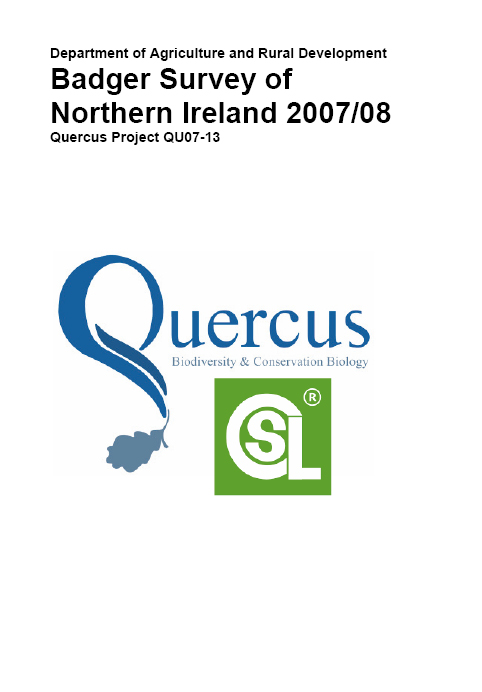
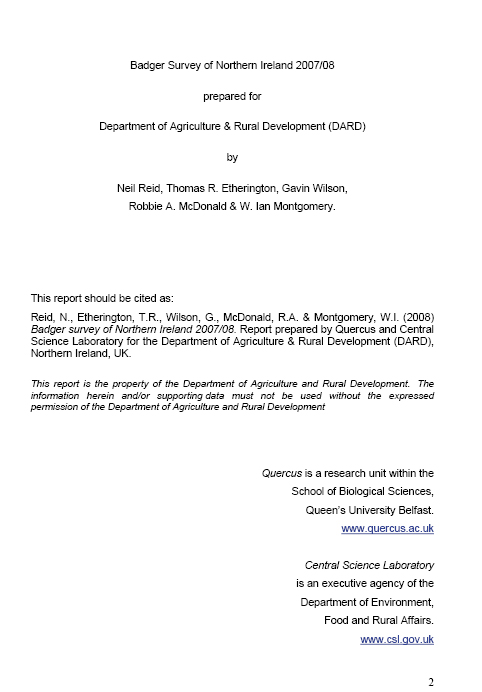
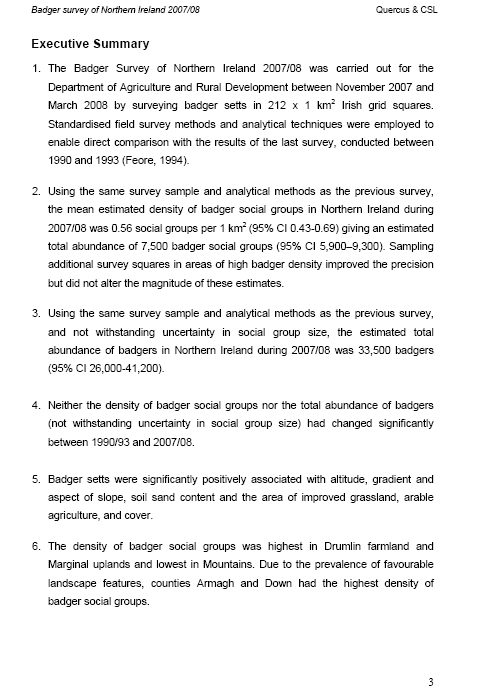

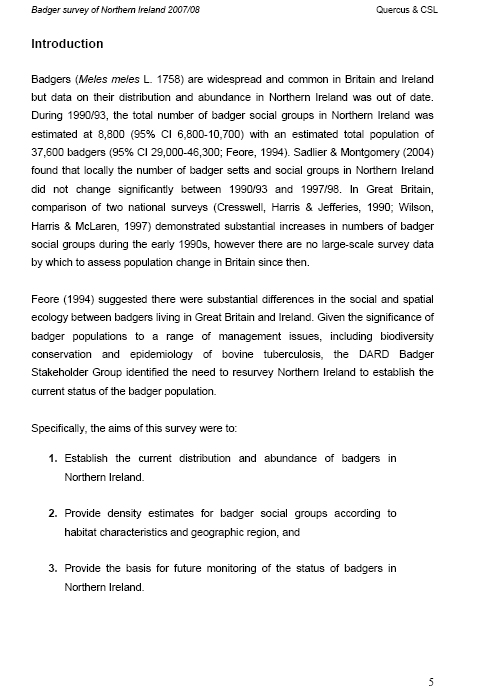
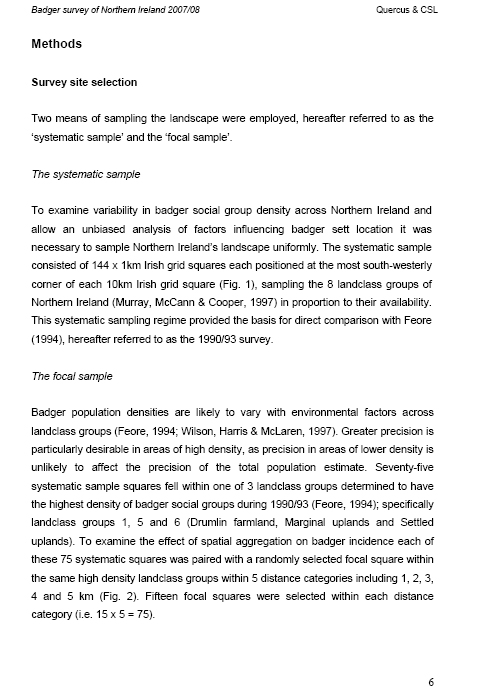
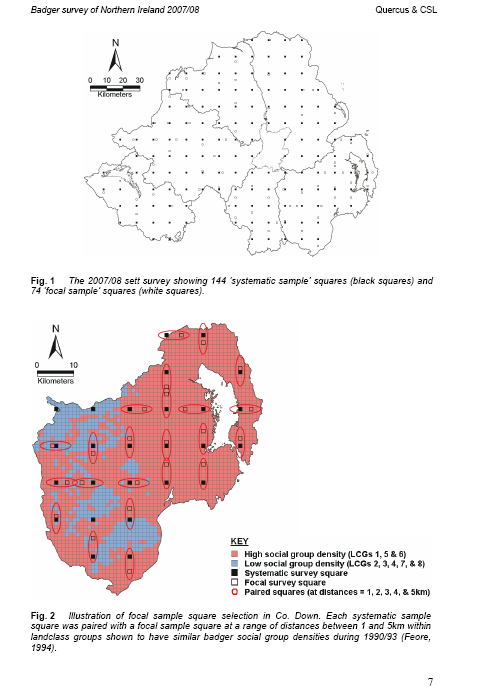
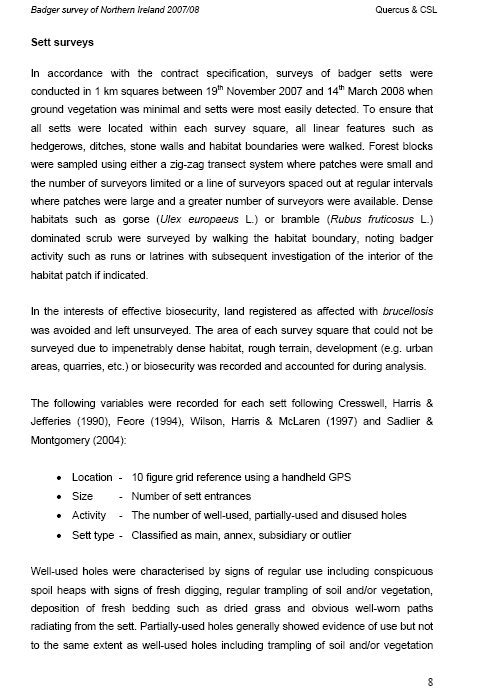
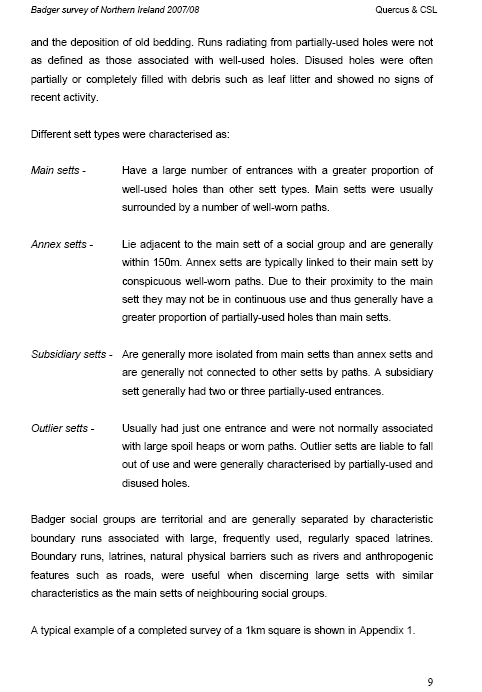







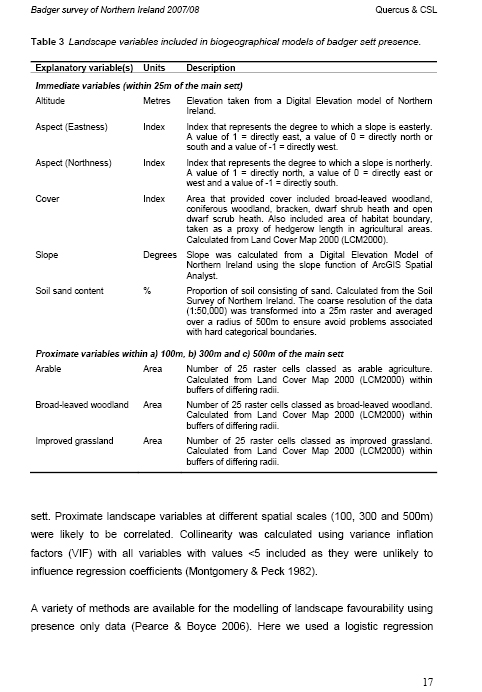
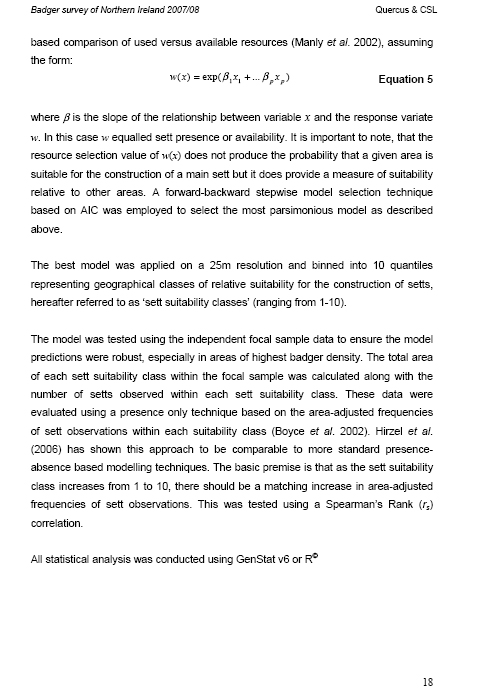
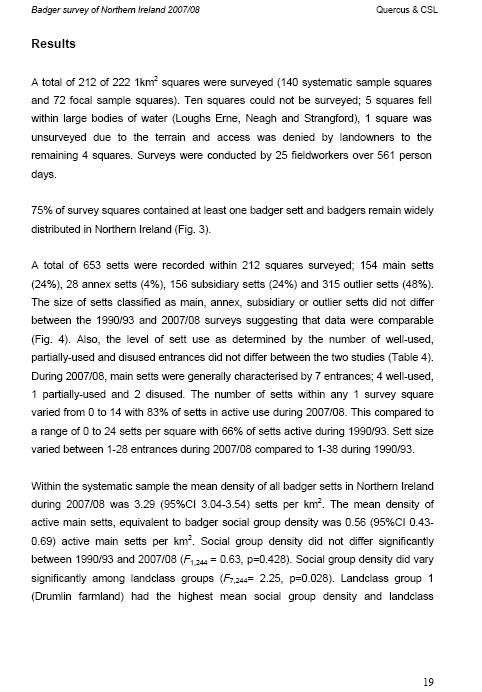
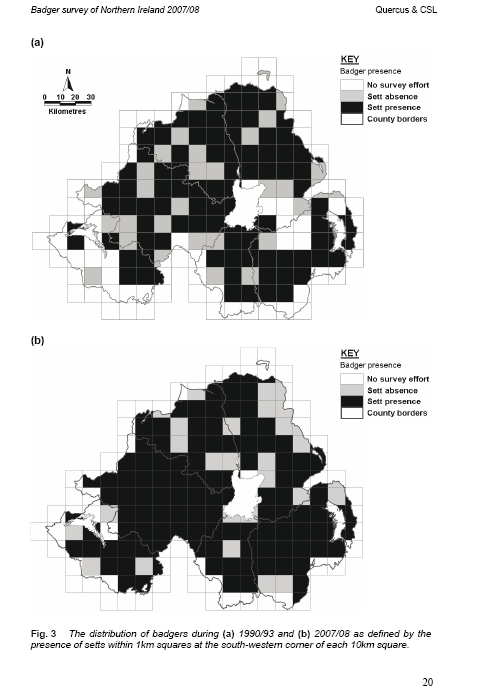
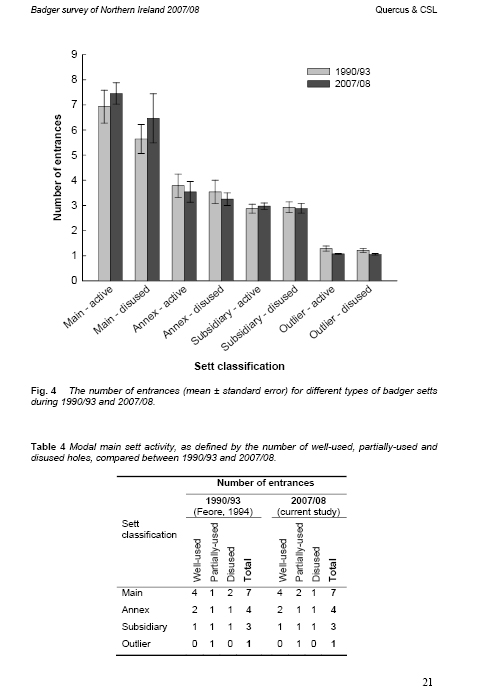
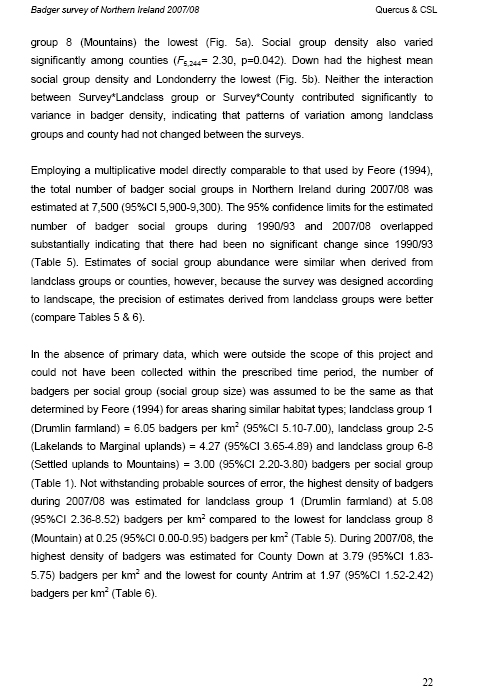

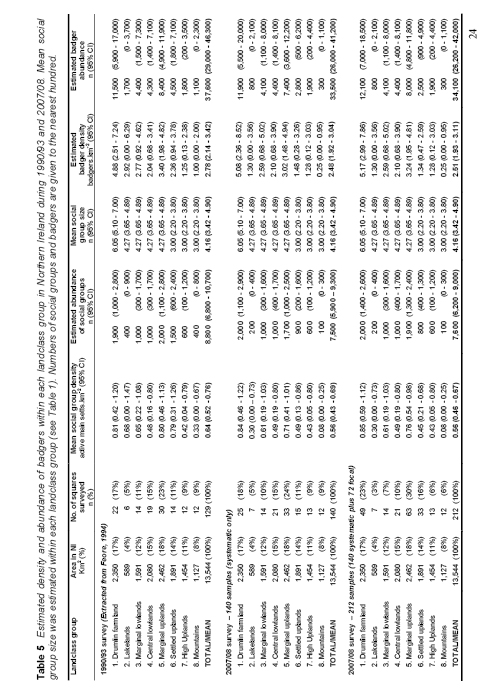
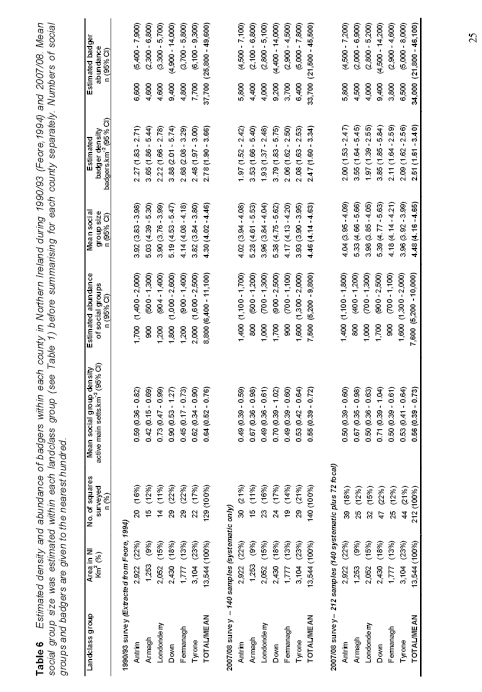

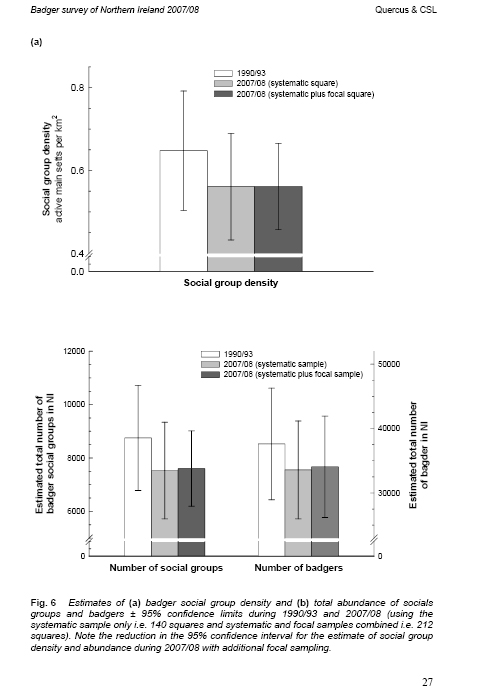
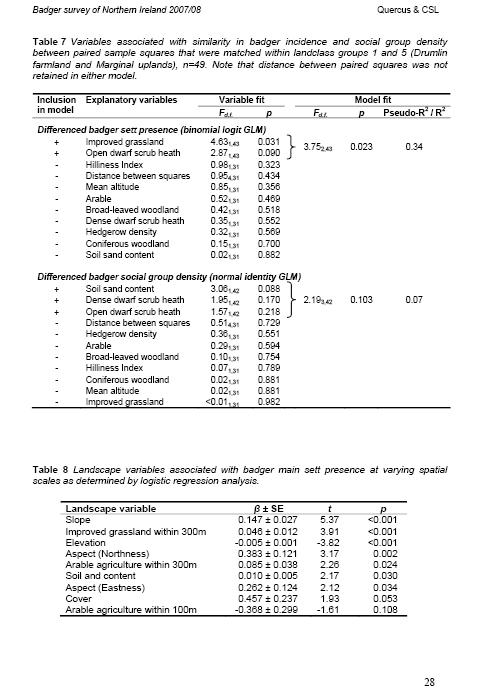
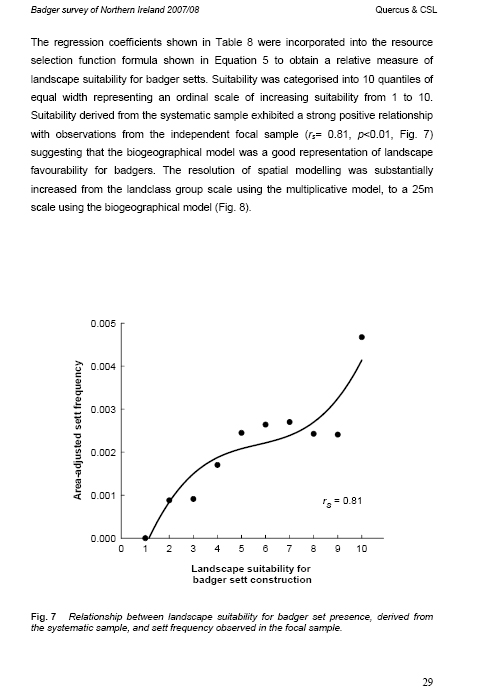




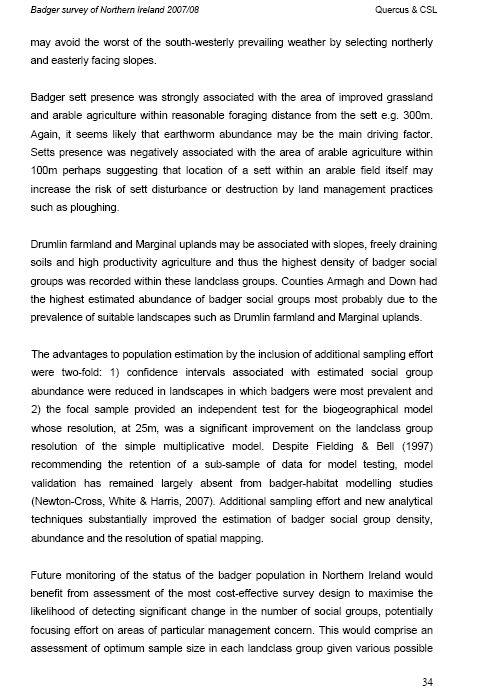

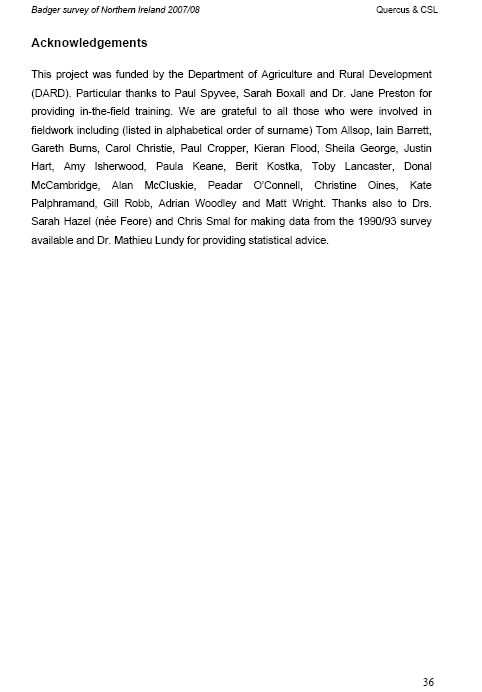
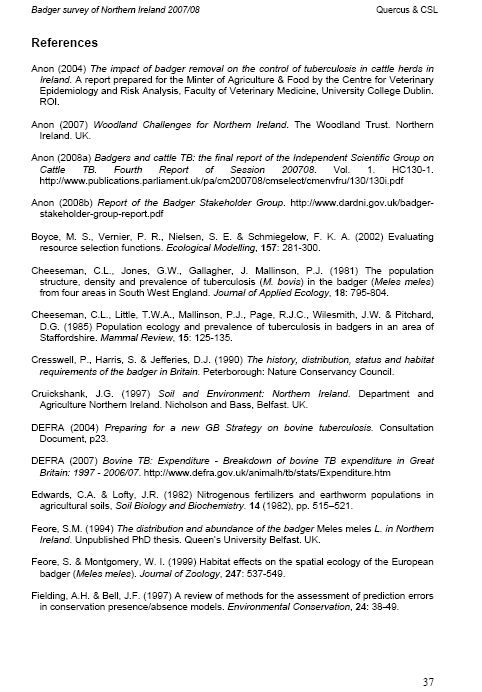
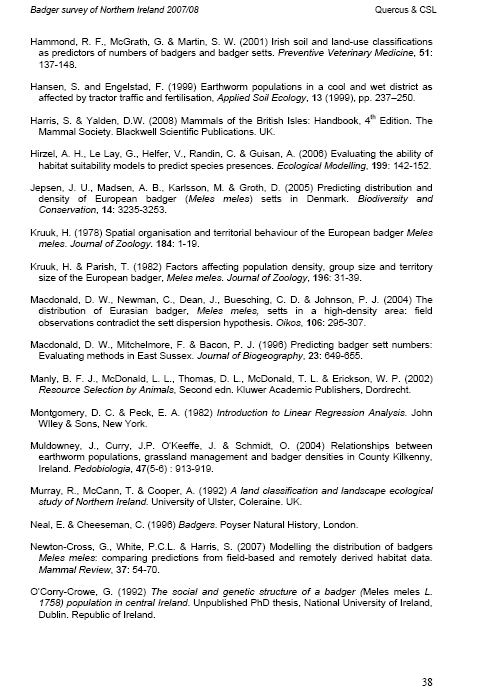
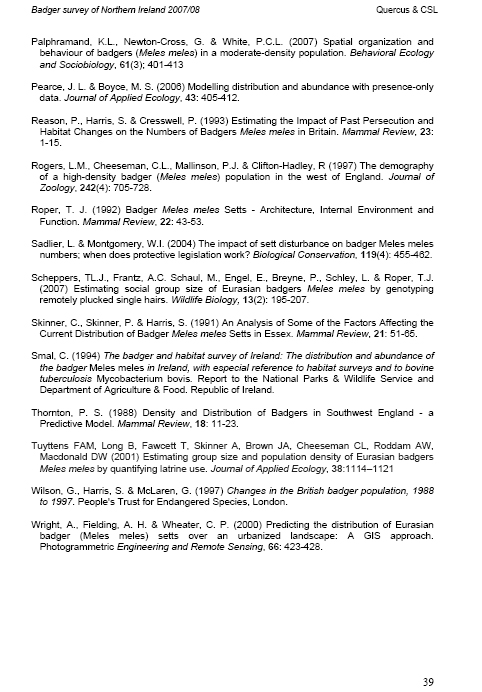
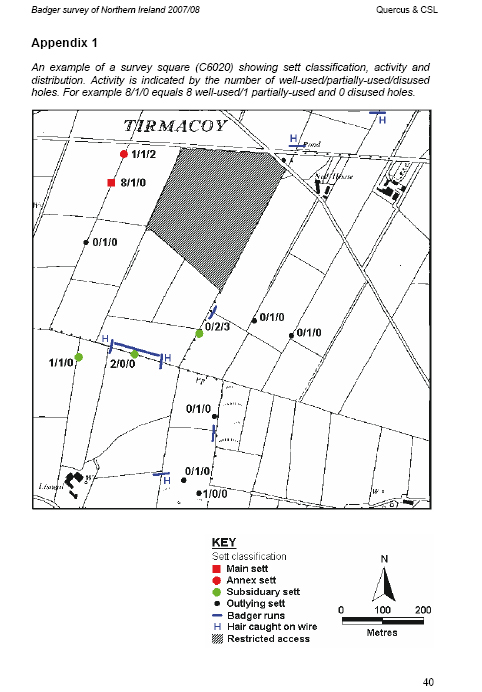
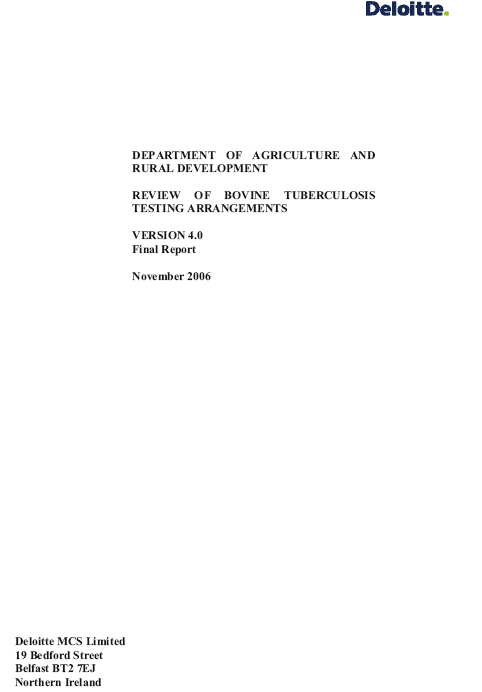
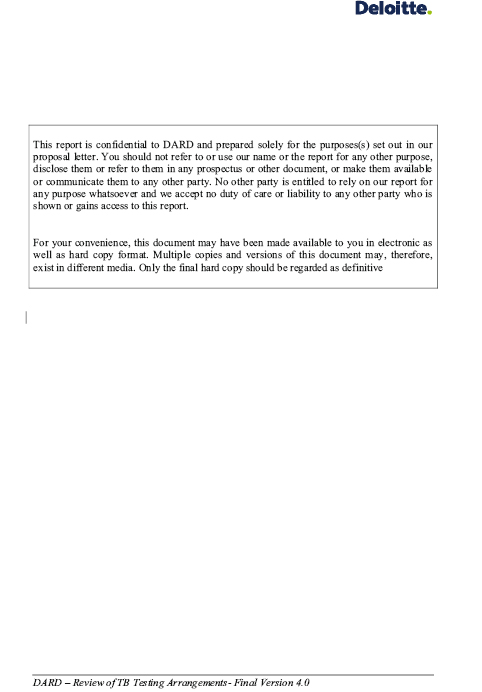
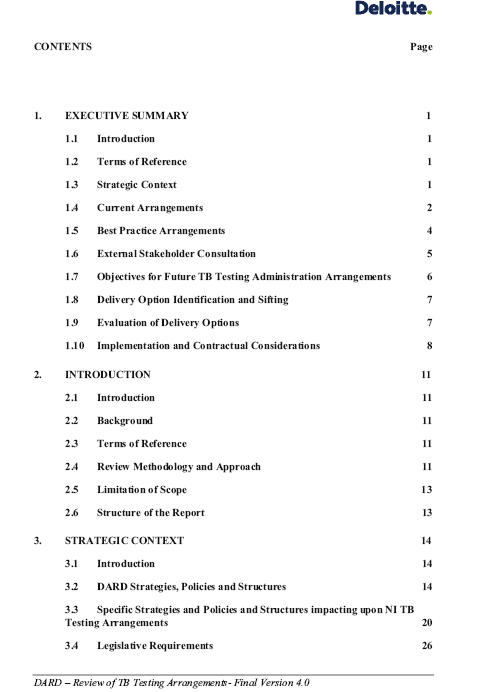

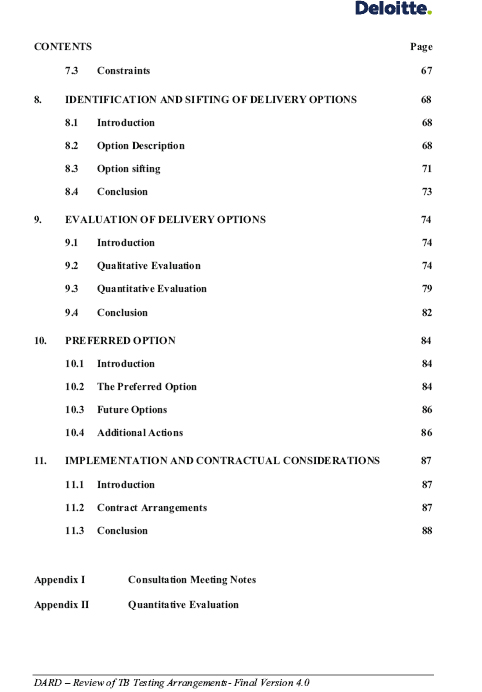
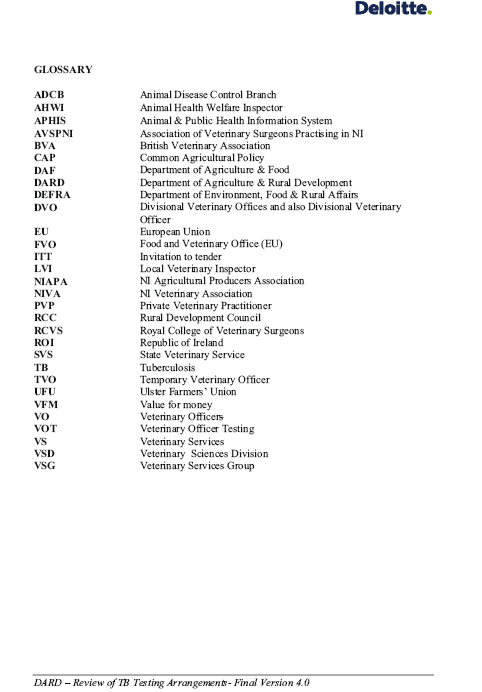
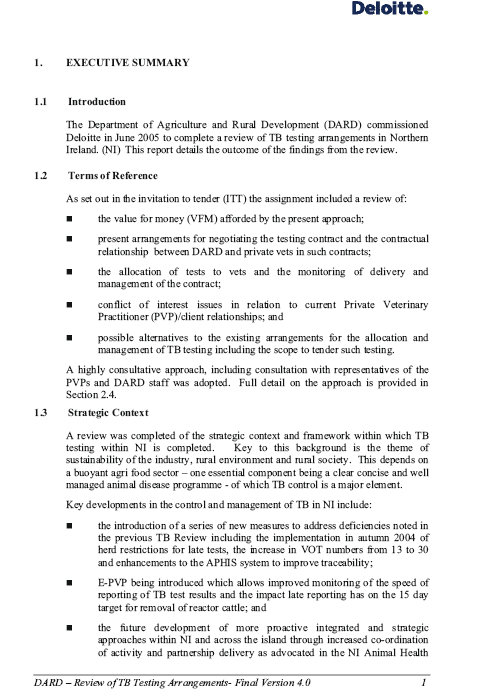
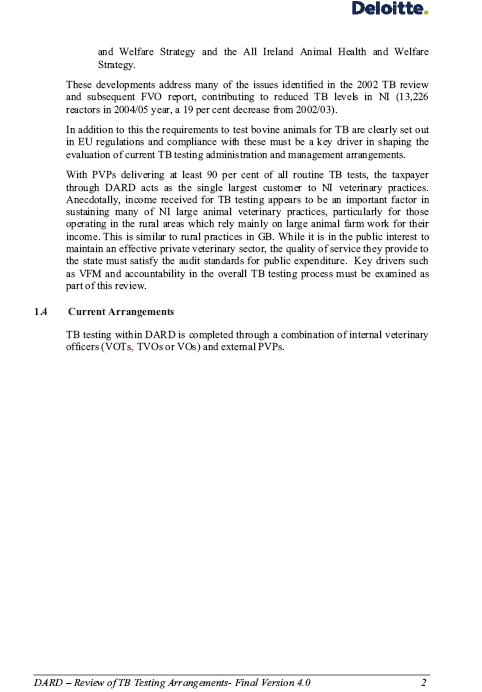



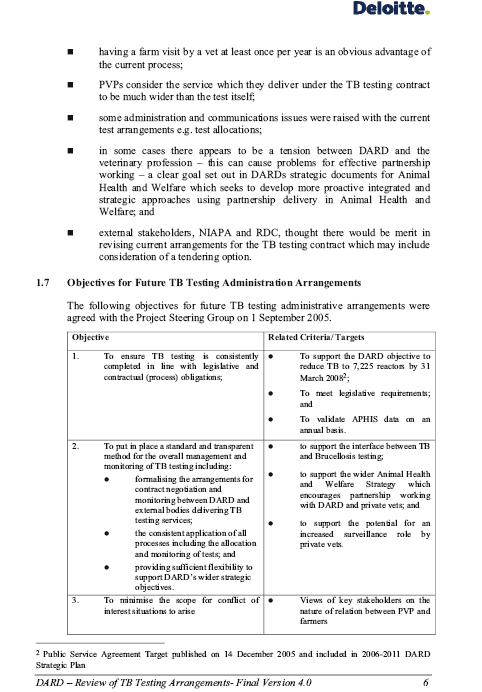
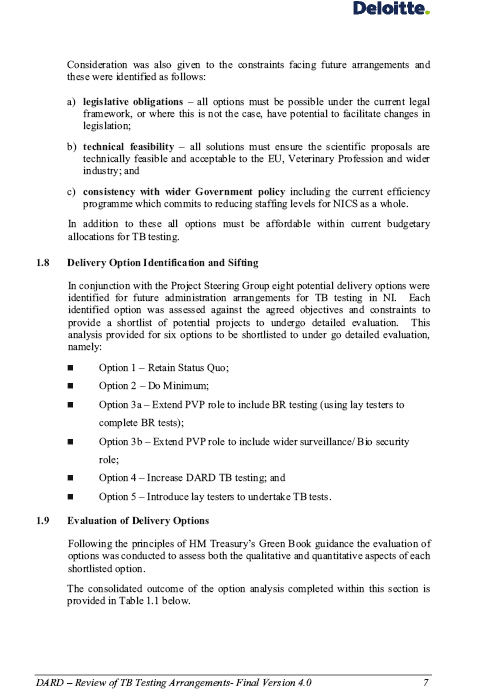
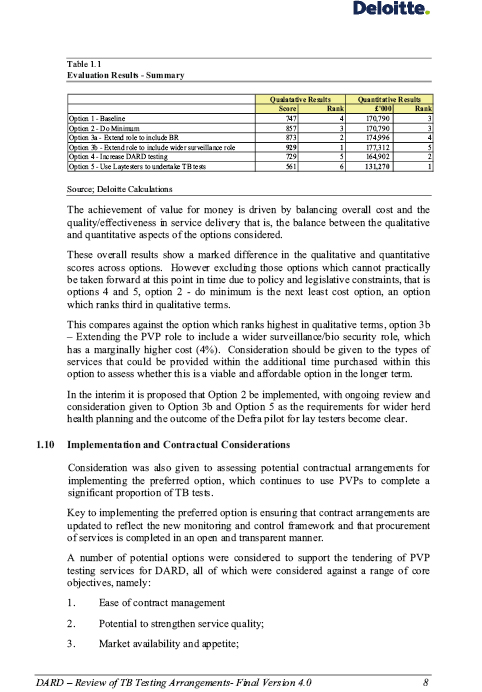
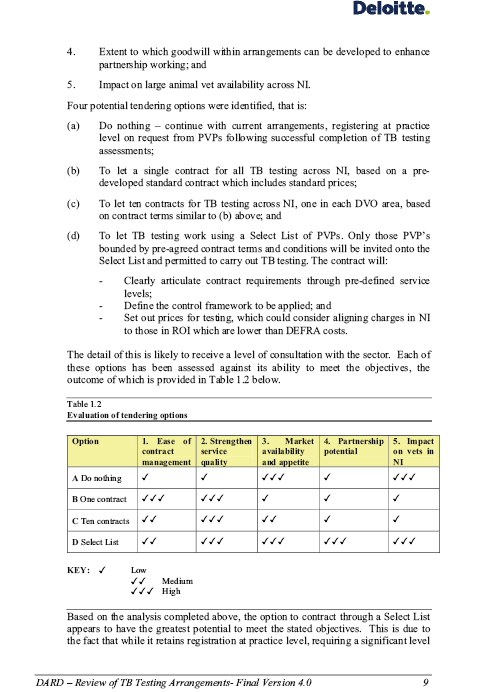

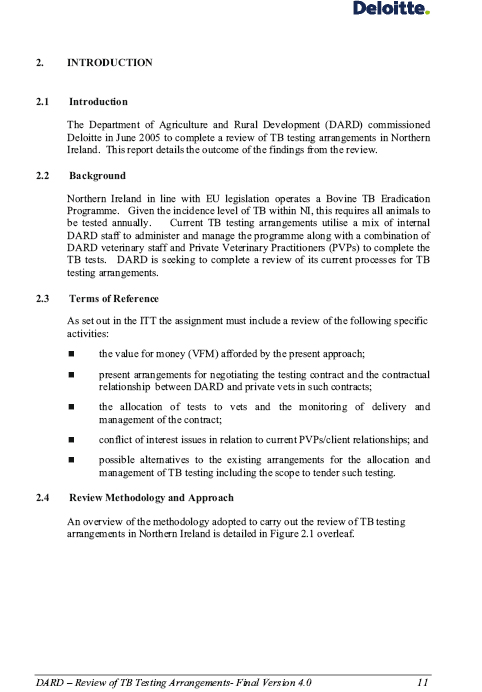
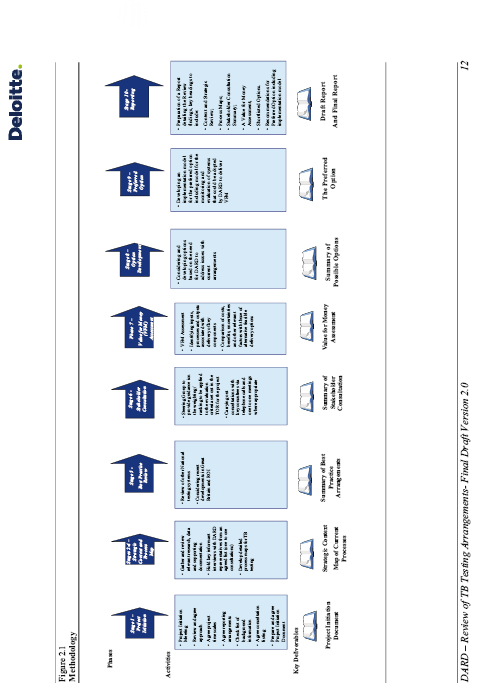
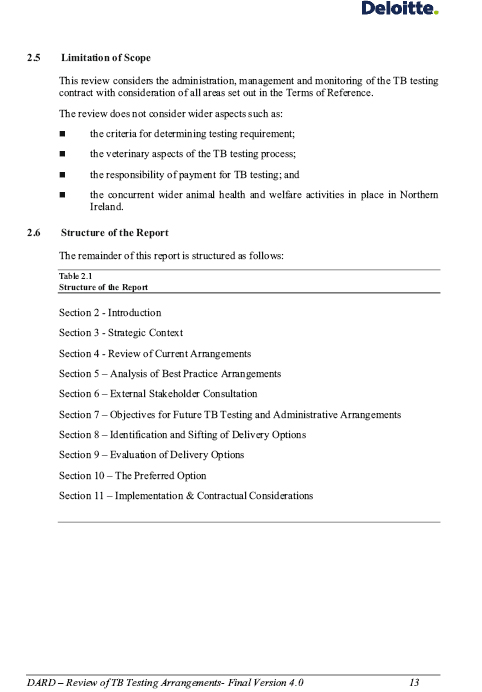


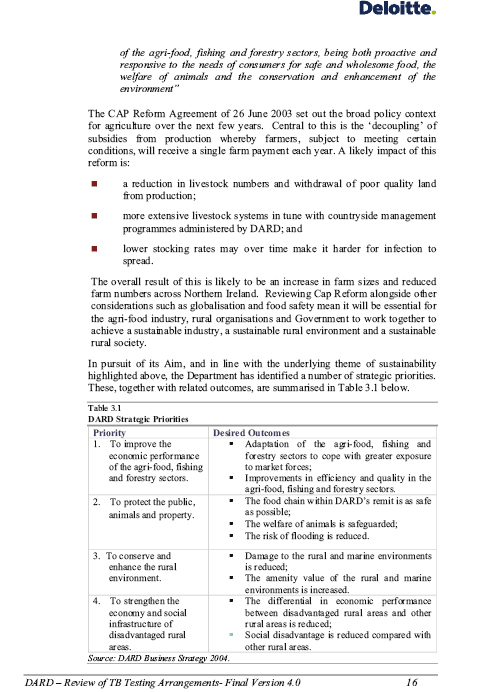
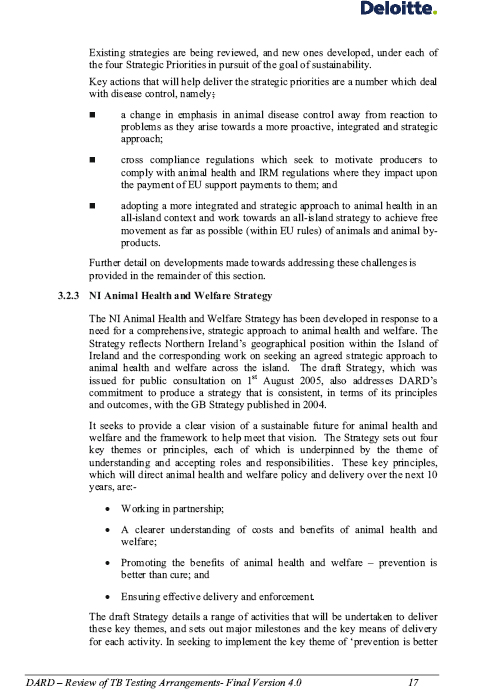
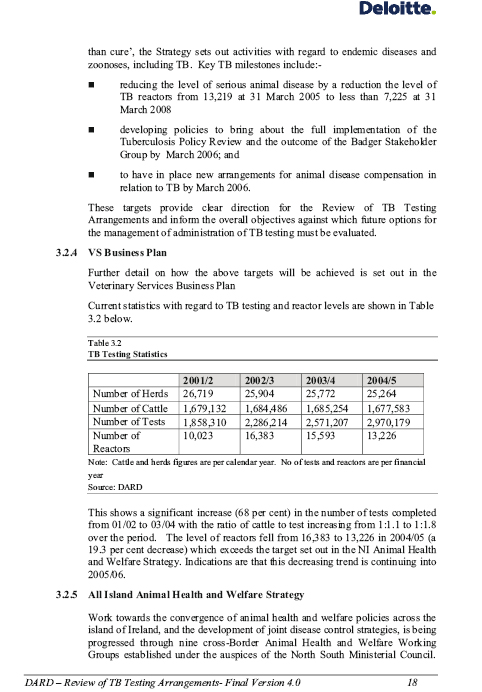





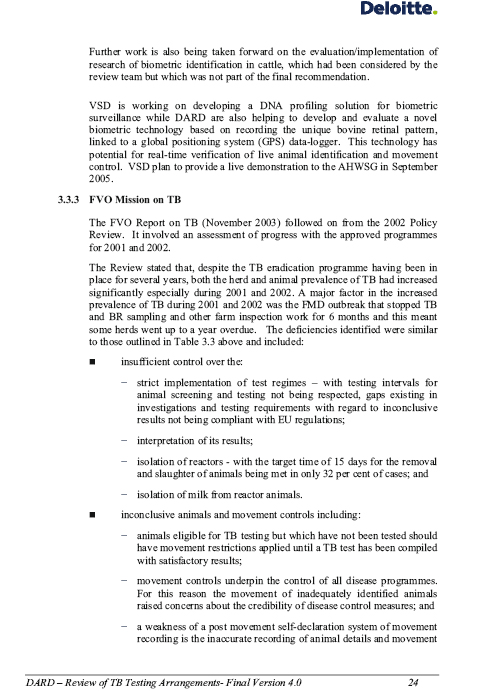

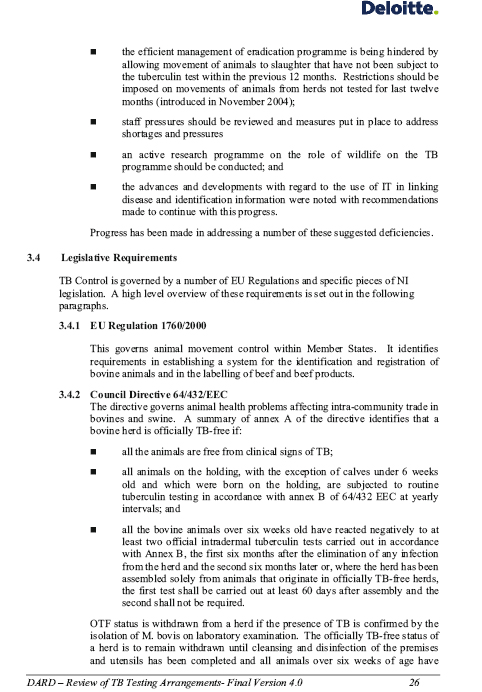
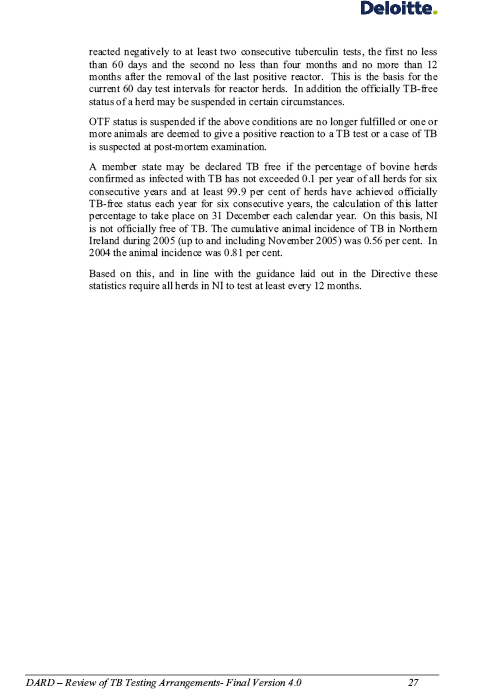

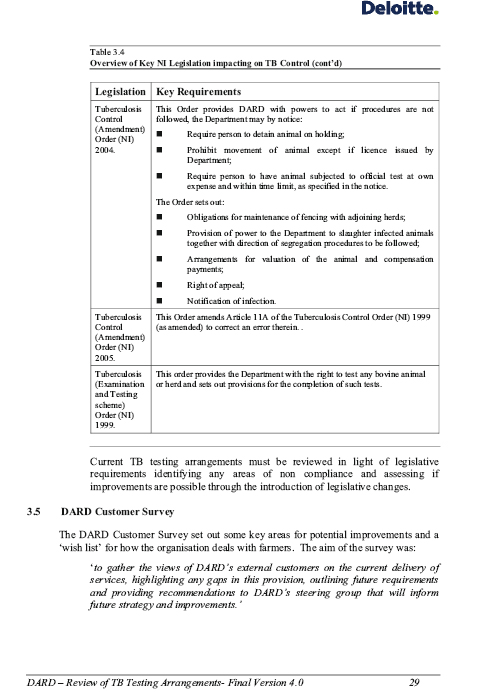
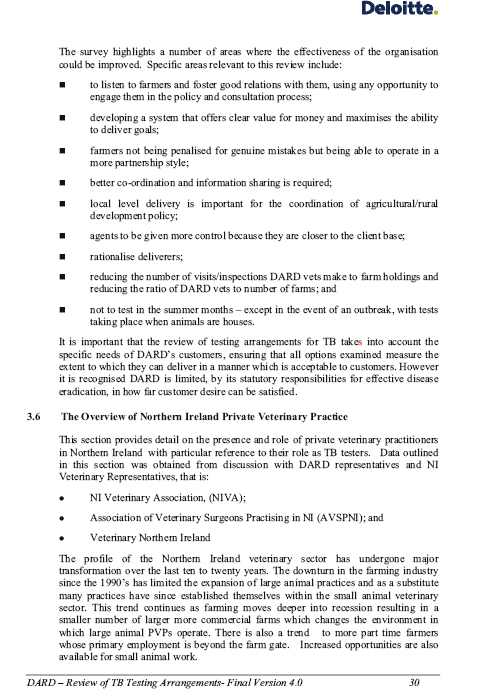

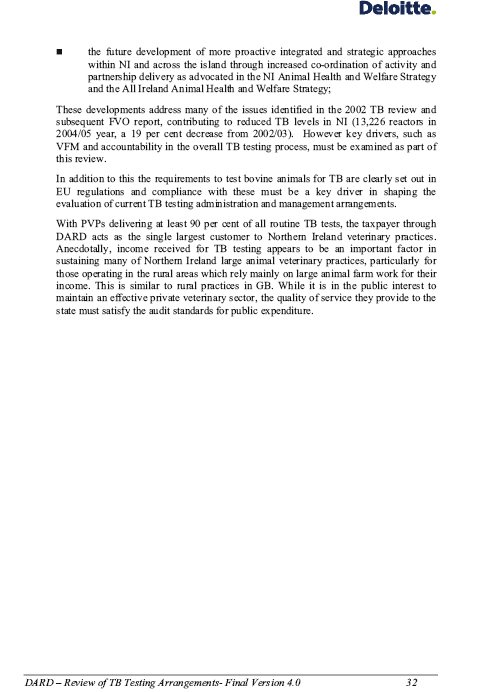

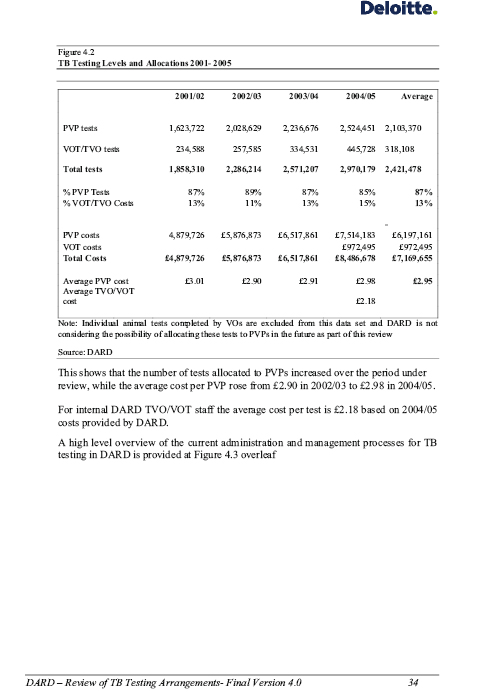

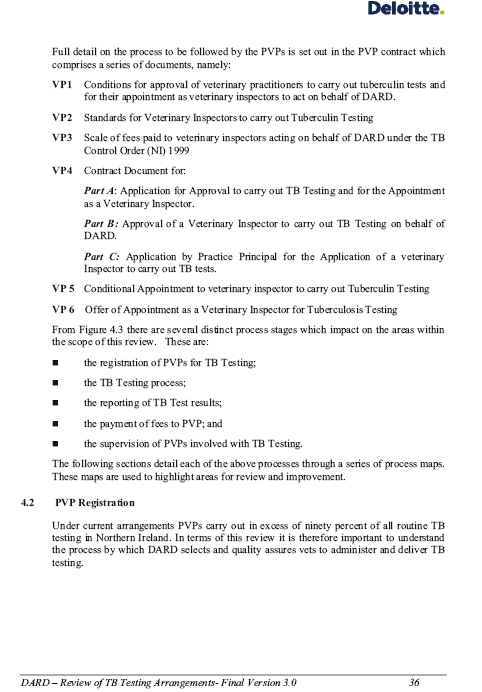
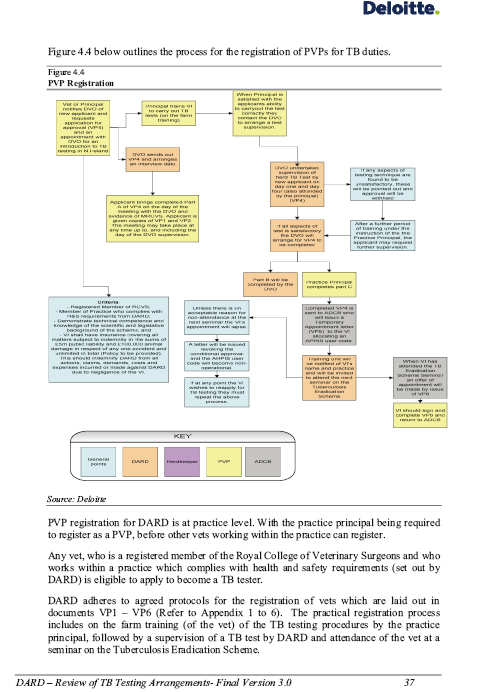
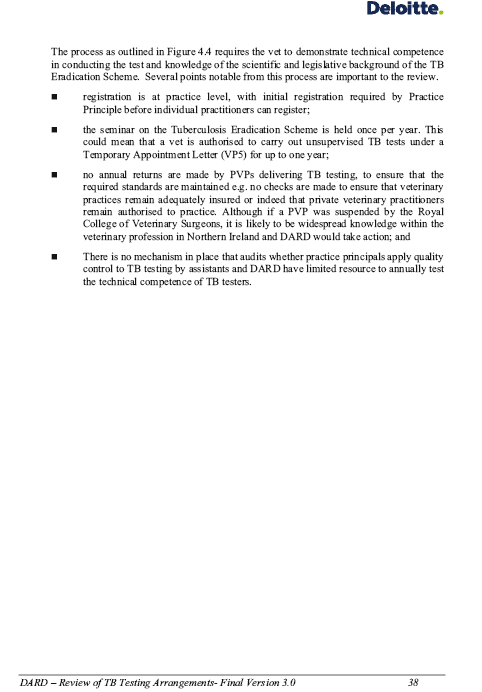
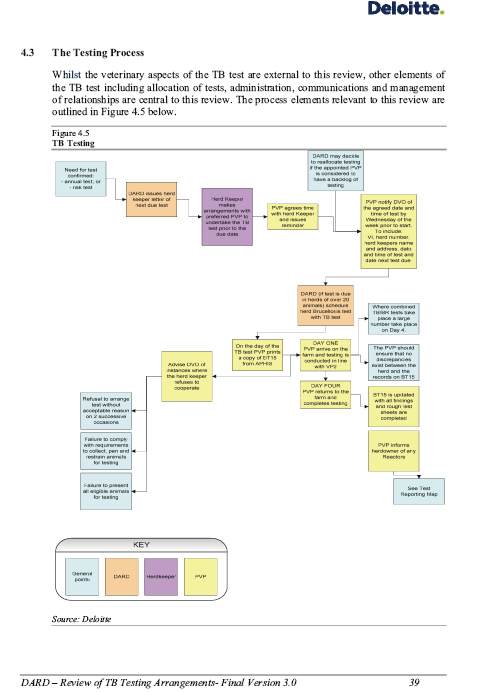


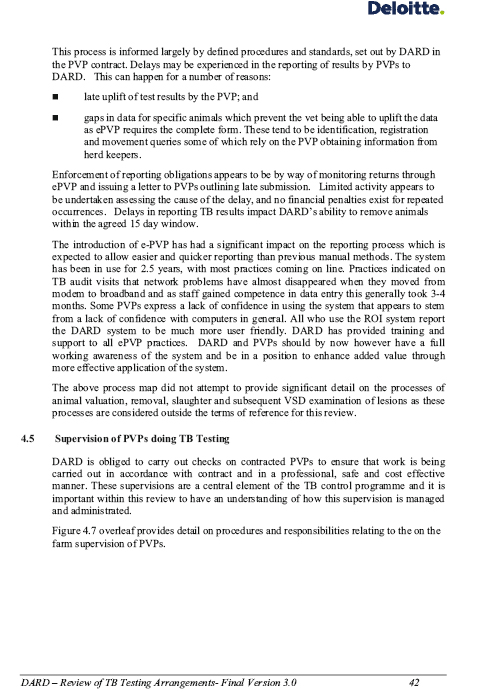
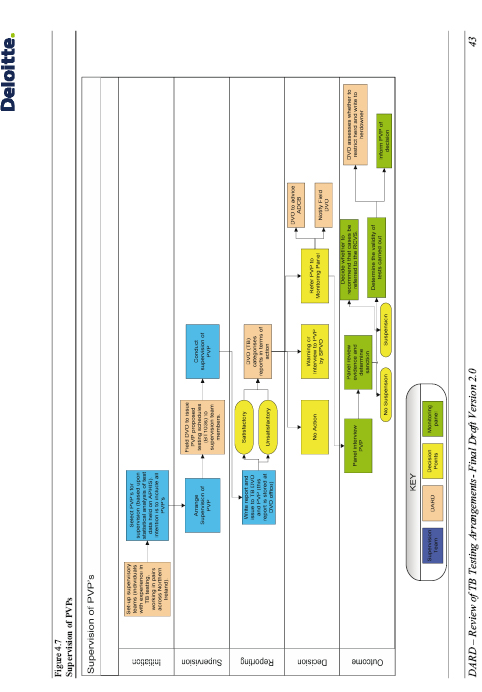

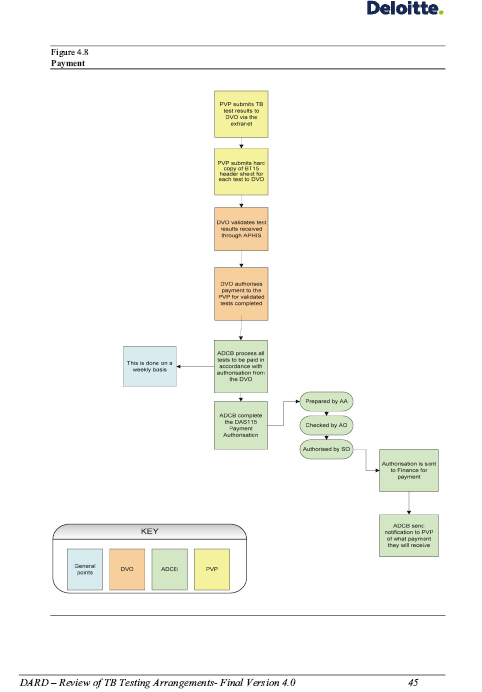
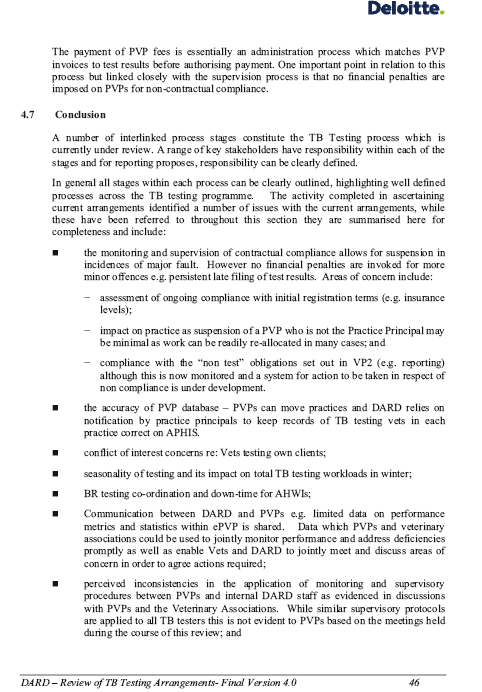
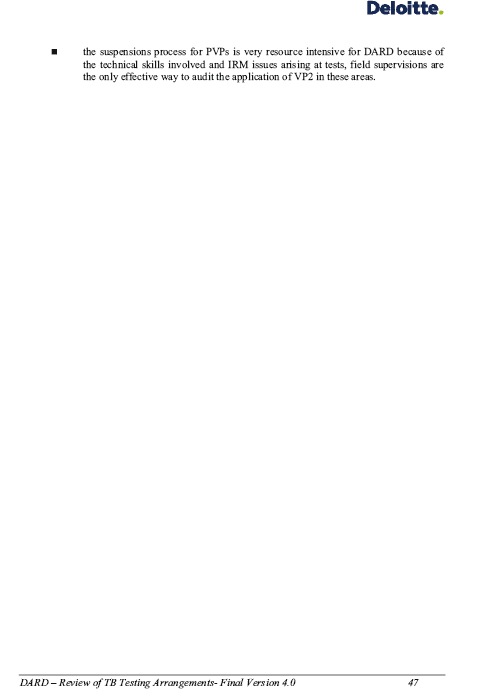



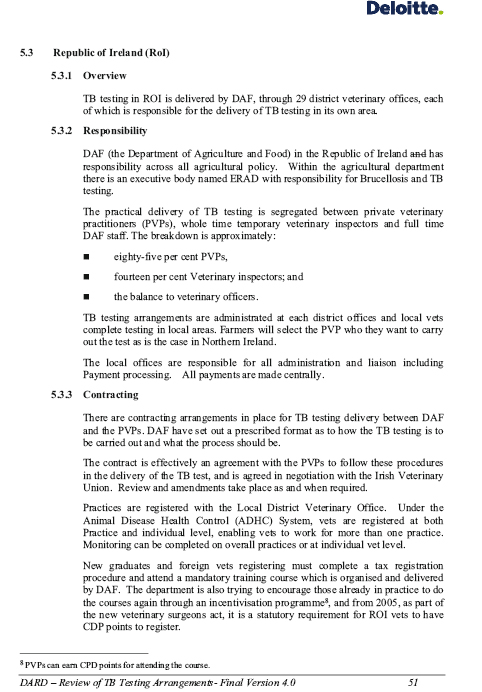
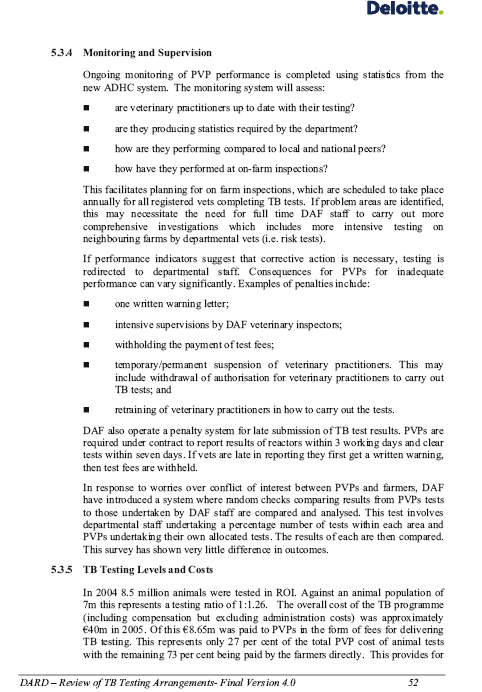
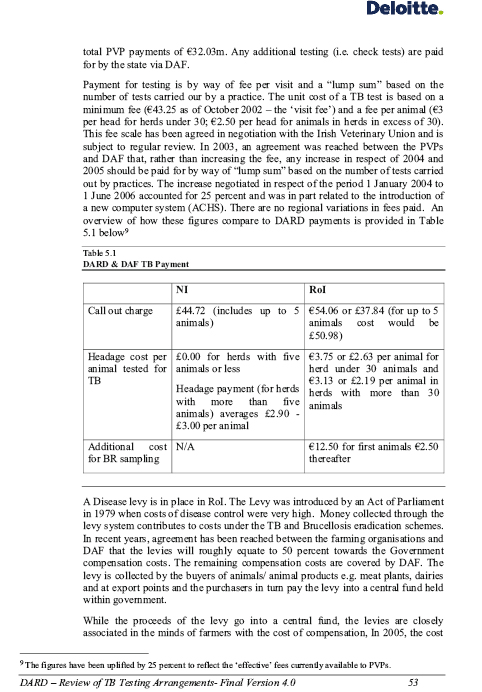
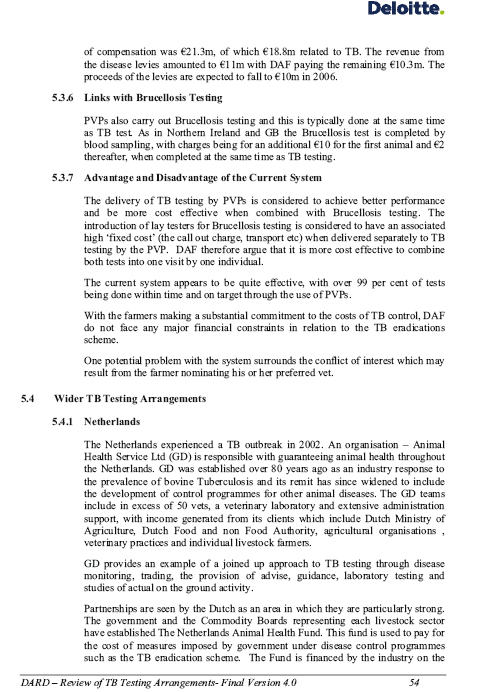

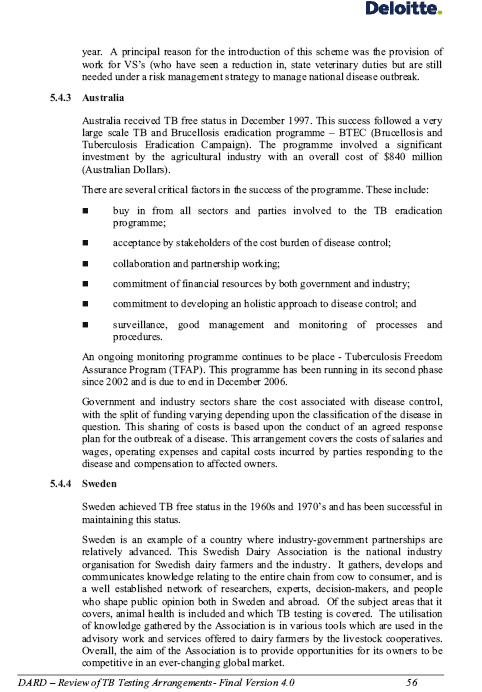
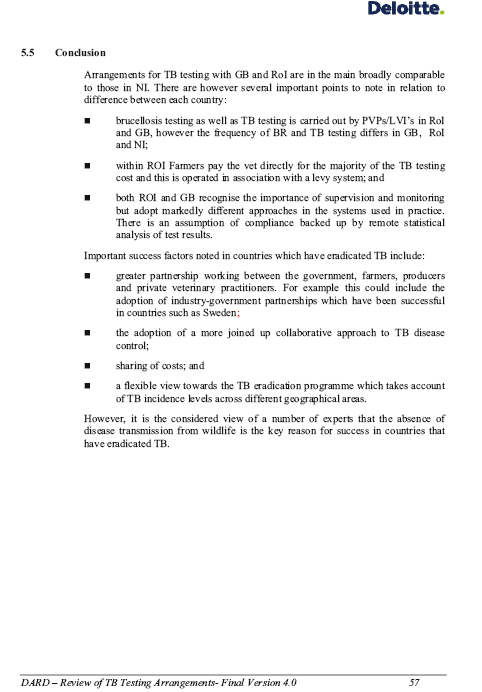
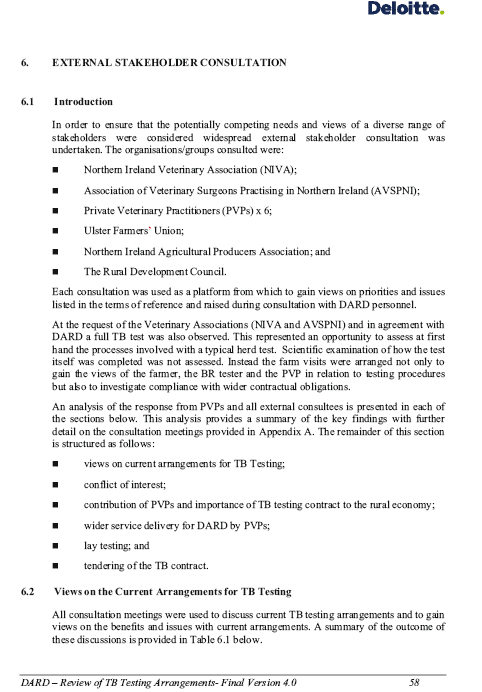
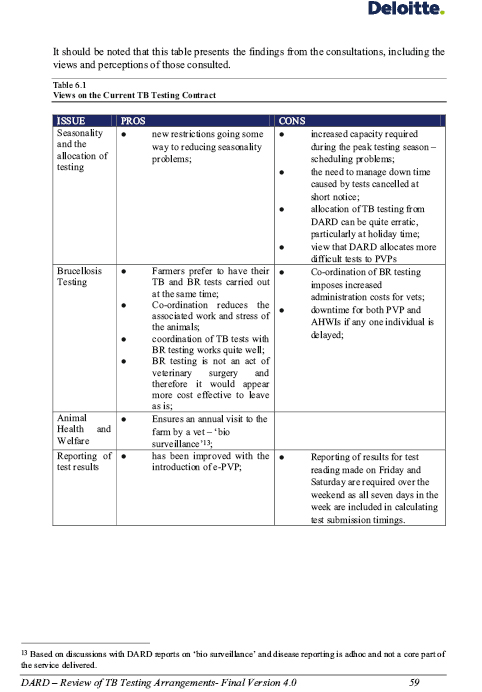
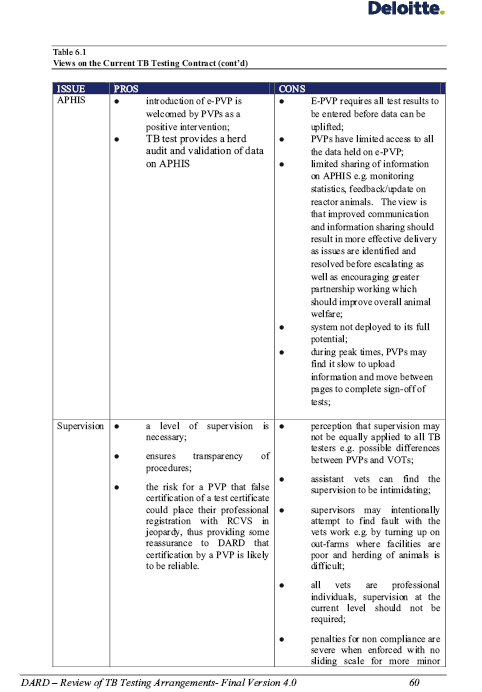
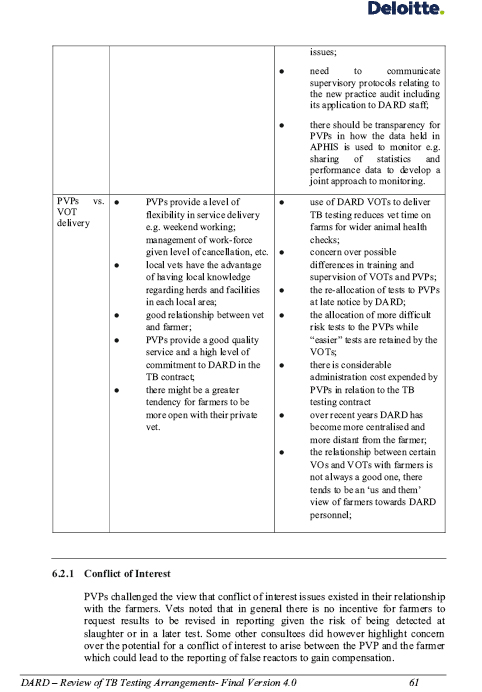






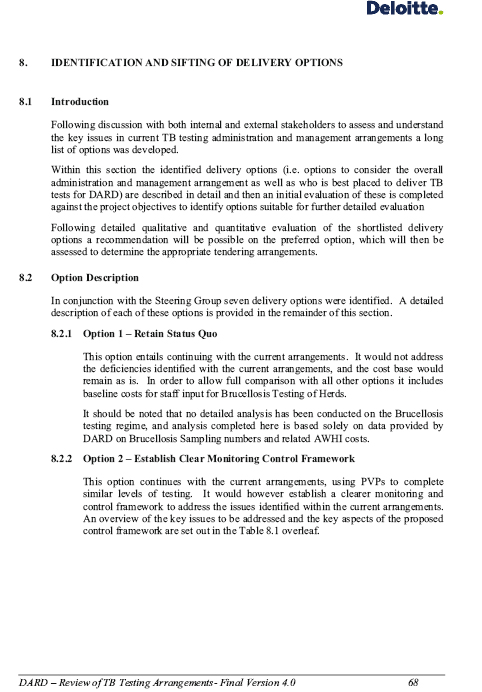
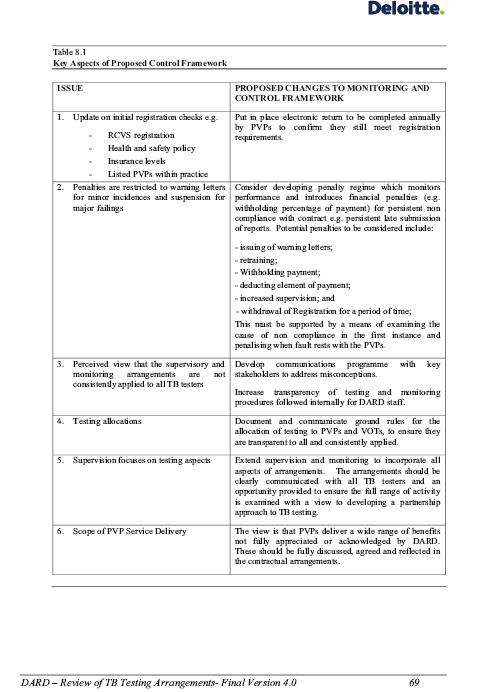
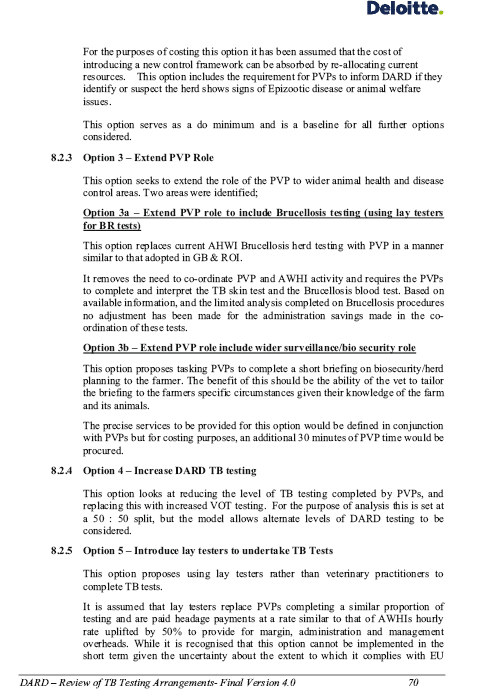
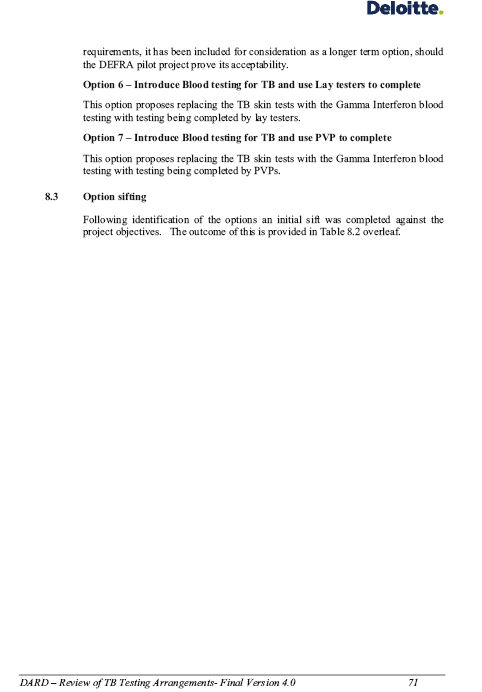
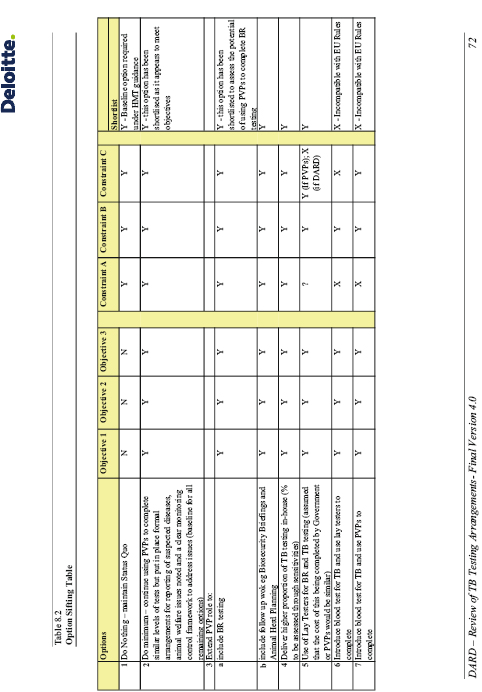
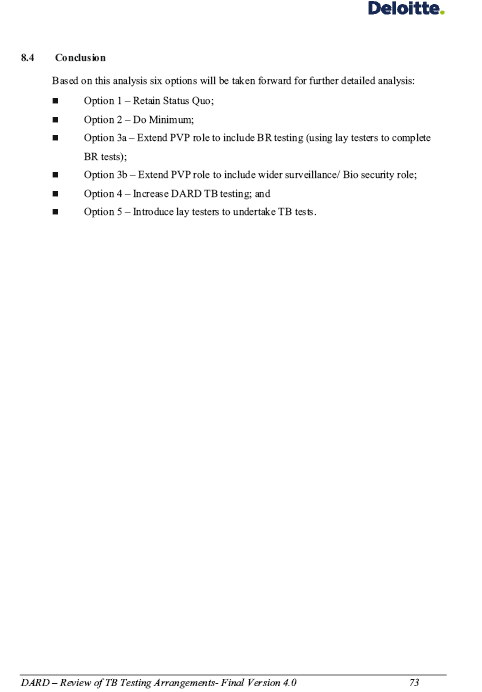
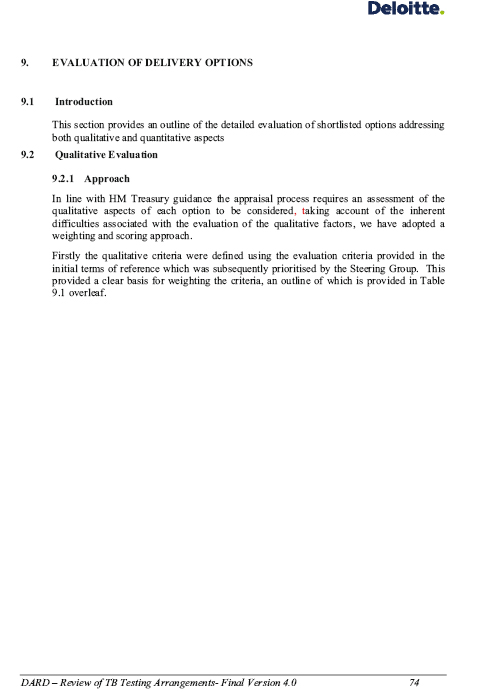

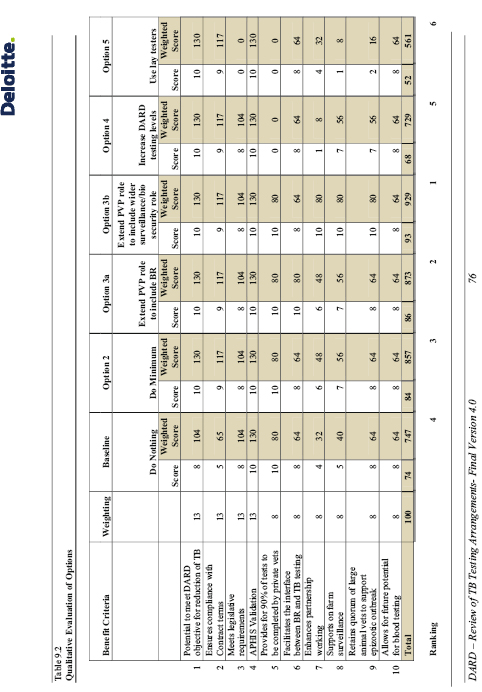
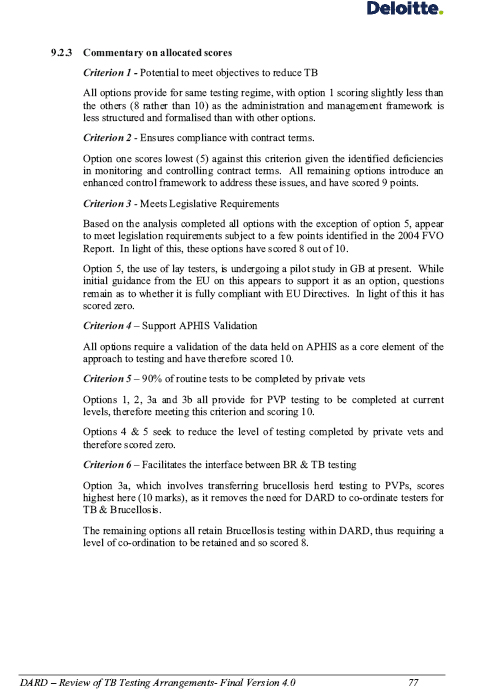
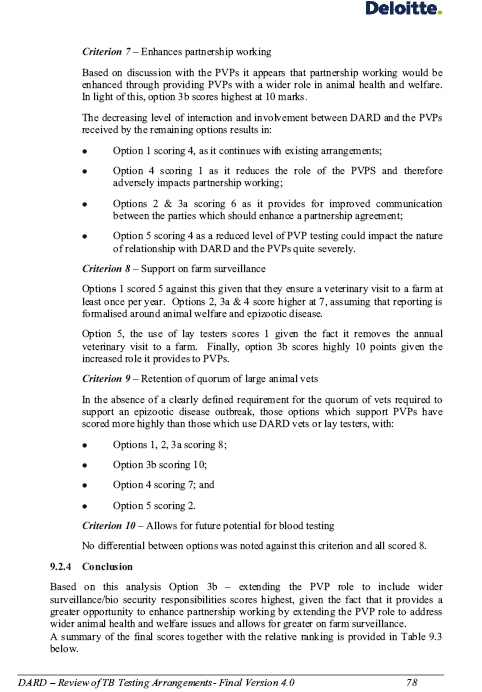

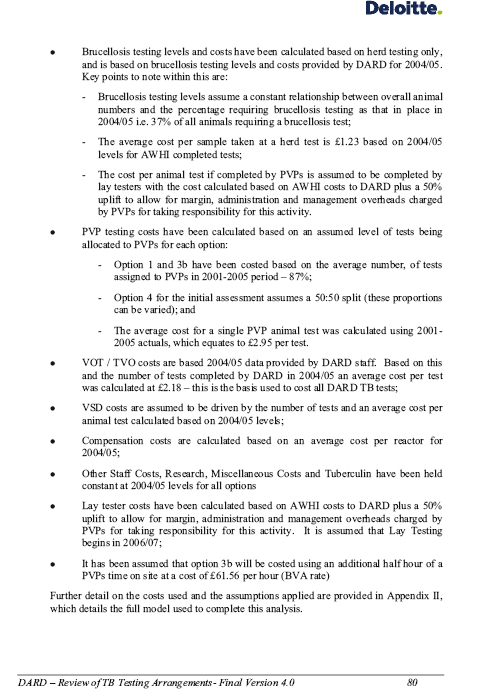


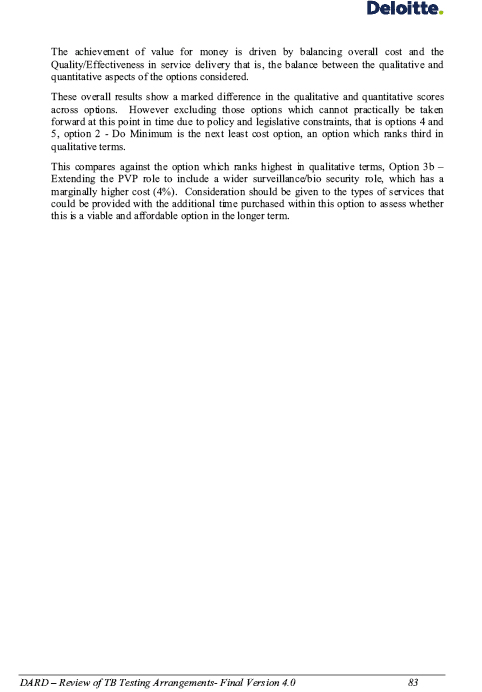
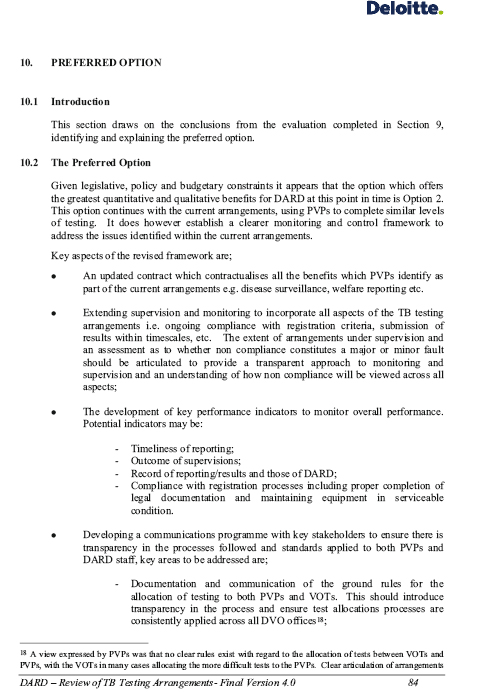
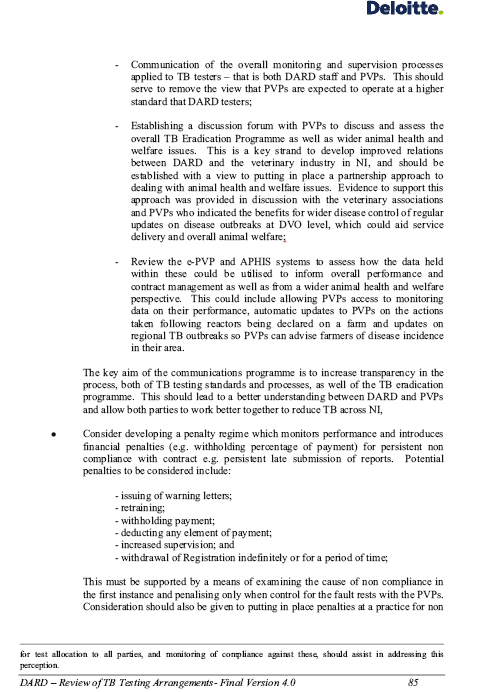

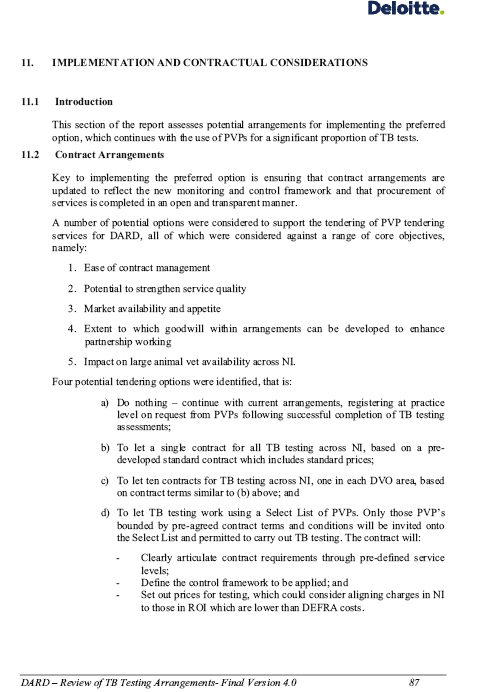
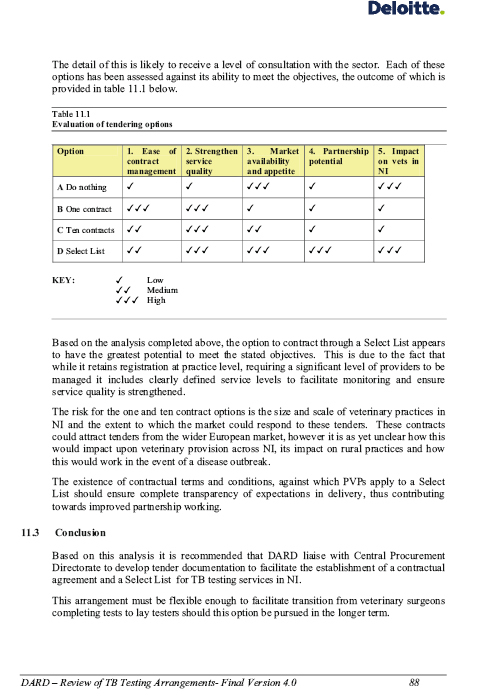
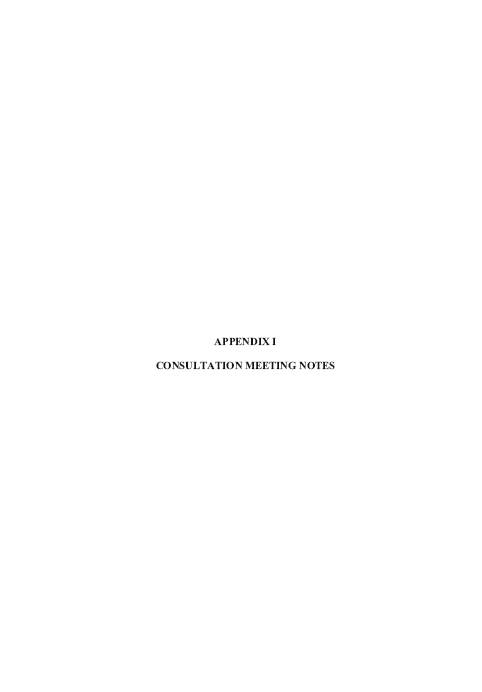
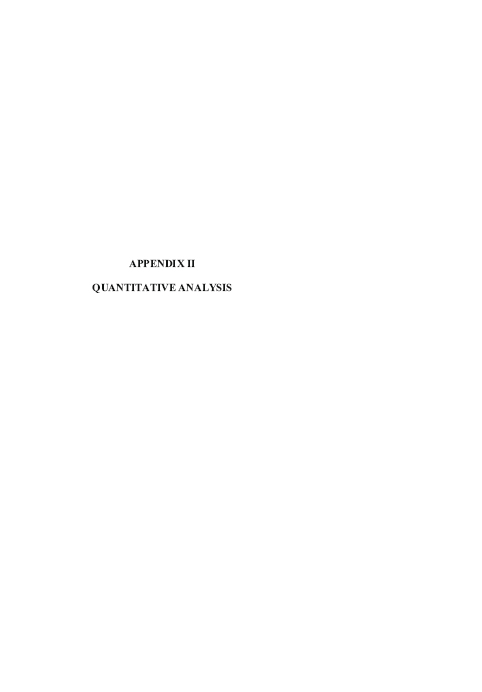


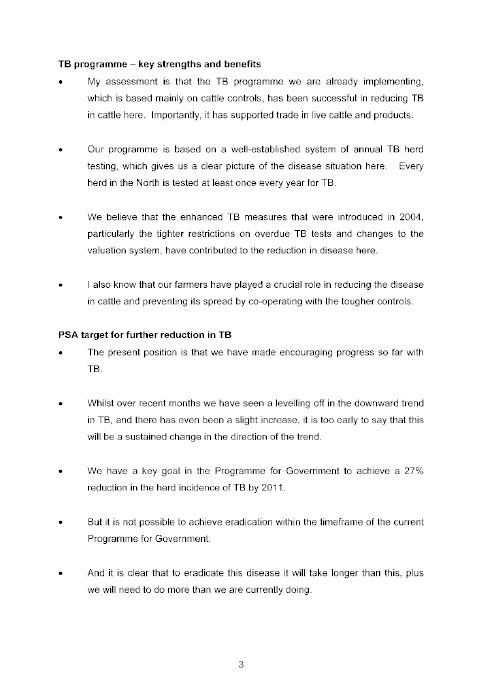
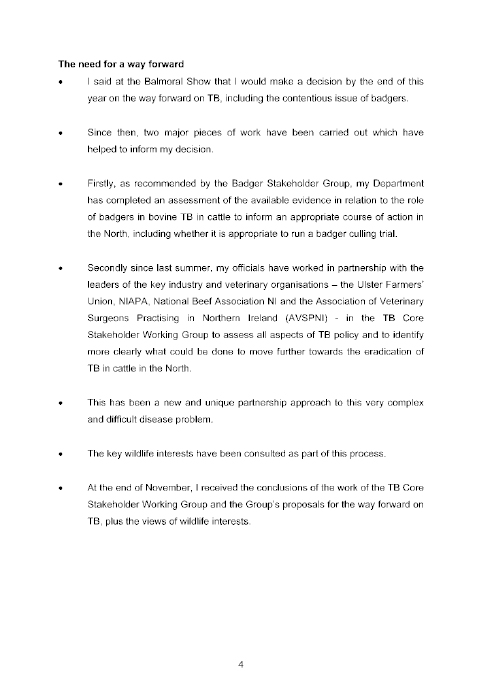


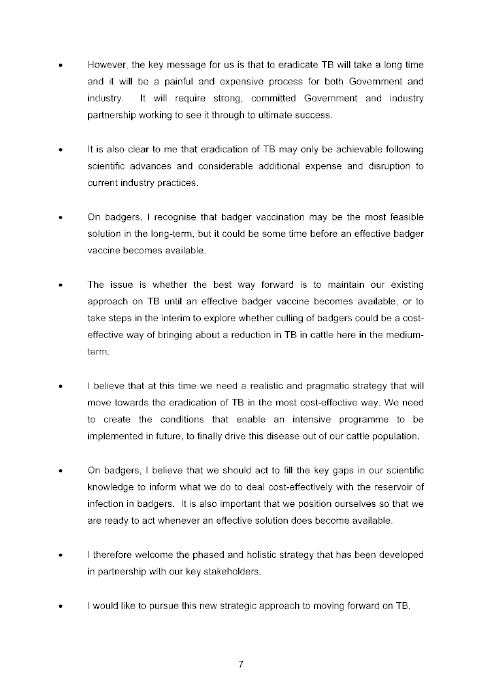

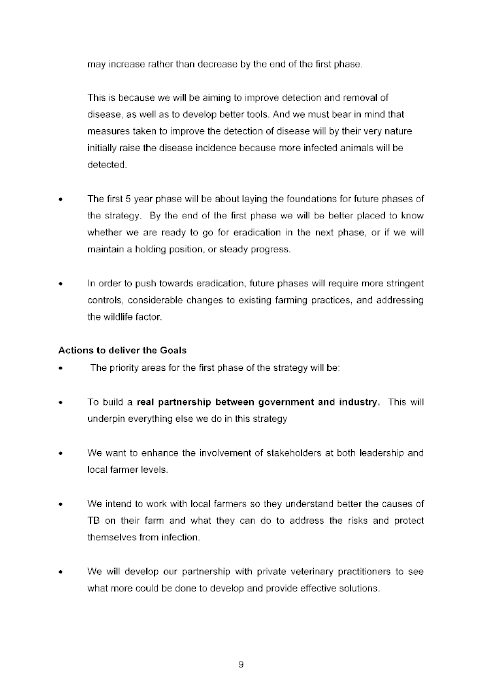
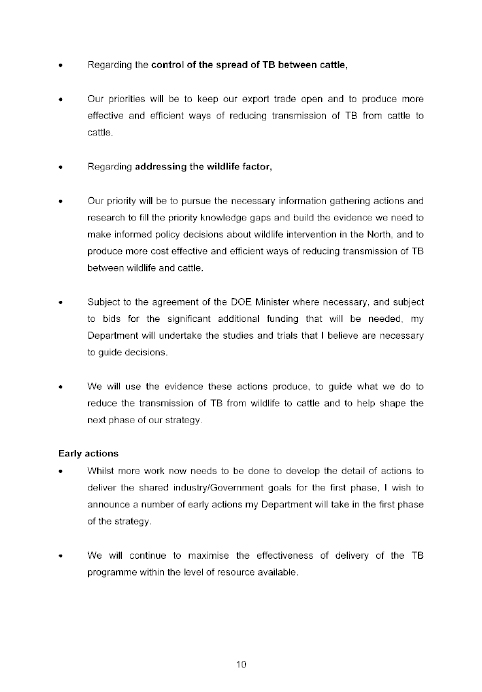

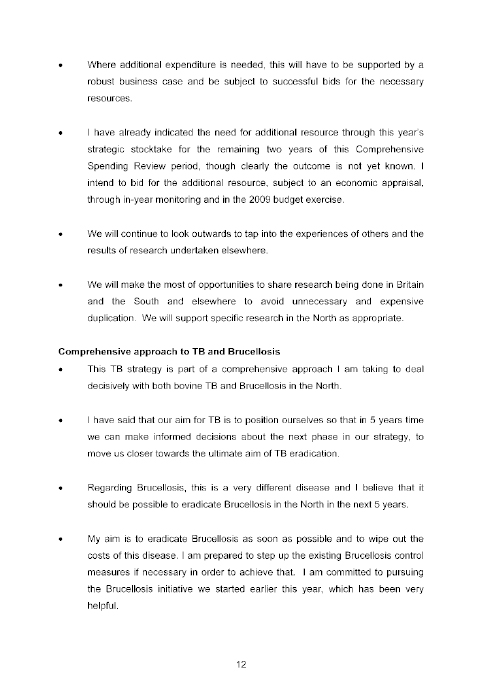
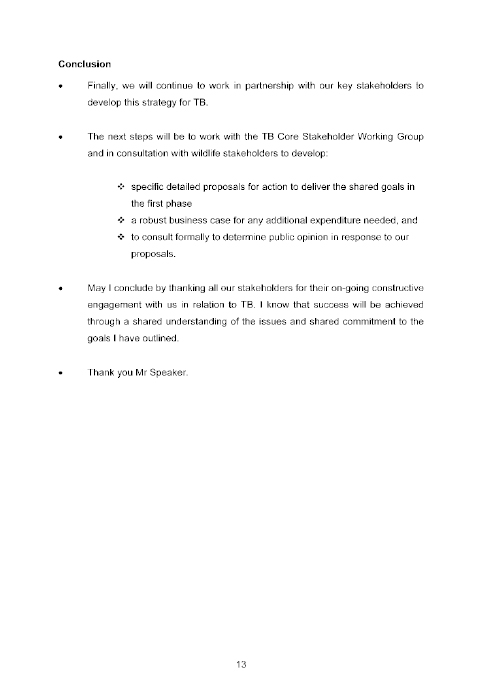
Chairperson’s Letter of 27 March 2009
to Mr David Thomson
Northern Ireland
Assembly
Public Accounts Committee
Parliament Buildings
Room 371
Stormont Estate
BELFAST
BT4 3XX
Tel: (028) 9052 1208
Fax: (028) 9052 0366
27 March 2009
Mr David Thomson
Treasury Officer of Accounts
Department of Finance and Personnel
Room P4, 3rd Floor
New Building
Rathgael House
Balloo Road
BANGOR
BT19 7NA
Dear David
Re: Evidence Session On 26 March 2009
Further to the evidence session of the Public Accounts Committee on 26 March, there was one issue which a member wished to raise.
DARD has made only one successful claim from the EC Veterinary Fund in the last six years, resulting in millions of pounds being lost. The Department’s explanation that receipts from the Fund go to the Exchequer and are of no direct benefit to the Department, seems to ignore the benefits for the taxpayers. I would appreciate your comments on this issue, and whether there are steps which can be taken to ensure DARD takes full advantage of the funding available from the Fund.
I should appreciate a reply by 17 April 2009.
Yours sincerely

Paul Maskey
Chairperson
Public Accounts Committee
Correspondence of 8 April 2009
from Mr David Thomson
Treasury Officer of Accounts
David Thomson
Central Finance Group
Rathgael House
Balloo Road
BANGOR BT19 7NA
Tel No: 028 9185 8150 (x 68150)
Fax No: 028 9185 8175
email: david.thomson@dfpni.gov.uk
and jill.downie@dfpni.gov.uk
Paul Maskey
Chairperson
Public Accounts Committee
Parliament Buildings
Room 371
Stormont Estate
BELFAST BT4 3XX
8 April 2009
Dear Paul
Bovine TB – Evidence Session 26 March
Thank you for your letter of 28 March in which you asked for DFP’s views on a comment attributed to DARD about possible funds from Europe not benefitting the department.
Managing Public Money places a responsibility on accounting officers to consider value for money “judged for the public sector as a whole, not just for the accounting officer’s organisation". DFP would expect that departments should pursue external funds if it would be cost effective for the taxpayer to do so, even if they might not directly benefit their own organisation. The Committee may wish to note that the budgeting rules changed a few years ago so that any such funding received from Europe would directly benefit the NI budget (the allocation of such receipts would be a matter for the Executive).
I understand from DARD that, despite this comment having been recorded in the NIAO report, the reason that a claim has not been submitted in respect of the TB programme since 2005 is because of an issue concerning compliance with the EU rules, specifically as regards the handling of second time in-conclusive animals.
In rejecting the NI TB application for 2005, the Commission did not accept that the NI TB programme was in compliance with the EU rules. Whilst the EU Directive requirement is that animals should be removed as TB reactors after one retest, the Northern Ireland practice is to remove animals as TB reactors after two retests.
DARD’s assessment has been that the benefits of implementing this Directive requirement would not outweigh the costs in financial terms. In 2005, DARD estimated that the cost of complying with this requirement would have been some additional £3.6m each year. Given that the benefits of removing these animals earlier were estimated at £2.5m, this indicates that the additional cost to the NI TB programme overall would have been around £1.1m.
DARD has advised me that this is the one area where Northern Ireland is non-compliant with the EU Directive requirements in respect of TB, but that it will keep the matter under review in its new TB strategy.
Whilst DARD has made no claim for its TB programme since 2005, it has continued to apply annually for co-funding from the EU Veterinary Fund for other NI disease eradication / monitoring programmes, for example the NI Brucellosis programme, the Bovine Spongiform Encephalopathy (BSE) eradication programme, the Scrapie eradication programme and the Transmissible Spongiform Encephalopathy (TSE) monitoring programme. In 2008, just over £880k was received into the NI budget in respect of the 2007 Brucellosis programme and just over £960k was received into the NI budget in respect of the 2007 BSE, TSE and Scrapie programmes.
Yours sincerely

DAVID THOMSON
Chairperson’s Letter of 6 April to
Chief Executive, Ulster Farmers’ Union
Northern Ireland
Assembly Public Accounts Committee
PUBLIC ACCOUNTS COMMITTEE Room 371
Parliament Buildings
BELFAST
BT4 3XX
Tel: (028) 9052 1208
Fax: (028) 9052 0366
Email: Alison.Ross@niassembly.gov.uk
Date: 6 April 2009
Chief Executive
Ulster Farmers Union
475 Antrim Road
Belfast
BT15 3DA
Dear Sir
NIAO Report – Control of Bovine Tuberculosis in Northern Ireland
I refer to the evidence session which the Committee held in Greenmount Campus on Thursday, 26 March 2009.
The Committee, at its meeting last Thursday, agreed to ask the Ulster Farmers Union for any further comments it may have, over and above those submitted to the Audit Office on this issue.
In order that the Committee may consider your comments before concluding its deliberations on its report, I should appreciate a response by 1 May 2009.
Yours faithfully

Paul Maskey
Chairperson
Public Accounts Committee
Correspondence of 4 April 2009
from Mr Colin Smith


Correspondence of 10 April 2009 from
Mr Michael Woodside and Mr David S Collins

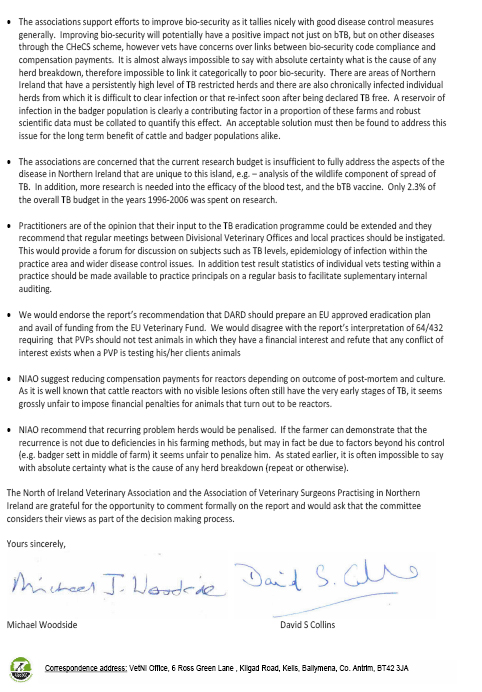
Appendix 4
List of Witnesses who
gave Oral Evidence
to the Committee
List of Witnesses who gave
Oral Evidence to the Committee
1. Dr Malcolm McKibbin, Accounting Officer, Department of Agriculture and Rural Development.
2. Mr Bert Houston, Chief Veterinary Officer, Department of Agriculture and Rural Development.
2. Mrs Colette McMaster, Director, Animal Health and Welfare Division, Department of Agriculture and Rural Development.
3. Mr John Dowdall CB, Comptroller and Auditor General, Northern Ireland Audit Office.
4. Mr David Thomson, Treasury Officer of Accounts, Department of Finance and Personnel.
